Australian
and international
exploratory
performance and
media arts
Nominate for ONE giveaway. Email us at giveaways [at] realtimearts.net with your name, postal address and phone number. Include ‘Giveaway’ and the name of the item in the subject line.
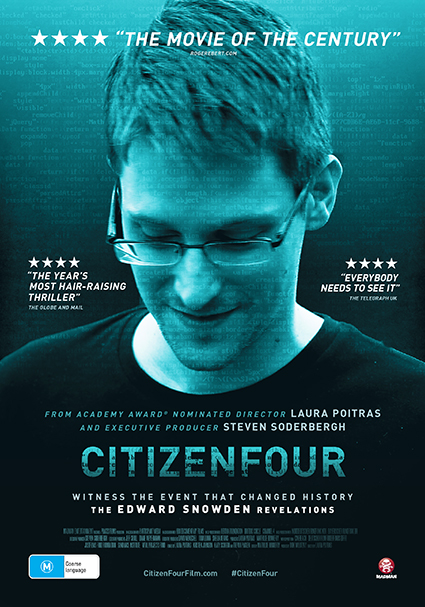 5 Copies of Citizen Four, the breathtaking documentary about Edward Snowden (courtesy of Madman Entertainment).
5 Copies of Citizen Four, the breathtaking documentary about Edward Snowden (courtesy of Madman Entertainment).
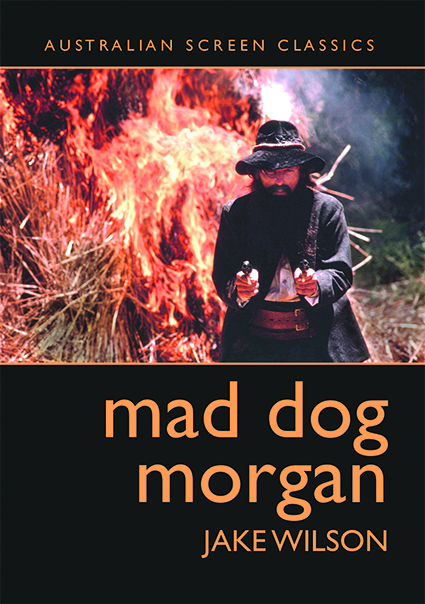 3 copies of Fairfax film reviewer Jake Wilson’s entertaining reassessment of Philippe Mora’s Mad Dog Morgan (courtesy of Currency Press).
3 copies of Fairfax film reviewer Jake Wilson’s entertaining reassessment of Philippe Mora’s Mad Dog Morgan (courtesy of Currency Press).
RealTime issue #128 Aug-Sept 2015 pg. 39
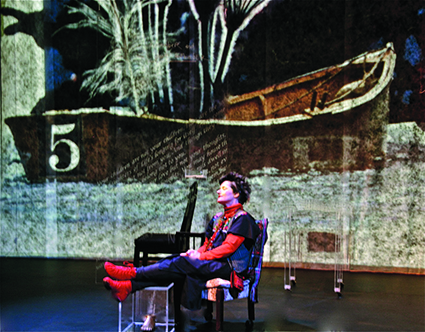
HOME, QTC
photo Bev Jensen
HOME, QTC
In Queensland Theatre Company’s foyer library, we are offered a choice of green or oolong tea and a home-made biscuit before entering Margi Brown Ash’s HOME, which had premiered in La Boite’s Independent season in 2013. This production is the first to use QTC’s intimate new performance space, the refashioned Diane Cilento Studio. The technical direction of Freddy Kromp, the lighting design of Ben Hughes and the visual artistry of Bev Jensen have converted this white box into a hearth, framed by video projections of lace curtains and filled with books, bespoke chairs of various sizes and hanging perspex picture frames adorned with quotes referring to memory, remembrance and the passage of time.
Travis Ash plays a piano score and Brown Ash enters and announces that this is a performance about storytelling—a telling of a version of her life that she will later conclude is underpinned by no assumption of an authentic or ‘real’ self. “I will play my part and dream this potential. I will ask some of you to join me.” She begins with a retelling of her favourite story—a foundational Egyptian myth about Set, Osiris and Isis treating each other appallingly. It is a story, ultimately, about family and betrayal and retribution and love and longing and remembrance. And we are launched into this warm, astounding, deeply idiosyncratic semi-autobiographical and un-pigeonholeable performance piece, swept up in the storytelling as though we are in fact sharing a magic carpet with Scheherazade herself.
The intimate studio space is a perfect home for this theatrical experience, premised as it is on sharing family stories with a complicit audience who are asked to join the performers on stage and substitute for Brown Ash, her mother, her husband and children at various points in their richly matrixed lives. While Brown Ash provides the confessional heart to the piece, composer and son Travis shares interspersing socio-political vignettes that link the family’s personal trajectory to matters of conscience in the outside world—Vietnam War protests, Palestinian resistance, Christmas Island refugee shipwreck survivors. The personal and the political are entwined here. Each of us has our own story and we are all interconnected, the piece seems to be telling us. Every family has its own mythology, and the public exchanging of these intimate revelations constitutes acts of bravery, acts of vulnerability and exposure that remind us how human and eternal we are.
It’s hard to do this entrancing work justice in a short review—the exposure to the way Brown Ash’s brain works (beautifully in tandem with director and long time collaborator Leah Mercer) is a richly rewarding experience. I wanted to share this experience with loved ones—my son, my mother. Margi Brown Ash is something of a state treasure and it is terrific to see experimental, thoughtful, interrogative and elaborately textured work like this sneaking into the QTC ancillary program.
QTC & Force of Circumstance: HOME, writer, performer, devisor Margi Brown Ash, devisor, director Leah Mercer, writer, performer, composer Travis Ash; Diane Cilento Studio, The Greenhouse, Brisbane, 14-25 July
Congratulations to Stephen Carleton on winning the 2015 Griffin Theatre Award for best new play by an Australian playwright, The Turquoise Elephant, an absurdist work depicting the chaos of a future world rapidly succumbing to climate change. Eds
RealTime issue #128 Aug-Sept 2015 pg. 41
© Stephen Carleton; for permission to reproduce apply to realtime@realtimearts.net
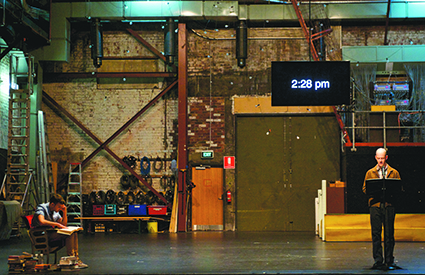
100 Reasons for War, Blue Cow Theatre
photo Tony McKendrick
100 Reasons for War, Blue Cow Theatre
Looking back to late April in Hobart, the summer festivals were over, Dark MOFO lay ahead, yet there was plenty to tempt the cultural connoisseur with a taste for theatre. When I say plenty, I mean three professional shows opening at once, but that’s a big deal here. The amateur theatre scene has dominated for decades, in terms of both the resources it commands and the audiences attracted. Professional theatre, by comparison, has struggled. One of the mainstays has been Terrapin Puppet Theatre, founded in 1981 and still going strong (although the effects of recent Australia Council funding cuts remain to be seen), delivering theatre for family and schools’ audiences. But others have come and gone, with artists segueing into related fields or moving to the mainland in search of that ever-elusive sustainable arts career.
In Launceston Mudlark Theatre has been producing outstanding theatre since the mid 2000s, leading the way in terms of commissioning—including plays by Tasmanian playwrights Carrie McLean, Stephanie Briarwood and Finegan Kruckemeyer. Its activities to foster the independent scene, such as its One Day 24-hour short plays project, are impressive. Their latest is The Possum, written by another local, Sean Monro, which, like many Mudlark shows, engages with the traditions of Tasmanian Gothic.
But what can the three productions in Hobart in April tell us about the character of Tasmanian theatre in 2015? This level of activity is unusual, but with a new company—The Southside Players—coming along with its first show this August, it may be the way of the future.
The Blue Cow Theatre presented 100 Reasons For War, a new play by Tasmanian playwright Tom Holloway, staged in the Theatre Royal with a cast of eight and one of those scripts where lines aren’t allocated to particular characters. Impressively staged by Robert Jarman, it featured the use of a video screen with text to underline story moments, eclectic lighting and intense sound design by Dylan Sheridan. There was an exuberant physicality to the piece, with choreography by Trisha Dunn, including a striking moment with the ensemble on a tilting revolve. Holloway’s script explores Anzac themes in a tangential way, reflecting on violence in the human animal while highlighting ideas around gender. It also references The Black War, a shameful chapter of Tasmanian history, as the conflict that has shaped the Australian national identity far more than the Gallipoli defeat—a provocative idea ripe for further exploration. The response? Audiences either loved or loathed it.
Founded by actor-director Jarman, actor John Xintavelonis and actor-writer Jeff Michel, Blue Cow Theatre launched in 2010 and has staged 10 productions since, with 100 Reasons For War being their third commission. The second appearance of their script development initiative, The Cowshed, in 2015 suggests there will be other original work to come. Whether the next will be in the vein of a Holloway or a Jonathan Biggins (Blue Cow staged his comedy The State of Tasmanian Economy in 2014) is the question.
Tasmanian Theatre Company staged Nassim Soleimanpour’s acclaimed allegory White Rabbit, Red Rabbit. Showcasing a different solo performer each night to preserve its spontaneity, it’s unrehearsed. There’s no director because the actor directs him/herself, or, to be more accurate, the playwright directs through time and space via the sheer power of words on a page (it was written in 2010 as Soleimanpour’s effort to connect with a world outside his restrictive life in Iran). The TTC line-up was diverse, with Hobart-based actors Anne Cordiner, Bryony Geeves, Ryk Goddard, Jane Longhurst, Katie Robertson, Mel King and Guy Hooper as well as Gavin Baskerville, who’s better known as a comedian, and fly-ins Samuel Johnson, Kate Mulvany and Hamish Michael (an expat Tasmanian). I saw it on the night that Jane Longhurst was in the hot seat and it was a powerful experience (although one niggling thought is that for a grassroots activist play it’s a shame that only those with a spare 40 dollars got to experience it).
Tasmanian Theatre Company was founded in 2008 when there hadn’t been a state theatre company for about a decade. It’s taken a while to find an identity for itself, and is perhaps still looking. Having lost state government funding last year, it has a hard road ahead. But it has certainly hit on something, with increasingly innovative approaches to staging, such as a very popular production of Who’s Afraid of Virginia Woolf late last year coinciding with Architecture Week. This took place in a 1960s Modernist house designed by Esmond Dorney and owned by the Hobart City Council. Audiences were ferried to the site at the top of Sandy Bay by mini-bus and compelled to face George and Martha’s shenanigans sitting right inside their living room.
Loud Mouth Theatre presented Theresa Rebeck’s Seminar, an incisive literary comedy that was a Broadway hit a few years ago. Directed by Maeve Mhairi MacGregor it was an entertaining, intelligent and well-designed production, although the script, for all its protestations to the contrary, is yet another take on the notion of ‘genius’ revolving around the male ego. Some fantastically overwrought moments included Jeff Keogh’s strong performance as the aforementioned archetype. This was also my first chance to see the newly built Moonah Arts Centre, with its Performance/Screen Studio offering a flexible new space.
Loud Mouth Theatre is a collaboration between three motivated twenty-somethings, MacGregor, Katie Robertson and Campbell McKenzie (MacGregor and Robertson returned to Tasmania post their training in Sydney). Loud Mouth is the new kid on the block, having launched in May 2014 with a production of David Ives’ Venus in Furs. They’ve achieved a lot in a short time, including a colourful response to Leo Schofield’s comment in an interview this year describing Tasmania as a land where “all the young people leave, and the only ones left are the dregs, the bogans, the third-generation morons” (Sydney Morning Herald, 4 April). MacGregor and co started a Leo’s Bogans campaign on social media profiling high-achieving Tasmanians under 35, of which there can be no better example than the trio themselves.
Leaving aside the fact that all three companies are under-funded and that the definition of professional here may sometimes include profit-share, here were three polished, ambitious productions—one was a new work, one (imported) written by a woman and one directed by a woman. One (imported) was by a ‘non-white’ playwright. One was staged in a pop-up theatre space (Red Rabbit, White Rabbit), one in the Theatre Royal, Australia’s oldest proscenium arch theatre (100 Reasons For War) and one in a brand new arts centre in the northern suburbs (Seminar). So whatever your aesthetic or critical response to the choice of material, there’s no doubt that what these productions represent is significant insofar as they embody a new spirit of experimentation. The experimentation might have been more around audience development and staging than about theatre-making on the deepest level, but nevertheless it’s promising.
But before celebrating, let’s remember that the effects of changes to Australia Council funding are about to bite. Tasmania will be disproportionately affected, because we don’t have any substantially supported theatre at the small to medium company level. The only Tasmanian organisation on the list of protected ‘majors’ is the Tasmanian Symphony Orchestra. On the upside, the so-called MONA effect will continue, with increasing activity around festivals creating opportunities for artists. But as is the case with the film sector in Tasmania, the balance of imported and local work needs to be spot-on if all this is to really build, instead of merely inflating the sector artificially at certain times of the year. Theatre in Tasmania is going through a crucial period of transition—in a climate of upheaval and opportunity perhaps the biggest risk of all would be to play it safe.
RealTime issue #128 Aug-Sept 2015 pg. 42
© Briony Kidd; for permission to reproduce apply to realtime@realtimearts.net
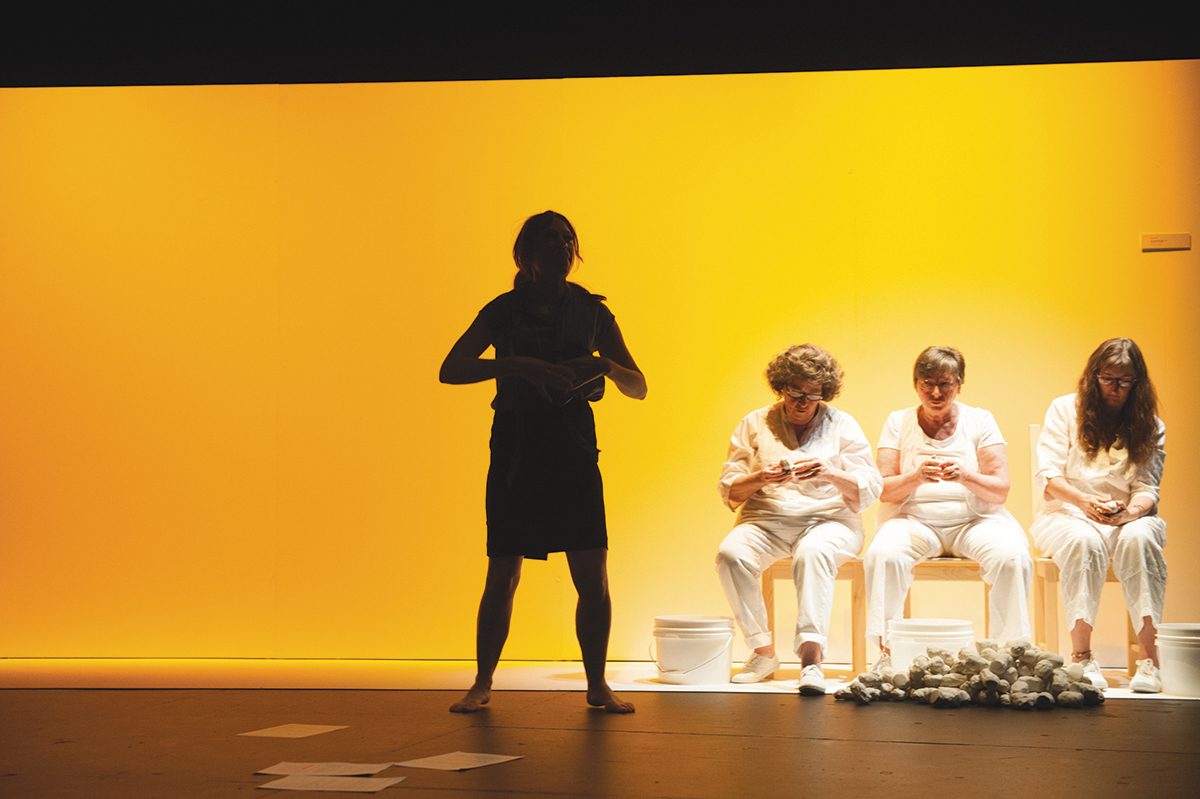
Nicola Gunn, In Spite of Myself, 2013, photo courtesy the artist
Nicola Gunn is a first-person performance artist. Since 2001 she has directed herself, performed herself and revealed herself. Sometimes she even tells the truth. But whether that truth belongs to her lived story or to the story of any number of Nicola Gunns in any number of alternative worlds remains uncertain. I don’t know. I am not Nicola Gunn. She has often talked about her mistrust of language, condemning its failures and inadequacies. Perhaps her inability to write narrative is why she chose performance art, as a kind of shorthand? She tells me, “My mother is a species of cat. She speaks a kind of cat language that not even the cat understands.”
Gunn works in an A5 black spiral notebook. She has a stack of 20, 30 maybe 50 of them in her IKEA Expedit. She uses a special pen in her notebooks: a .3mm black fineliner. People who know her know they must neither touch her notebooks nor use her special pen. “People often ask me when I’m writing in my notebooks, the pen in my hand, does it feel different? The answer is no. It feels like a pen.” She buys big rolls of newsprint, fills them with ideas and themes and then folds them up and puts them in a corner and doesn’t look at them again. She gets in a studio and generally spends three weeks in foetal position. She tells the girls in the waxing salon that she’s a graphic designer: “It’s difficult explaining to someone what you do when they’re looking at your arsehole.”
A woman of strong social ethics, yet very few personal morals, Gunn’s acclaimed body of work has always explored the role intimacy plays in geosituationalism. (I will discuss concepts of geosituationalism later on in this article.) And yet, pressed to define what she’s interested in, what she does and how she positions herself, she is enigmatically ambiguous: “I don’t know what I do or what I’m interested in.” The program notes to In Spite of Myself, her acclaimed work from 2013, offer some clues: “I spend a lot of time writing emails to community groups looking for old people. Last week I got in touch with Mary from the North Carlton Neighbourhood House and I told her I needed some old people for this show. She said, “What kind of show?” I said, “A show in a big theatre.” She asked me what was it about. I said invisibility, absence, irrelevance, the exploitation of marginalised sectors. She said old people don’t like going into the city at night. I said, have you asked them? She said leave it with me. At that point I realised I would not hear from her again.”
Further on, Gunn writes: “I’m concerned with social structures. I feel very strongly about working with real people and community groups, marginalised people and diverse demographics.” I’m not actually sure that is true. She has told me on numerous occasions that it was really really really really really really really really annoying getting the old women to commit and even more frustrating trying to schedule them because they never had their mobile phones on. She complained that they had their own logic for doing things that was totally out of step with the rest of the world. Like having mobile phones but not turning them on. Incidentally, old people do go out at night. I’ve seen them. They look like the visual representation of confusion.
By inviting the public into the act, Gunn is interested in subverting the economics of performance, where youth and celebrity determine interest. Her seminal 2012 work, Disappointment Mountain, continued the theme of cultural democracy evidenced in earlier pieces, such as Nicola Gunn Naps for Your Pleasure, in which an anonymous collector paid an undisclosed amount of money to have Gunn nap in their presence. Based on the success of the original performance, public demand to see the work and her commitment to dismantling the monetary emphasis throughout the performance art industry, she has repeated the event in various venues and continues to perform it regularly. (I was fortunate enough to see an impromptu performance myself during this interview.)
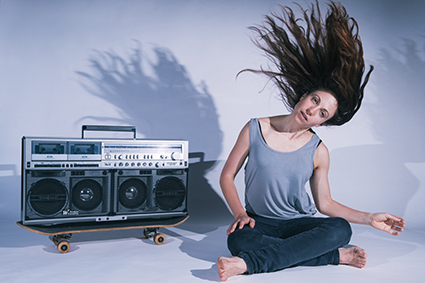
Nicola Gunn, Piece for Person and Ghetto Blaster
photo Sarah Walker
Nicola Gunn, Piece for Person and Ghetto Blaster
However, in Disappointment Mountain the audience is encouraged to make the work. The audience makes the art! It’s really exciting. The audience is content! Audience participants were encouraged to bring an object that represented a way in which they were unhappy in their life, or alternatively to create an unsatisfactory artwork and add it to the pile. They were then invited to take part in a one-off ceremony celebrating their dissatisfaction with the work. In this manner the artist reclaimed the theatre as a place where we form a temporary community and were inevitably let down by the experience.
Nicola Gunn says she hasn’t really thought about kids because she’s too busy. November will see her touring to Adelaide with a new work called Piece for Person and Ghetto Blaster. Except she didn’t get all the funding, so she might just call it Piece for Ghetto Blaster. She recalls how an ex-boyfriend once told her watching her make theatre is like seeing how sausages are made.
She describes the motivation behind I’m So Happy, the single-channel video work commissioned by Arts Centre Melbourne to activate its public spaces: “One morning, I was telling my flatmate about the Arts Centre and I realised what an aggressively inflexible building it was. As I was making my lunch for the day, I discovered a bunch of limp celery in the fridge. I didn’t think too much about it.”
Feeling that success might dull the critical edge of her work, Gunn continues to have a vexed relationship with the economics of the art world, an acknowledged ambivalence that has only become more felt as the artist increasingly receives commissions and financial support from major institutions. When you operate in the established system, somehow you have to maintain your ethics, integrity and most importantly, independence. Otherwise you face the threat of irrelevance. You’ll see it out the window and you’ll wonder if it’s lost but then you realise, no, no, it’s looking for a number. And then you realise it’s looking for your number and then you hear a knock on the door. “Success has in-built limitations,” she says. Coincidentally, this is what my change and transformation coach advised me this morning over coffee. (God knows my expectations have not been met.)
Gunn says she doesn’t plan what she is going to make next. To do so would be an exercise in hopelessness. She says it just comes, or it doesn’t. “I have to go through a kind of transformation or emptying in order for the idea to come. It can be very difficult and painful. It is rarely joyful. It can take a very long time, much to the frustration of my collaborators. I just know it will come because it must. I only ever work to deadline.”
Pressed to offer some kind of insight into this foray into the many worlds of Nicola Gunn, I find myself participating in what she has perceptively termed an exercise in hopelessness. ‘Hopeless’ because all writing, all thinking, all talking about performance that tries to capture its slippery character is a hopeless endeavour. And yet, I am hopeful that this attempt at a critical dialogue with one of the great mythmakers of the present will offer one more disappointment to celebrate at its end. Please allow me to add this to the pile with my sincere well wishes.
–
Nicola Gunn/SANS HOTEL, Piece for Person and Ghetto Blaster, Arts House, Melbourne, 11-15 Nov
Nicola Gunn is a performance artist, writer, director and dramaturg. She uses performance to reflect critically on its place in theatres, to examine power relations in existing organisations and to consider the relevance and social function of art itself. In August she premieres A Social Service at the Malthouse Theatre, a work set on a public housing estate. Her Piece for Person and Ghetto Blaster, commissioned by Mobile States and presented by Arts House, is described as “the story of a man, a woman and a duck…It is an attempt to navigate the complexities of trying to become a better person” (press release).
RealTime issue #128 Aug-Sept 2015 pg. 44
© Susan Becker; for permission to reproduce apply to realtime@realtimearts.net
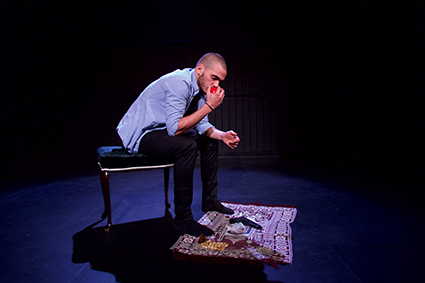
Once We Were Kings
photo Mustafa Al Mahdi
Once We Were Kings
Pride shines through in intimate tales of love, loss, rejection and steadfast memory. Once We Were Kings presents a collection of richly evocative vignettes of life as experienced by gay Muslim immigrants to Australia. The fluent beauty of the language is a tribute, a call to bear witness and a seized opportunity to share stories.
Self-discovery takes many routes in these overlapping monologues, with specific details catching the heart and imagination—letters hidden in a pot plant, furtive holding of fingers under a pizza box (from the halal place) and the last memory of a grandfather. Common themes abound: rejection by fellow believers, rejection by lovers, loss of cultural identity with migration and loss of family connections. This small cluster of shared life experiences is marked by its acceptance of a diversity of voices. No single authoritative narrative dominates this sub-sub-culture, its commonality based in the suffering of social rejection and denial of personal validity.
Cashews and pomegranates—motifs of sweet and sour, pride and heritage—evoke memories flowing through more tangible recollections of regret and loss. Delivered direct to the audience in a stylised manner, the vignettes combine angst, nostalgia, anger, bitterness and humour. Concealing identifying details, names of people and places, dates and events beyond the confronting immediacy of the personal moments shared here, the stories’ contributors reveal the raw nature of their truths, still stinging nerves not yet ready for the bracing air of public scrutiny.
Three young actors, Angela Mahlatjie, Solayman Belmihoub and Naomi Denny, deliver demanding material clearly, without hesitation. The stylised manner of presentation removes some dramatic opportunities, but their delivery echoes the detachment necessary to survive some of the situations and frustrations. Director Mustafa Al Mahdi guides his cast to connect with the audience through a kaleidoscopic selection of abstractly styled, intimate moments—a challenge met with understated dramatic skill by the performers.
Using deceptively simple staging, Al Mahdi sacrifices potential dramatic vigour in favour of creating a visually arresting stage-scape. Dim lighting loses some details but conveys strong impressions, each performer’s body becoming part of the scenery, moving simply and deliberately. This overall stillness lends clarity to words, giving Dure Khan’s beautifully written free verse-script room to breathe, the strong, static stances impacting profoundly.
Thoughtfully composed projections enhance the sensation of large-scale installation with red drops pooling on a performer’s white gown, the recollection of a voice intermingled with water burbling from a corner and dimly traced dancers flickering on the wall—echoing the dim reminiscence of a first teen crush. The soundscape’s intense, rapid rhythms complement the pace of speech in some pieces with a pounding beat and amplify the angst in others with edge-of-awarness humming.
Khan’s richly lyrical script captures the difficulties of becoming a Crescent Moon-shaped peg in a Southern Cross-shaped hole and resolutely challenges norms of mainstream Australian society, the taboos of Islam and narrative expectations. Walking through the accompanying exhibition provides space for reflection and a continuing sensation of intimate and personal experience with childhood photos of the actors scattered through a pile of suitcases and belongings that evoke individual histories amid more abstract sculpture and photography.
Third Culture Kids have a voice, insistent to be heard. Once We Were Kings is a showcase of defiant pride, exploring artistic possibilities that challenge cultural and social expectations. Simply being part of the audience feels like witnessing a creative movement establish its own space in modern Australia.
Third Culture Kids and The Blue Room Theatre, Once We Were Kings, director, producer Mustafa Al Mahdi, writer Dure Khan, co-director Alex Kannis, lighting Devon Lovelady, sound design Thomas Moore, cinematographer Lincoln Russell, The Blue Room Theatre, Perth, 12-29 May
RealTime issue #128 Aug-Sept 2015 pg. 45
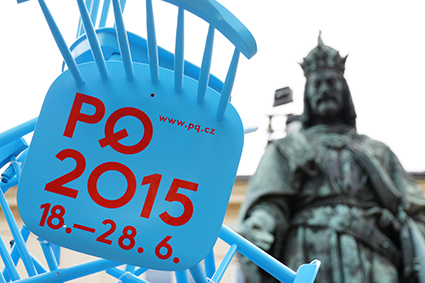
PQ Sign
photo Carlos Gomes
PQ Sign
Katia Molino and I navigate the flood of tourists in Prague, looking for the ‘blue chair’—the logo for the 13th Prague Quadrennial of Performance Design and Space 2015. PQ is the oldest symposium of its type. In the program, Artistic Director Sodja Lotker states, “PQ explores scenography as a strong and invisible force of performance; a power that influences us just like music, weather and politics.” This year PQ broke the record for participation, with more than 90 countries represented.
The program is organised by a diversity of curators and events divided into the categories Tribes, Makers, Workshops, Talks, Objects, Performance, Show and Tell, Sound Kitchen, Countries and Regions. Katia and I represented Sydney’s Theatre Kantanka. We were invited to participate in the Tribes program, with costume art from Bargain Garden, Kantanka’s performance-collaboration with Ensemble Offspring. I also gave a talk about our process for making this show.
I’ll focus on Countries and Regions, where curators for individual countries were invited to explore the theme Shared Space: Music, Weather, Politics. With exhibits housed in a variety of buildings, normal geographical relationships were ignored: Estonia was next to China, Russia and Uruguay shared the same room. There was a sense of pleasurable chaos as we wandered around exhibits amid grand Czech architecture. On show were maquettes, LED displays and multimedia images and at times designs were transformed into surprising concepts.
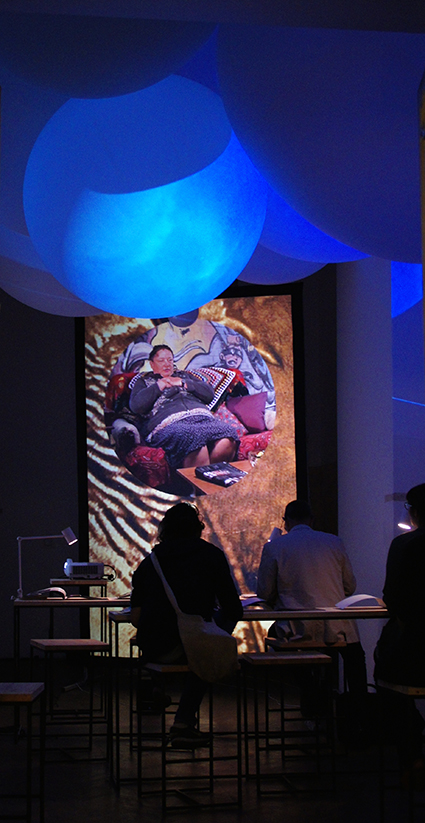
Australian Exhibit A-Mass
photo Carlos Gomes
Australian Exhibit A-Mass
A-MASS, Australia
Climbing the stairs inside the exuberant Colloredo Mansfeld Palace, you gaze upon white clouds made of helium weather balloons floating on the ceiling. Images of the Australian sky (collected by the curator and designer of the Australian program, AnnaTregloan) are projected onto the balloons. Lured in, spectators are treated to a panorama of diverse works projected onto a large screen. The exhibit includes multi-media presentations, interactive sites and live events. The works have, as a common element, a participatory aspect to their performance structure: The Democratic Set (Back to Back Theatre), Resist (PVI), Yawn (Renae Shadler), Whelping Box (Branch Nebula, Clare Britton, Matt Prest), The Home Project (NORPA), The Shadow King (Malthouse Theatre), Super Critical Mass (Julian Day, Luke Jaaniste, Janet McKay).
Five Short Blasts by Madeleine Flynn and Tim Humphrey, was originally created for the Yarra River in Melbourne. This elegant work was transferred to the Vltavu River in Prague where the makers collaborated with local Czech artists, including original interviews and text by Pavel Brycz and Tony Birch. We gathered early in the morning and boarded a rowing boat. Gliding down the river, we listened to composed sound as it blended with live music from the shore and the sounds of the waking city. This experience, with a surprise cup of tea and Anzac biscuit, was a delicious pay-off for having woken up at 5am to get a place on the journey.

M. Flynn, T. Humphrey, Five Short Blasts
photo Carlos Gomes
M. Flynn, T. Humphrey, Five Short Blasts
Theatre NO99, Unified Estonia
Entering a bright vanilla and beige room, you notice political posters and a party logo draped on the wall. As we step onto the shagpile carpet of a ‘stylish’ political party office, Estonia’s Theatre NO99 greets visitors and promotes their “How to take Power?” franchise (designed and directed by Ene-Liis Semper and Tiit Ojasoo): “Power is just lying there on the ground. Pick it up and make it your own.”
In 2010, NO99 created a fictional populist political party and convinced the nation that it would run for the national elections. The 44-day campaign was ‘reality theatre’ taking various forms—live appearances, media interviews, public interventions. Media interest in the ‘party’ sky-rocketed. The final performance was a ‘party convention’ attended by 7,500 people inflamed with nationalistic fervour—this despite NO99 openly saying their convention was a theatrical performance. NO99 attracted 25% of public support for their party in polls.
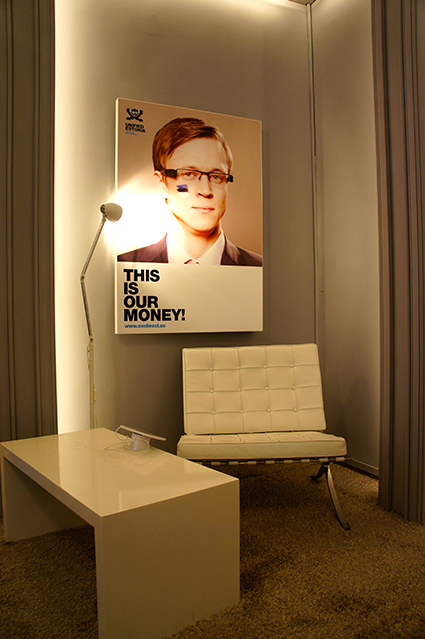
Estonia Exhibit, Unified Estonia
photo Carlos Gomes
Estonia Exhibit, Unified Estonia
The company had studied the techniques of political manipulation, copying the mechanisms of real politicians and applying them to their creation. At PQ, NO99 presented the results of their interventions: posters, videos and a ‘how-to’ guide to taking political power. This was clever, witty, humorous and ultimately frightening work. It is no surprise that Estonia won the Golden Triga for the best exposition—PQ’s top prize. [For excerpts of the subtitled performance see this and related links].
Post-Apocalypsis, Poland
Poland’s exhibit was the atmospheric interdisciplinary work, Post-Apocalypsis, curated by Jerzy Gurawski with a team of composers and designers. The installation consisted of several lopped tree-trunks supported by metal rods, creating a strange, decapitated forest.
Weather data was streamed into the space from locations on Earth where energy-related disasters have occurred, as in Fukushima and Chernobyl. This data was transformed into a soundscape for the installation and could be manipulated by the visitors. Also inserted into the trunks of the trees were sound devices. Pressing your forehead on these, classic Polish poetry reverberated in your skull. You were invited to reflect upon the relationship between nature, and technology—combining human and non-human elements to create a unique eco-system. Post-Apocalypsis won the PQ Gold Medal for Sound Design.
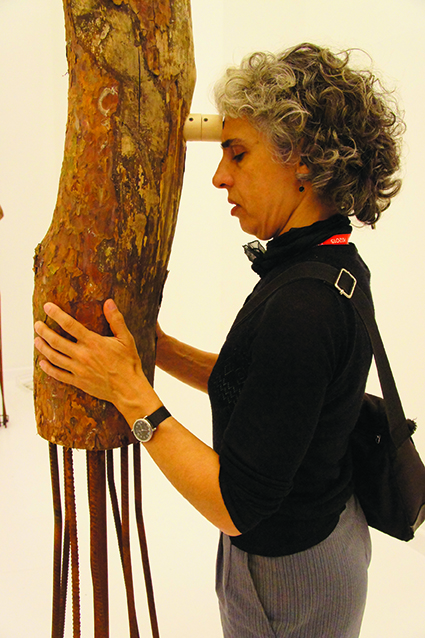
Post-Apocalypsis, Poland exhibit with Katia Molino
photo Carlos Gomes
Post-Apocalypsis, Poland exhibit with Katia Molino
Between Realities, Netherlands
The Netherlands chose to locate its PQ entry, Between Realities (www.betweenrealities.nl), in a corridor between the exhibition spaces of other countries and a toilet. This interactive publishing room shared information about public interventions that its artists and designers were instigating in Prague with selfie-spots, images of the suburbs brought into the city, white blobs filling alleyways, cardboard waste sculpting and undercover games, collective mapping using apps to track the movements of certain kinds of people. Daily ‘instant magazines’ uncovered the multi-layered realities and functions of public spaces in the city, suggesting how to participate in new realities. Printers were running hot, producing reports of findings while raising questions about the new realities of public spaces created by the artists. This was impressive teamwork involving a large number of artists—and surely well funded.
PQ 2015 Artistic Director Sodja Lotker and her curators made it possible for artists to create spaces in Prague for rich, diverse and inclusive cultural experiences while questioning the responsibility of scenography in the process. It will echo with us for a long while and deserves a visit next time.
PQ 2015, 13th Prague Quadrennial of Performance Design and Space, Prague, 18-28 June; PQAU was an initiative of the IETM-Australia Council for the Arts Collaboration Project with support from Arts Victoria.
RealTime issue #128 Aug-Sept 2015 pg. 46
© Carlos Gomes & Katia Molino; for permission to reproduce apply to realtime@realtimearts.net
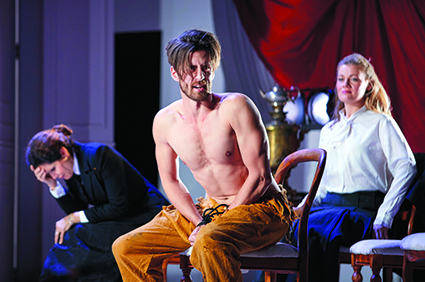
Bajazet
photo Keith Saunders
Bajazet
Vivaldi’s Bajazet is an opera you might be lucky to see staged once in your lifetime and there’s only one complete CD recording to date, but in the Pinchgut Opera production director Thomas de Mallet Burgess has radically changed the tenor of its ending to suit our own graceless times. Vivaldi’s ending is typically Baroque—after the playing out of jealousies, betrayal and violence, forgiveness and beneficence rule. For artists of the Baroque such endings weren’t simply feel-good clichés but reflections of belief and wariness of offending rulers in strictly monarchical cultures.
Not surprisingly then, 17th and 18th century English writers changed the endings (and more) of Shakespeare’s tragedies—most famously Nahum Tate, 1681, saves Lear and Cordelia marries Edgar. Adaptation is just as rampant today, with varying degrees of sensitivity. In Benedict Andrews’ Measure for Measure at Belvoir (2010), Isabella, about to be married to the Duke in a final tableau, steps outside the production’s video frame and runs for her life into the audience. The play, in the Andrews manner, is otherwise left pretty much intact unlike, say, Barrie Kosky’s radical rewrite of Lear for Bell Shakespeare in 1998 with evil absolutely triumphant. I welcome adaptations of classics—they’re well-known and we can respond to the intellectual challenges of directorial conceits. For lesser or barely known works ‘adaptation’ seems pointless. (I liked Thyestes [Belvoir, 2012], but what was it an adaptation of? Something far removed from the little known play by Seneca the Younger.)
Pinchgut’s Bajazet is faithful to the tenor of the libretto almost to the end, when Astrea, daughter of the defeated Turkish emperor Bajazet, and the Greek prince Andronicus, lovers hitherto under threat of violent deaths, are handed Greece and marriage by a suddenly benign Tamerlano. As everyone around them celebrates in glorious chorus, Astrea and Andronicus take poison, presumably unconvinced that the unpredictable Tamerlano’s beneficence is likely to be enduring. It’s an ending at once disturbing and irritatingly out of kilter with the strength of character revealed in the couple, particularly Astrea. Instead of fatalism the director might have opted for just as fanciful defiance with Astrea poisoning Tamerlano (the actual Timur was pretty much at the end of his nasty career). Who wants ISIS to win out over its courageous opposition?
I should have seen the ending coming. Looking pretty much like any number of Baroque opera productions of recent decades, this Bajazet is historically displaced, from 15th to 19th century, and given a quasi-Victorian look, the men in white and cream riding outfits, the women in (not very full) skirts, the simple set comprising a huge white bookcase on one side and an equally large double door opposite, both white. Furniture and statuary are scattered about and a high, wide red curtain hangs at an angle at the back—signs of pillage after conquest. There are oddities: Bajazet dressed in traditional Turkish attire, Tamerlano in European whites, not at all the Tartar, save the swagger.
However in Act II, the shelving has been cleared of books, the trophies of war displayed and Tamerlano, about to take action, dons Arabic head-dress and shortly appears entirely ISIS-like in black to condemn Astrea to rape and death by a mob. It’s a slow reveal of the extent of Tamerlano’s destructive vision from which Astrea and Andronicus feel they can never escape and therefore opt for death. The man they initially meet is not just another well-dressed conqueror. It’s not an altogether convincing logic. I would have preferred some consistency in costuming and an overall sense of clarity of purpose from the start as seen, for example, in Peter Sellars’ production of Handel’s Theodora—the conceit of the Texas capital punishment death machine is laid over the Roman persecution of Christians and immaculately realised, aesthetically and politically. (Theodora is scheduled for production by Pinchgut in 2016.)
Just what’s to be gained by setting Bajazet in the 19th century is never made clear. There are also plenty of distractions: Grand Guignol skeletons—Tamerlano’s victims—leaning in to watch from the balconies; too much dragging in, out and about of furniture by busy supernumeraries; a stuttering raising of the red curtain mid-aria in Act 1; and the sudden silhouetting and then tight spotlighting of singers as they hit the high notes of their arias—as if the singing could not carry the day.
Despite its conceptual and design flaws Bajazet nonetheless shone because of superb singing, acting, musical direction and period instrument playing. It’s to the credit of director de Mallet Burgess, conductor Erin Helyard and all the singers that the performances were so finely tuned, emotions clearly expressed and the oscillations between the private and public selves of the characters so well delineated. Despite the sprawl of the narrative and the too busy staging, the production dwelled intently on each moment while building tension towards a frightening conclusion, if one made fatalistically grim.
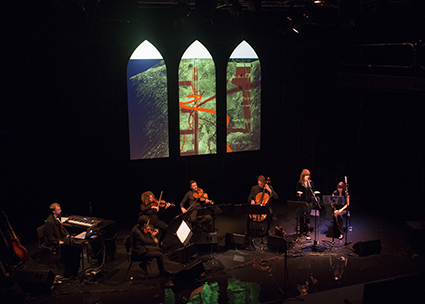
Orpheus Song, (L-R) David Trumpmanis, Ewan Foster, Stephanie Zarka, James Eccles, Geoffrey Gartner, Andrée Greenwell and Julia County
photo Matthew Duchesne, Milk and Honey Photography
Orpheus Song, (L-R) David Trumpmanis, Ewan Foster, Stephanie Zarka, James Eccles, Geoffrey Gartner, Andrée Greenwell and Julia County
Andrée Greenwell, Gothic
Since the late 18th century, the Gothic has never passed its use-by date, periodically rising wraith-like from the depths of the collective unconscious as high art, pulp fiction, fashion and youth sub-culture and nowadays overpopulated with vampires, werewolves, zombies and the common or garden ‘returned’ (see review of Glitch). One of the few practising stalwarts of Australian music theatre that is neither opera nor musical theatre, the ever-inventive Andrée Greenwell, premiered her Gothic during Sydney’s Vivid Festival. Hers is a quieter, subtler take on the genre than most, but still blessed with eeriness and occasional horror.
Gothic is a seamless theatricalised concert, its background three tall church windows (design Neil Simpson) which become screens for digital (and psychological) projections by London-based Australian media artist Michaela French. In the foreground is an ensemble of instrumentalists and two singers—Greenwell herself, often delicately ethereal, and Julia County, a soprano with a daunting range and enveloping delivery. I’ve limited myself to the songs and imagery which I thought represented the best of the concert.
In her folk/classical setting of Edgar Allen Poe’s Annabel Lee, Greenwell’s voice intertwines with violin as the land and seascape of “the sepulchre/in this kingdom by the sea” mysteriously mutates, the animation ‘panning’ from a small house on an island to a distant city to the accompanying lap of ocean waves as the teller “lies down by the side/of my darling…In her tomb by the sounding sea.” The Cure’s gothic rock “A Forest” (1980), one of the more frightening of the program’s songs, opens with the sounds of a child’s voice, crickets and “Where are you?” cries, conjoined with ghostly black and white etchings rhizomatically transforming into forest branches and shafts of light which seem to propel the accompanying strings.
Another lost soul—a child in the throes of being snatched away by a supernatural force —is the subject of Greenwell’s pulsing string quartet arrangement of Schubert’s The Erlking. Soprano and cello entrancingly share the melody while images of children in 19th century apparel appear and fade before the many windows of big city buildings—as if still with us as ghosts in our own century. Another lost to powers beyond the human is felt in poet Alison Croggon and Greenwell’s haunting The Orpheus Song, the composer adding the sound of responses to the 2011 Joplin Tornado in Missouri, USA as it struck, recorded on an iPad. A red line spreads and threads its way across the windows—a red path of destruction? Chosen Words by writer Maryanne Lynch and Greenwell is one of the strongest of Gothic’s compositions with its account of a woman kept in her grandfather’s cellar for 19 years. Greenwell and County vividly voice the sense of threat and the yearning for escape while a series of images of suburban houses flicker by, evoking a domestic banality of evil.
Gothic climaxed with Poe’s “The Bells,” the instrumentation resonating with the animations of huge bell mouths swinging towards us and then being rendered abstract, taking us with them into oblivion. Angelo Badalamenti’s Twin Peaks theme, “Falling” (1990), provided an apt coda to Gothic, a solo guitar arrangement with electronics for a composition as enticing as it is disturbing—which is the uneasy charm of the Gothic. Greenwell’s curation, composing and arranging made for a fascinating program not least in the engagement between live music and media art.
Pinchgut Opera, Bajazet, composer Antonio Vivaldi; City Recital Hall, Sydney, 4-8 July; Gothic, artistic director Andrée Greenwell, electronic processing David Trumpanis, Vivid, Seymour Centre, May 28-30
RealTime issue #128 Aug-Sept 2015 pg. 47
© Keith Gallasch; for permission to reproduce apply to realtime@realtimearts.net
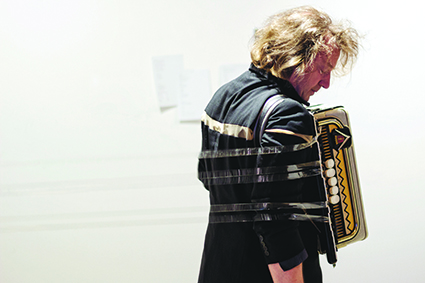
Johannes S Sistermanns, Decibel Installation
photo Holly Jade
Johannes S Sistermanns, Decibel Installation
Coinciding with the soft launch of the Western Australian New Music Archive, the 12th Totally Huge New Music Festival unearthed gems from local, national and international musical milieus. Detailed reviews of these works by myself and mentored writers Alex Turley and Laura Halligan can be found on the Features page.
Festival Symposium
Attendees at the festival symposium were treated to accounts of Western Australia’s rich history of contemporary music-making, from the Noize Machin experimental warehouse nights to snapshots of composers, ensembles and the state’s contributions to contemporary percussion. The WANMA soft launch was an opportunity to reflect upon how best to capture the truly momentous amount of musical activity in Western Australia over the years. According to the project’s founder Cat Hope, the archive will eventually act as a curated repository for existing images, videos and information as well as cater for the increasing live performance documentation being produced every day.
The archiving of software involved in live performance was a recurring theme throughout the day, with no easy solution in sight. The ABC’s Stephen Adams remarked that a functional description of what a piece of software does may be more valuable than the original code in the long term. All the more reason to maintain a critical, written record of musical performances such as one finds in, say, RealTime. The day was rounded off with a beautifully sparse performance by Ross Bolleter on one of his famous ruined pianos.
Amour-Soundbridge
The cellist Friedrich Gauwerky’s Amour-Soundbridge program explored musical ties between Australia and Germany. Gauwerky himself embodies these ties, having lectured in cello, chamber music and New Music at the Elder Conservatorium in Adelaide, 1989–96. He also performed as principal cellist in the Australian ensemble Elision 1990–97. Gauwerky contrasted music by German luminaries Stockhausen, Henze and Hindemith with stunning works by composers of German origin who have lived and worked in Australia, including Thomas Reiner, Felix Werder and Volker Heyn. The concert showed that the distance between ‘historical’ European culture and contemporary Australian culture is not so great—just one or two generations, a teacher’s legacy, or a couple of boat trips.
Space/Pli
Johannes Sistermanns’ installation performance with the Decibel ensemble Space/Pli provided yet another German-Australian connection. In Sistermanns’ installation, hundreds of metres of clingfilm partitioned the PS Art Space in Fremantle, the translucent film forming walls between the building’s pylons. Diagonal strips intersected the walls, striking down from ceiling to floor. Clingfilm has marvellous sonic properties, especially when paired with piezo transducers. The tiny vibrating discs were placed inside the folds of plastic, causing the rippling walls to buzz and shimmer. Decibel performed a graphic score by Sistermanns while spaced around the room. Their view of the score and each other was distorted by the film, introducing unexpected coincidences and affinities in the ensemble.
Club Zho
Tura New Music’s Club Zho program presents new music and sound art in a semi-formal environment, this time invading Jimmy’s Bar in Perth for a concert of escalating volume. Bass clarinettist Lindsay Vickery and percussionist Darren Moore performed as the duo Hedkikr. Despite the name, the duo are these days a picture of refinement and grace, crafting focused sonic duets of extended percussion and clarinet technique. Bassist Cat Hope and Vickery then defied all expectations of a polite classical duo. Performing under the moniker Candied Limbs, their 20-odd minute set was an explosion of irrepressible energy, featuring some truly unearthly screaming. Singapore-based modular synthesis duo Black Zenith (Darren Moore and Brian O’Reilly) conjured a staggering array of sounds and textures from their rats-nests of patch cables for the concert’s finale.
Zubin Kanga
I was fortunate enough to hear Kanga repeat the Dark Twin program at the Art Gallery of Western Australia two weeks after hearing it at the Metropolis New Music Festival in Melbourne. The electronic and live parts of Julian Day’s work Dark Twin were much more distinct under the soaring gallery atrium. Kanga’s interpretation of Hope’s score seemed much more fluid, like a Debussy Prelude flowing across the different registers of the piano. Hope’s EBows and radios also spoke louder than before. I don’t know whether these changes were brought about by Kanga’s gradual refinement of the pieces over time, my second listening or whether the composers altered the works themselves.
The Perth Institute of Contemporary Arts hosted two festival highlight concerts. The Breaking Out young composers’ night provided an excellent opportunity for Western Australia’s most promising young composers to test out new ideas. It was encouraging to see the level of mutual support between the young performers and composers as well as hearing the command with which the composers wielded their diverse musical styles. PICA also hosted the Melbourne-based vocal artist Alice Hui-Sheng Chang, who led Perth’s own iMprovisation Collective in a performance around PICA’s black box space before performing a solo concert in the venue’s dedicated concert venue.
Time Alone
Beginning shortly after the announcement of George Brandis’ cuts to the Australia Council for the Arts, the festival was peppered with the performers’ impassioned calls to action. The final concert, Time Alone, was no exception, featuring a stirring speech by Claire Edwardes. The concert was an eclectic tour de force for the percussionists Edwardes and Louise Devenish and the clarinettist Ashley Smith. With a well-known work by Ligeti next to works by Australian composers Michael Smetanin and Chris Tonkin, the concert captured the local-yet-international, looking-backwards-looking-forwards feel of the festival.
TURA New Music: Totally Huge New Music Festival, Perth & Fremantle 15-24 May
RealTime issue #128 Aug-Sept 2015 pg. 48
© Matthew Lorenzon; for permission to reproduce apply to realtime@realtimearts.net
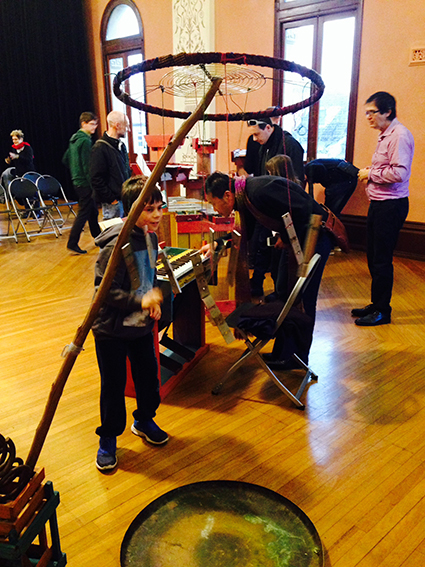
Common Eclectic, Clocks and Clouds
photo Felicity Clark
Common Eclectic, Clocks and Clouds
In one of nine Common Eclectic concerts staged by independent music promoter Places and Spaces in the refurbished Glebe Town Hall, Clocks and Clouds (Kraig Grady and Terumi Narushima) explored the sonic combinations available when an historic and now sound-proofed ballroom, metal bars and a homemade foot-pedalled organ meet. The instruments appear deliberately positioned to maximise resonance and audience interplay, the performance not so much ‘a work’ or series of pieces as a collection of structured soundscapes. My sticky-beak at their scores before the show revealed some written conventionally, albeit in shorthand, and others looking like pictograms and alphabetical pentograms. The music is theirs alone, in a language they have devised to facilitate experimentation in, and reaction to, their environment.
Grady only composes for instruments he himself has built, exploring ancient sacred scales, pure harmonic tuning and multidimensional geometries. Clocks and Clouds introduce us to a tree made of dangling metal chimes, a microtonally-tuned vibraphone and a set of seven bass Meru Bars that look like a plumber’s sculpture garden and sound as a glockenspiel must to a hummingbird. The music emanating from whooming, echoing bars—hung by elastic above vertical freestanding PVC resonators—induces a dull aching, if pleasurable vibration behind the eyes. Together with Narushima’s retuned and redesigned Meta-slendro Harmonium—a small foot-fanned keyboard instrument washed in pink and yellow paint—they interweave driving rhythms similar to relentless Thai court music or wind-chimes in a cyclone. The effect is glimmering and ephemeral—each vibraphone sound decaying so quickly that for the interplay of dissonances and aural-adjustments to take place, the pair must change pitches and rearticulate often. Pure harmonics glisten and bounce.
Grady knows his instruments inside out and uses their idiosyncrasies, particularly their harmonic interplay, to advantage. What’s special about this music is that while it is clearly mathematically and scientifically conceived, behind these calculations is a quest for aesthetic beauties and new frontiers of sonic sensation—it’s about the concept of perception before the abstractions and material manipulations that afford such perceptions come into play. The ways vibrations might feel are more important that the means by which they are harnessed. So while Grady and Narushima’s music looks and sounds very technical, pattern-laden and designed, its form is subordinate to the sensations it elicits—cloudy crepuscular impressions.
Though lyrical, Clocks and Clouds’ music had no words; Grady prefers listeners to infer what they will. Vocalist Karen Cummings of the duo A Body of Water says, “I look at the words first when I think about music, and am really interested in the intersection between ideas, music and politics. I want to perform music that speaks strongly to the world now.” She and Stephen Adams explored songs in many styles. They shared their passion for the intimacy and fragility of a song recital, “imagined as an exploration of the inner life through words, vocal resonance and breath” (program note). A Body of Water performed original compositions and re-workings of familiar tunes in unfamiliar guises. While Adams tinkered with mandolin, flute, piano, field recordings and electronic gadgets, Cummings’ soprano soared, her cross-genre specialisation and song-choices playing to her vocal strengths. She is an expert in cabaret song and is currently researching the impact of amplification on the performance of vocal repertoire.
Common Eclectic#6: Clocks and Clouds, musicians Kraig Grady, Terumi Narushima; A Body of Water, performers Karen Cummings, Stephen Adams; Glebe Town Hall, Sydney, 21 June
RealTime issue #128 Aug-Sept 2015 pg. 49
© Felicity Clark; for permission to reproduce apply to realtime@realtimearts.net
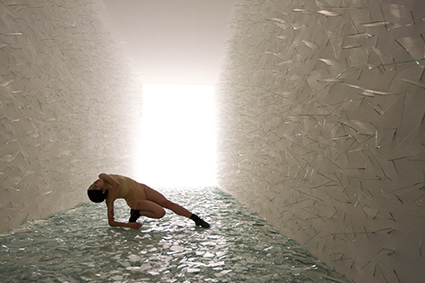
Rihoko Sato, Broken Lights, Saburo Teshigawara, multimedia installation
photo courtesy Carriageworks
Rihoko Sato, Broken Lights, Saburo Teshigawara, multimedia installation
Carriageworks’ 24 Frames Per Second is immediately immersive. The foyer portal to this monumental exhibition of dance and visual art collaborations places the viewer between two huge screens on which football fans coalesce into swaying masses or lock arms and glide in a sideways dance at speed in Khaled Sabsabi’s Organized Confusion. They chant, sing, raise fists and strip off their tops at the urging of a muscular shaven headed leader—just another man in the crowd standing on a fence. The rhythms of sound and movement are mesmeric, although a sense of the restless power of the largely male crowd disrupts reverie in this record of crowd loyalty for its team, the Western Sydney Wanderers.
For all their activity, the fans are largely expressionless as they await play. For Sabsabi, their state is akin to trance. Bridging the screens with a series of engrossing near-still, black and white video portraits of Indonesian trance dancer Agung Gunawan, he creates a telling juxtaposition. Nearby, Brian Fuata’s mysterious Apparitional Charlatan…evokes in graphics, text and image fragmented memories from dance archives and of an empty, once-shared studio.
These three works prepare the visitor for the diversity of works that lie ahead in a vast, dark space lit only by the glimmer of screens near and far, lining walls and, in the centre, inhabiting an intimate labyrinth. The great space largely allows works to speak for themselves without interruption while occasional seating offers opportunities for restful reflection and earphones greater intimacy. The installation is a wonder, offering moments of discovery and fascinating juxtapositions.
Even after two visits for a total of some three and a half hours, I cannot do individual works in 24 Frames full justice nor can I cover all of them here. The number of works and their cumulative playing times prove a challenge, especially having to wait for long works to commence or finding one’s place mid-stream and returning later. Not all are narratives, but most have a structural logic which warrants sustained attention.
There are works I’m drawn back to. Singaporean media artist Ho Tzu Yen’s 1 or 2 Tigers (We’re Tigers) takes the form of a magnificent ‘weretiger,’ at once human and animal. Created from animation and motion and facial capture, it growls out animist and other philosophisings. Although the tiger’s movements are minimal as the camera turns slowly about it and we voyage deep into one of its seemingly sad eyes, the work’s thoughtfulness and focused imagery are deeply fascinating.
In White Record, Lizzie Thomson appears on an enveloping cluster of four screens. Accompanied by an engaging percussion track by Kevin Lo, Thomson offers a generous account of her personal archive of the jazz dance vocabulary in various permutations, from the intricately gestural to long loping walks captured in intimate detail by filmmaker Samuel James. The stark carpark setting and Thomson’s expression of deep concentration are reminders that jazz dance has long been abstracted into Modernist dance; but the artist’s movement subtly evokes the precision, energy and idiosyncracies of a vital legacy from black culture into white.
Sri Lankan Sydney-based artist S Shakthidharan’s Emergence celebrates female Yolgnu dreaming with layered cosmological imagery on a large wide screen divided at times into a triptych of dancing women and other maternal images evoking the giants who created the world and the sacred knowledge that men then stole from them. Young Indigenous men are portrayed as being at risk in Tony Albert and Stephen Page’s Moving Target. Inside a gutted car in the 24 Frames exhibition space, smoke drifts on the video screens which have replaced the door panels and the inside of the boot. A young Aboriginal man, a red target painted on his chest, dances—agile, finely angular, proud, defiant—and then falls.
The maintaining of cultural memory is also evident in the dancing of modern Berber women in Angelica Mesiti’s Nahk Removed, whipping their long hair to induce trance. Although the camera gradually pulls back to reveal limbs and faces, Mesiti is mesmerised by the hair—its length, textures, fluidity and especially its oceanic fullness when it fills the screen. Although beautiful in itself, the video might convey something trance-like but elides the real time power of the dance, the thrashing of the hair, because it’s shot in slow motion.
In Silence is Golden (cinematographer Bruno Ramos), Australian Aboriginal video artist Christian Thompson honours his English grandfather by performing a Morris Dance. Eye to eye with us and at near human scale, he dances with commitment, simply and subtly evoking overlapping indigeneities.
Challenges to the body are variously addressed. In Vicki Van Hout and Marian Abboud’s Behind the Zig Zag, glitches and stuttering pixelation yield richly coloured patterns. But these break up and compulsively loop the lyrical fluency of the sombre dancing. Projected onto the aged gallery wall, dance appears amid graffiti as just another piece of history done in by the digital.
Kate Murphy’s complementary large screen works, Lift and Push, juxtapose senior dancers Robina Beard and Patrick Harding-Irmer engaging with an automated body lift and commode wheelchair respectively. Beard appears to try to make sense of the device in which she is suspended, reaching out, touching its surfaces; Harding-Irmer assesses his, hits it and climbs atop its armrests as if the chair is something other than it appears. Murphy empathically and patiently portrays bodies and minds challenged by age.
Transferred from its performance staging to the screen, Branch Nebula, Matt Prest and Clare Britton’s Whelping Box expands, indeed queers, the realm of the Australian Gothic. Located in a mostly empty, aged house and surrounding claustrophobic bush, the film (cinematographers Denis Beaubois, Alexis Destoop) faithfully preserves the original’s brutal initiation of the human male into a surreal model of manhood. If less scabrously funny than the original, it’s a tense, finely crafted film with visceral impact.
Climbing challenges a dancer in Alison Currie’s I Can Relate for which the screen has been sculpted into rounded outcrops that synch with projections of rocky landscapes across which the dancer slides, stumbles and clambers, if sometimes with dancerly poise. It’s an engaging 2D/3D conceit. In filmmaker Sophie Hyde’s immaculately produced To Look Away, variously abled dancers from Adelaide’s Restless Dance Theatre adopt fantasy personae in meticulously matching furnished rooms pictured across five screens. These evocative live portraits entail sustained ‘at home’ stillness, restlessness and casual dance.
Of a small group of films in the documentary vein, James Newitt’s The Rehearsal, shot in a theatre in Portugal where the video artist from Hobart now lives, is the most interesting from what I manage to see of its 40 minutes. It records the making of a dance in which the bodies of trained and untrained dancers are subjected to increasing duress by choreographer Miguel Pereira. Positions are held and then slowly and sometimes agonizingly distorted. How the dancers accommodate this is revealing as is Pereira’s aim to create mental states to deal with the stress wrought by negative socio-economic conditions.
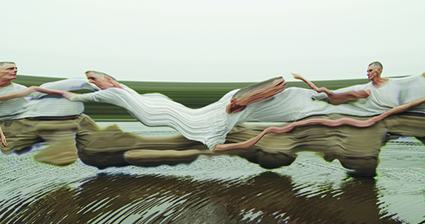
Natalie Cursio and Daniel Crooks, at least for a while anyway (still), 2015. Commissioned by Carriageworks for 24 Frames Per Secons
image courtesy the artists
Natalie Cursio and Daniel Crooks, at least for a while anyway (still), 2015. Commissioned by Carriageworks for 24 Frames Per Secons
Another senior dancer to appear in 24 Frames Per Second is Don Asker. In choreographer Nat Cursio and video artist Daniel Crooks’ at least for a while anyway, camera movement tracks left to right widescreen along a lakeside with its rushes and trees, until we reach a lone man, Asker, standing in the lake facing us. The camera moves on, the landscape gradually redistributed into striations of various greens, browns, blues and greys until the view is abstracted, although the water at times remains a ‘real’ if patterned presence. A hand pushes out between the lines and recedes, and then a leg, then head and shoulders, distorted like the melting limbs in Salvador Dali paintings but here coolly fluent, Asker stretching wide across layers of colour and over water in a series of supple moves. Asker’s dancing has been transformed, but the animation suggests agility, lyricism and even urgency. It’s one of 24 Frames Per Seconds’ best works. The ageing body emerging from and submerged in nature suggests a consoling and celebratory oneness.
Saburo Teshigawara’s Broken Lights engages me most of all, as both screen work and installation. It’s a work you step into to be enveloped by four screens—three walls and a ceiling—that reveal a field of sparkling, shattered glass on which the choreographer and dancer Rihoko Sato
perform. She is seen in the distance, then closer, human scale, elegantly poised in a supple, lean ‘vertical’ dance, feet shuffling ever so slightly over the glass in order not to fall. She then towers powerfully over the viewer. Teshigawara in black, mouth taped over, is a dark presence who breaks glass and executes an idiosyncratic little semi-crouched dance, the opposite of Sato’s. Broken Lights suggests much, for example evoking the creative risk shared by choreographer and dancer, if moreso physically for the dancer working with a choreographer who breaks rules—the fragile floor whereon new dance is made and performed.
24 Frames Per Second has delighted audiences but also provoked discussion that it’s principally a visual arts exhibition, with dance fuelling the making but being less than evident in the end result, where movement is fragmented, treated and often slow-motioned—phenomena, of course, not uncommon to screen dance, but felt in that field to be in the hands of choreographers and dance filmmakers. Discuss. Which we should do as time passes, allowing for reflection.
Congratulations to Carriageworks and its curators for an exhibition entirely comprising commissions of inventive collaborations and realised on a scale rarely seen in Australia, for installing it imaginatively and drawing attention to the multitudinous ways in which movement and screen can dance together.
Carriageworks, 24 Frames Per Second, Sydney, 18 June-2 Aug
RealTime issue #128 Aug-Sept 2015 pg. 50, 54
© Keith Gallasch; for permission to reproduce apply to realtime@realtimearts.net
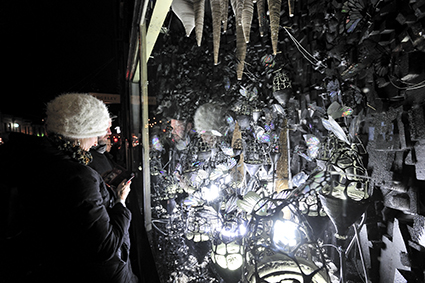
Skunk Control, Gertrude Street Projection Festival 2015
photo Bernie Phelan
Skunk Control, Gertrude Street Projection Festival 2015
Google Maps reckons it’s a 10-minute walk, but with close to 40 light-based artworks floating, glowing or nestling along Fitzroy’s edgy and eclectic Gertrude Street, two hours was closer to the mark. And I’m sure I missed some. But playing ‘spot the work’ along the way, festival app in hand, was part of the fun. From seductive optical candy to the thoughtful, the political and the quietly sublime, this year’s Gertrude Street Projection Festival (GSPF) continued its development as a diverse creative platform for the conceptual, the spectacular and the collaborative across its 10 mid-wintry nights.
With civil twilight descending just after 5pm, mid-July Melbourne is perfect for an outdoor projection festival—wind, rain and single-figure temperatures aside. Gertrude Street is a concentrated location, the street itself providing some serious competition for the artworks. It’s a gritty, graffitied mix of hipster shopping strip and public housing precinct, dotted with bars, cafés, social services, galleries and hair salons, strung alongside a slow-flowing river of trams, bikes and cars. Lots of visual and aural distraction: moving headlights, constantly shifting noise and quirky store displays. But with a bit of online guidance, there was plenty of gold to be discovered within the busy substrate. Here are a few samples.
The Romantic
Brianna Hudson’s Place of Longing was arresting for both its subtle colour and shining Romanticism. Utilising light not to dazzle but to brush its pastel warmth against a pale laneway wall, Place of Longing depicted an ancient landscape slowly drowning in smoky, peachy skies. A near-static, painterly surface of shifting tones, it silenced the din of the street; inner-city grime giving way to Romantic nostalgia, lost forests and dissolving clouds.
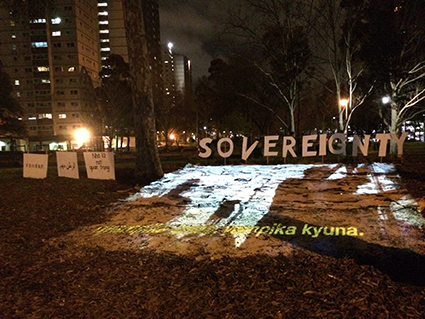
Gabi Briggs, Urala
The Political
Gabi Briggs’ Urala, sited amid a group of gum trees at the frontage of the Atherton Gardens public housing estate, used video footage from the recent Forced Closure rallies, projected against a carpet of paperbark and sand. Subtitles were included in Vietnamese, Arabic and Mandarin, aimed at creating dialogue between these local communities, as well as in Briggs’ own Indigenous language, Anaiwin. Behind the horizontally projected video, large letter-signs spelled out “SOVEREIGNTY”—the only English word in the piece. In a location where a long history of urban Aboriginal community intersects with those of recent migrants, the disenfranchised and the upwardly mobile—under a stand of trees suggesting a time before white settlement—Urala was spot-on in calling attention to notions of place, community and ownership.
The Collaborative
Briggs was one of four artists involved in GSPF’s Mentorship Program this year; another was Atherton Gardens resident Guled Abdulwasi, who worked with projection artist Nick Azidis to create giant ‘dark’ images on the side of the estate’s multistorey apartment buildings. I spoke later to GSPF co-curator Yandell Walton about the festival’s aim to bridge the social divide between housing estate and café strip. She cited festival projects including the mobile exhibition space Artbox Truck, situated within the housing estate, and presentations of performance/projection installations as well as an open projection night, Video Jam—which “allowed the exchange of ideas on a public art platform from the local community.” A ‘choose your own adventure’ work was also created around the estate by local youth theatre company Uprising Theatre; sadly, I was unable to catch these works but their inclusion augurs well for increasing connections across Gertrude Street’s many communities.
The Gallery
The New Vanguard exhibition, at Gertrude Street’s Seventh Gallery, showcased the work of five artists; drawing some 4,300 visitors during the festival, according to Walton. She and exhibition co-curator Arie Rain Glorie were keen to encourage the general public into a gallery space. Walton said, “For visitors to the festival to be exposed to conceptual works…this show was also about embracing projection as more than a medium used as spectacle…” From Tara Cook’s hovering, saturated, shadowy figures on a portrait-format video screen—who turn out to be ourselves, the viewers—to Zoe Scoglio’s bubbling, rumbling electronic paste-up of geometric shapes, stone, water, grain and flow (titled Water Falls and Other Features), The New Vanguard expanded the festival’s brief to include the projection of ideas: a counterweight, as the curators’ statement suggests, to the constant projected suggestions of advertising, politics and the “busy world” we’re constantly caught in.
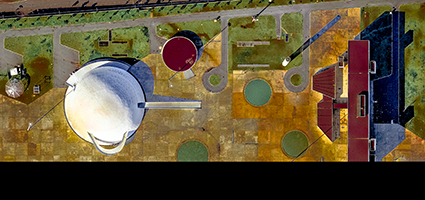
Ultradistancia, Federico Winer
photo courtesy of the artist
Ultradistancia, Federico Winer
The Polished
Amid mesmerising façades of swirling psychedelic colour and sneaky infiltrations into shop windows, two relatively ‘traditional’ works stood out while also fitting seamlessly into GSPF’s overall blend. Half-obscured inside a clothing store, Federico Winer’s Ultradistancia was no more than a vivid slideshow of enhanced aerial stills of cities, landscapes and roadscapes; studies in line and colour that were, nonetheless, just too good to pull away from. Similarly, in the front windows of Gertrude Contemporary, dance-filmmaker Sue Healey’s simply but perfectly realised film portrait of dancer Benjamin Hancock, from her On View series, drew a constant crowd of watchers, as Hancock moved and swayed like a tai-chi master or praying mantis, meeting our gaze as he floated, uncannily close to life-size, upon a dark and seemingly infinite background.
The Enchanted
And of course, there were the works, as always, that revelled in the mystery, pleasure, play and playfulness that participation in GSPF invites. Freya Pitt’s Fortune and Love Favour the Brave created a “Fake Hole” in a laneway wall: a metaphorical ‘lack’ into which was projected an animated reflection on desire—complete with photo-collaged angel lovers flexing their wings, riding on rocks and clouds and seemingly helpless amid their world of starscapes, graphics and flowing ribbons of text. Nearby, Victoria University’s engineering- and science-based collective Skunk Control utilised stark white light on black to create a magical, surreal grotto, Secluded Evolution, full of bizarre alien flowers in black metal, centres glowing with sharp monochromatic patterns. Upon them, black mechanised butterflies rested with transparent, stencilled wings pulsing, catching the light and splitting it into subtle prisms. Children and adults alike were transfixed.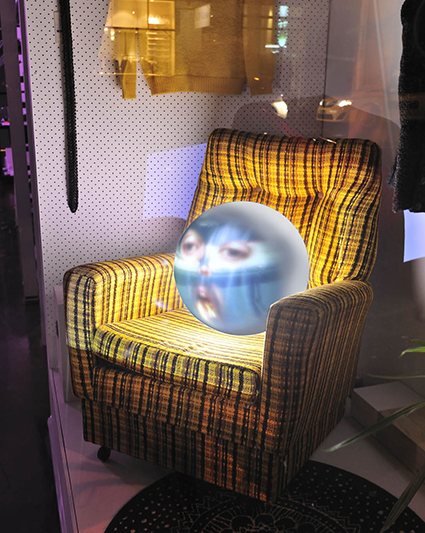
The Couch Potato, Andre Fazio
photo Bernie Phelan
The Couch Potato, Andre Fazio
The Thematic
It’s impossible to cover even a substantial number of GSPF’s works in a short review, or to convincingly generalise on the themes and ideas at play. Walton saw, overall, a desire by artists “to investigate ideas related to technology itself,”mentioning works like Dalton Stewart’s painting/projection work Ontology, which “blurred the boundary between materiality and virtual space through the convergence of painting and projection.” I saw ideas-based work; work in which light was merely an element; work in which light was both primary medium and focus of investigation. The works that stood out for me were those that evoked other artforms, times, places; merged with and utilised the surfaces they played upon or the 3D spaces in which they sat; and gathered an energy—whether quietly or spectacularly—that overrode the peak-hour traffic and nippy weather. It’s a hard call to bring together the rough edges and consumer culture of Gertrude Street, but the high-rise flats, the bundled-up pre-schoolers, the commuters, locals and the dancing colours all seemed to be embracing a good time.
Gertrude Street Projection Festival, director Nicky Pastore, co-curators Yandell Walton and Kym Ortenburg, Fitzroy, Melbourne, 10–19 July
RealTime issue #128 Aug-Sept 2015 pg. 51
© Urszula Dawkins; for permission to reproduce apply to realtime@realtimearts.net
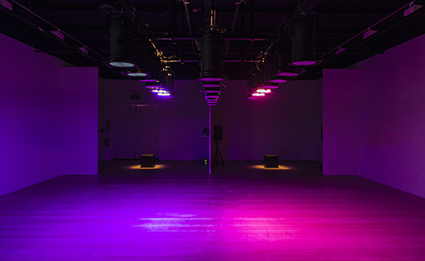
Jason James, Crevasse, envelop(e)
courtesy the artist and Dark MOFO festival
Jason James, Crevasse, envelop(e)
Matt Warren’s show Envelop(e) at Contemporary Art Tasmania is very much a culmination of ideas he’s been investigating for much of his career. His own work has long featured sound, so the move into curation in 2012 with A Silent Way seemed logical and has been revealed in Envelop(e) as a rich extension of his overall practice. Jason James, another Tasmanian artist who is at a much earlier stage of his career, contributed a new work to Envelop(e) while also debuting an ambitious installation, Angry Electrons, in a docking bay at the Centre for the Arts (see Profiler 11 at www.realtimearts.net for more on the artist and video of the work).
Envelop(e) comprises four sound works from Elizabeth Veldon, Christina Kubisch, Mick Harris and Julian Day, plus Jason James’ light installation Crevasse. While each has its own governing set of impulses and logical formatting, a powerful overall effect is realised by Warren’s careful arrangement of the works in a sparely lit space with open cubicles somewhat akin to listening stations—three of the four each with a small seat. The effect is monastic. Hanging at the centre is James’ Crevasse, a bank of 21 stage lights—1000 watt Par Cans—changing hue, seeping on and off. The overall arrangement of the exhibition implies ritual, attempting to slow viewers down—a seat probably helps, but it’s the setting that largely creates the palpably reverential tone.
Elizabeth Veldon’s The Tortoise History of Our Voyage stands out by breaking the sound-art mould, using texts gleaned from the journals of Charles Darwin on his visit to Hobart in 1836. Voices overlap and interlock, leaving potential for listeners to ascribe new meanings or just enjoy the cadences. Mick Harris, famed as the drummer for the extreme metal act Napalm Death, contributes two interwoven drone works that evoke the edges of dream worlds, while German composer Christina Kubisch presents sound from her installation Movements to Distant Places, an exploration of the sounds generated by the electromagnetic forces that shift around us. As with Veldon’s, both works create a spectral sense of the distances of history, geographic dislocation or the melting worlds of the subconscious.
Julian Day’s visually and sonically delicious Requiem features two identical “heirloom” synthesizers mounted on opposing walls and linked by eight silver rods which hold down keys, generating a drone. This sculptural work combines wit with a take on classic minimalism, becoming one of those ‘anyone-could-have-done-it-but-they-didn’t’ works that stand out as being in equal parts beautiful and clever.
Jason James writes, “Ever since hearing about explorers dying by falling into crevasses I have wondered what it must be like to be dying somewhere that is both beautiful and deadly”. An attempt to render the light seen from the bottom of an ice cave, Crevasse rolls slowly through cool and frozen light states: blues, stark whites, toxic lilacs. It felt cold, very cold. Its strongest effect is as a kind of visual subtext to the softly meshing sounds of the gathered art works that becomes the slowly pulsing centre of the room. The brazenly open display of the light source just above the heads of visitors, calls to mind a weird aircraft, possibly with occult or alien origins, its patternings reminiscent of coding or signalling—oddly triggering a desire to decode. Matt Warren’s art has long attempted this kind of evocation and it’s a fascinating eventuality that one of his most successful efforts should come from his work as a curator.
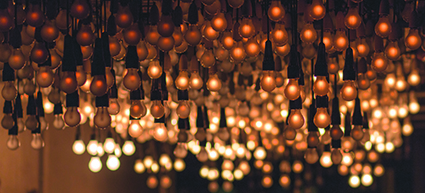
Jason James, Angry Electrons
courtesy the artist and Dark MOFO festival
Jason James, Angry Electrons
At a docking bay in the Centre for the Arts, James’ large-scale installation Angry Electrons marries motion sensors to a floating sea of 1000 light bulbs in a dance of glowing electricity that moves above in reaction to the audience moving below. Bristling with rude and lively energy, Angry Electrons successfully achieves something extraordinarily complex in technical terms if not in evoking the danger of electricity the artist intended. The many people who saw this installation almost universally played with it—children in particular ran about, delighted as they realised their movements were causing the brisk dancing above their heads. The potential for realising electrical terror might have been effected by hanging the bulbs lower, but practical issues of health (the effects of intense light on eyesight) and safety (the risk of someone touching and breaking a bulb) required the angry electrons to be contained by elevating their glass cages.
The stark concrete docking bay was transformed into a space of fleeting beauty, filled with excited, giggling shrieks; humans are possibly less predictable than electricity. Angry Electrons was not frightening, but thrilling, fun and incredibly engaging. James’ Crevasse felt far more sinister, conjuring up a sense of the irrational and the eerie.
Dark Mofo 2015: Envelop(e), curator Matt Warren, artists Elizabeth Veldon, Julian Day, Mick Harris, Christina Kubisch, Jason James, Contemporary Art Tasmania, 11 June-19 July; Angry Electrons, Jason James, Centre For The Arts, 12–21 June
RealTime issue #128 Aug-Sept 2015 pg. 52
© Andrew Harper; for permission to reproduce apply to realtime@realtimearts.net
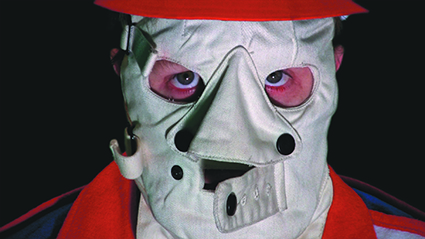
Alterland, Heath Franco
photo courtesy Australian Experimental Arts Foundation
Alterland, Heath Franco
Video became established as an art form in the latter half of the 20th century, but in the 21st, the age of video games, virtual reality, YouTube, social media and phone cameras, video is a universal language. Performance art frequently explores identity and the self in interaction with the world, and in his review of PP/VT Performance Presence/Video Time, Ben Brooker notes the current resurgence of performance art, whose history is intertwined with that of video. Heath Franco’s work both extends the tradition of performance on screen, using himself as the actor, and addresses the ever-expanding field of visual media.
On entering Heath Franco’s Alterland, we first see Portrait (2010-2015), a three-minute looped video showing in rapid sequence the comically nightmarish characters he has created over several years. This sequence is framed by TV test-pattern colours as if TV or video portraiture has displaced painted and photographic portraiture. Sydney-based Franco plays every role, which he evokes with dramatic gestures, bizarre costumes, garish makeup and sometimes novelty-shop masks. His characters resemble caricatures from children’s stories, pantomimes and video games. There are many animal characters—cats, dogs, wolves and koalas, even a pig with a plastic roast chicken on its head. Sometimes Franco dresses as a woman, albeit with a beard. While there is a childish quality in this uninhibited foolery and dressing up, the characters represent personas we might encounter that can reveal the human psyche in all its manifestations. Franco says that they represent people he has met, or characters from TV and horror movies, and he cites David Lynch as an influence. His work brings to mind satirical comedy from Aunty Jack to Dame Edna Everage, Dada, Fluxus, Absurdist theatre and even the dissociative psychopathology of Jekyll and Hyde, as if Franco himself embodies a range of alter egos.
Having been introduced to the inhabitants of Heath Franco’s world, we then proceed to Wunder-Land (2011-2015), where we approach an archway on either side of which are video projections (from his Wunder Closet, 2011) showing a rapid sequence of images of Franco, trouserless and in various guises, leaping up with hands in the air as if to create a human tunnel, like a cheer squad encouraging players entering a stadium. As we walk through the archway, we see a semicircular array of TV monitors on the floor, showing more trouserless characters who applaud us vigorously. Behind the monitors a huge wall-projected image of a masked face stares at us, an Orwellian Big Brother welcoming us to an insane world through the archway portal to the acclamation of the half-naked acolytes on the monitors.
Beyond this ‘temple’ is Franco’s Static Spread (2013-2015), another installation of wall projections showing a four-second looped fragment from his 2013 video Televisions in which two characters magically emerge from an image of TV static. One is in sinister black and the other in angelic white like a high priest; they mockingly represent good and evil in combat. Both roles are performed by Franco in a well-crafted piece of digital manipulation that reminds us to beware of hidden messages in our media. The trance-inducing repetition of the imagery in Wunder-Land and Static Spread hammers home the message.
At the exhibition opening, Art Gallery of SA director Nick Mitzevich interviewed Franco before a large and enthusiastic audience. In noting Marina Abramovic’s view that performance art is hard work, Mitzevich places Franco’s work in the performance art tradition and acknowledges the effort involved in creating these roles. Franco’s Alterland is not simply a record of performances, but a complex montage of electronically mediated imagery that places the viewer within a multi-channel installation. As with many artists, Franco’s work also circulates universally through the internet. We recall Marshall McLuhan’s dictum of 1964 that the medium is the message.
As well as exploring the power of video and cleverly parodying human behaviour, Franco raises important social issues. For example, his Alterland installations address religion and the church, he considers gender identification through cross-dressing and he challenges authority by creating malevolent-looking authority figures who seem to talk gibberish. Abandoned, alienated misfits and outsiders are also among his cast of characters and in Alterland are valued members of society. In the interview with Mitzevich, Franco states that, in showing himself half naked, he is representing the childish fear of being caught naked, but in so doing he reveals our paranoid obsession with sexuality and appearance.
Viewers seem to associate strongly with Franco’s installation, many photographing themselves or each other against the backdrop of the wall-projected imagery and thus, paradoxically, documenting themselves within Franco’s theatre. Undoubtedly their images will also circulate further via the internet and become part of the video universe in which we live.
Heath Franco, Alterland, Australian Experimental Art Foundation, Adelaide,10 July-8 Aug
RealTime issue #128 Aug-Sept 2015 pg. 54
© Chris Reid; for permission to reproduce apply to realtime@realtimearts.net
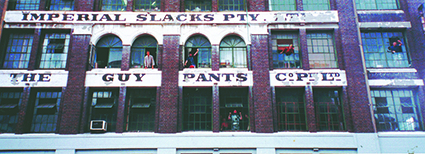
The Imperial Slacks warehouse in Surry Hills, Sydney
From 2000-on Sydney’s artist-run Imperial Slacks gallery generated a continuous buzz and a sense of multi-artform community as a Surry Hills’ hub for curated exhibitions of all kinds, video art, sound events and performances by local and international artists. It closed in late 2002 with Slacking Off, “opening up the live-in artist spaces for an expanse of mini-exhibitions from invited and resident artists”.
The core of the Imperial Slacks collective—Shaun Gladwell, Angelica Mesiti, Emma Price, Sean Cordeiro and Claire Healy, Wade Marynowsky, Alex Davies, Techa Noble, Michael Schiavello, Chris Fox, Melody Willis, Lea Donnan, Simon Cooper and Laura Jordan—have been reunited in Cosmic Love Wonder Lust: The Imperial Slacks Project curated by Campbelltown Arts Centre CEO Michael Dagostino and Nicholas Tsoutas, Lecturer at Sydney College of the Arts. RealTime spoke with Dagostino prior to the launch.
What can we expect to see?
There’s a combination of new and existing works and what we’re doing is treating both institutions, Campbelltown Arts Centre and Sydney College of the Arts, as one large venue and then spreading the works across them. It’s a very ambitious show with 15 artists, most of them still practising.
It was a very distinctive phase in the visual arts world.
What they were able to do in such a short period of time was actually quite dramatic. I remember going there just after coming out of art school. There was this really dynamic, fluid, almost hyperreal arts scene. We want to be able to profile that in a new light and also to dig down into the reasons why it was such an important part of the contemporary art scene at the time. In 2000 many things were going on—the city was in a state of flux. We were coming out of an economic bust. There was all the hype of activity around the Olympics. There was real focus on Sydney and these artists were able to counteract, to talk about and engage with everything that was happening. A lot of them have gone on to have very successful careers, others have moved into the academy. Imperial Slacks was a really dynamic hub.
What kind of work struck you at the time?
There were some really interesting works from Shaun Gladwell. We’re showing a number from his early painting series that he produced at Slacks and showed with the Boutwell Draper Gallery. He’s an amazing painter. There are early installation works by Sean Cordeiro and Claire Healy—we’ve been able to reconstruct some of those—and by Alex Davies, which are just mind-blowing! When you look at current practices in immersive and interactive work, Alex Davies was pushing the boundaries back then.
There was also the total democratisation of the video camera. You could walk into your local electronics shop and for $1000 buy a video camera that was totally inaccessible maybe 10-15 years ago. Consequently there’s a lot of video documentation from that time and a lot of video works being made by groups like the Kingpins, a really dynamic group of young female artists talking about gender politics, identity… That’s what I mean by ‘fluid.’ It wasn’t about one artist or movement; it was a really interesting communal idea of what art could be.
It was a fantastic time. It’s weird to think it was some 15 years ago but it still feels very fresh. There’ll be a mix of works from that time alongside new, commissioned works in each venue. As with any artists, you’ll see change but there are a lot of parallels. Wade Marynowsky is a fine example of an artist who was making really complex, detailed computer-generated artworks at that time. His work has evolved and is now more installation-based but still with the same core, which is really important.
Who are some of the other artists?
Emma Price, who has now taken the whole performative thing into the setting-up of a bar, The Bearded Tit. She was part of the Kingpins and the continuity is there. Chris Fox is still making large-scale installations but has moved more into drawing now, creating drawing machines that will blow people’s minds. There are also video artist Angelica Messiti, electronic artist Michael Schiavello and Monika Tichacek. Monika moved overseas and now does drawings of varying scales. For Cosmic Love… she’s doing a life-scale drawing of a seagull that’s been cut open and is full of plastic refuse. Her work is still very dark and abject but now with a very, very different aesthetic.
Will there be performances and talks?
There’ll be performances at both openings in August and an all-day forum at the Gunnery in Woolloomooloo in partnership with NAVA about artist-run spaces, using Imperial Slacks as a centre point and seeing where these spaces are now.
Campbelltown Arts Centre, Sydney College of the Arts, Cosmic Love Wonder Lust: The Imperial Slacks Project, Sydney and Campbelltown, 14 Aug-18 Oct
RealTime issue #128 Aug-Sept 2015 pg. 55
© RT ; for permission to reproduce apply to realtime@realtimearts.net
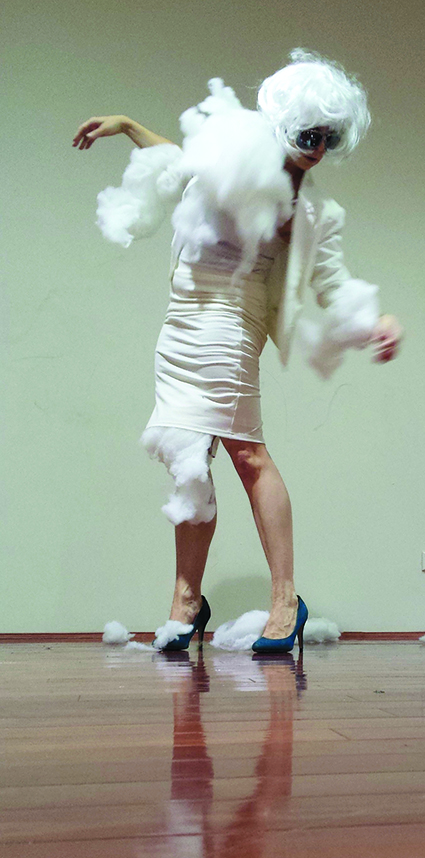
Kay Armstrong, An Hour With Kay
photo courtesy the artist
Kay Armstrong, An Hour With Kay
Kay Armstrong begins her solo show proper with a departure. We watch on a mobile phone screen held by Kay-who-is-not-Kay as the artist leaves the building in ‘real time,’ apologising that she can’t stay. Her protracted exit, as she negotiates several sets of stairs long after her script has ended, creates an awkward pause between us and the two Kays as we huddle around the mobile phone screen.
Prior to this we stood on a balcony and watched Kay Armstrong in the distance, dressed for a tropical holiday and swaying among the pot plants on a run-down rooftop in a grungy part of Surry Hills. Now we enter a theatre space by following footprints marked on the floor. Directed to sit apart from our friends by the other Kay, holding paddles as if signalling on a runway, we are spread across the seating bank. Presence/absence, fractured fictions, temporal dislocations and social isolation are all set out promptly and poetically.
Armstrong’s work combines monologue, stand-up, dance and a playful approach to objects and scenic design. Early on, the audience is given the impossible task of working in groups on a world map jigsaw puzzle. Establishing that we are not there to “make sense of the world,” Kay crams her tacky white skirt suit full of fluffy white stuffing, prosthetically adjusting her dancer’s body and performing a sequence of ungainly if virtuosic poses.
The closing section is a testament to Armstrong’s rigorous imagination and creative resourcefulness. We are all given potatoes and sticks with which to each create a creature. Using a version of the pornstar-name generator game to title them—your first pet’s name and the street you grew up on—Kay quietly records their bizarre entreaties (“Help, help, that hurts,” “Please don’t leave me here alone”). We are invited to place our potato creatures (mine being Ginger Concord) in the performance space. On the back wall, amid the white foam and projected shadows, an alien landscape inhabited by fat spikey creatures appears. Kay picks her way through them like King Kong as the little creatures’ cry for help from her iPhone.
This is personality-driven work, as the title self-consciously suggests, playing with this focus through the presence/absence of Armstrong across the hour. At one point Kay phones in instructions to an audience member from another room and at another she reels off adjusted song titles that are funny and downbeat (“What if Luca doesn’t live on the 2nd floor?” “What if I don’t want to know what love is?”). A self-deprecating, dark humour persists here as in all of Kay Armstrong’s solo works, combined with her unfettered joy in the possibilities of theatre and all of its trappings. [It was a wild night out! Eds]
An Hour with Kay, devisor, performer Kay Armstrong The Old 505 Theatre, Sydney, 30 June-5 July
RealTime issue #128 Aug-Sept 2015 pg. 32
© Erin Brannigan; for permission to reproduce apply to realtime@realtimearts.net
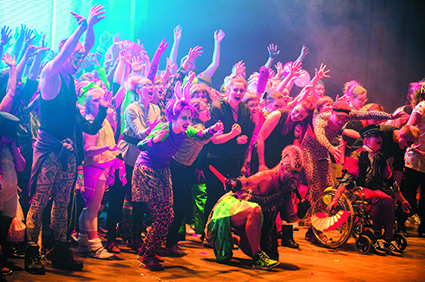
DEEP Aerobics
photo Pekka Mäkinen, courtesy of Finnish House of Dance Association
DEEP Aerobics
Berlin’s youngest major festival, Foreign Affairs, has ambitions to become a definitive statement in cutting-edge contemporary theatre, but its identity keeps shifting, just like its calendar dates. It seems not quite sure whether it wants to be a really big festival with retrospectives of important names, a curated statement or just to show really good contemporary work. This year’s edition was well-timed, closing off the German theatre season just before the summer holidays, and its programming tended towards the retrospective and the definitive: the complete Tabletop Shakespeare by Forced Entertainment was sold out far in advance, Angélica Liddell was the artist in focus with four major works in the program and Jan Fabre’s Mount Olympus, if a single work, was 24 hours long and covered most of the Greek dramatic canon. (I missed Mount Olympus, later reported to be a masterpiece, and Fabre’s best and most mature work in a long time.)
Angélica Liddell, You Are My Destiny
After seeing You Are My Destiny (Lo Stupro di Lucrezia), the considerable reputation of the controversial, provocative Spanish performer Angélica Liddell remains a mystery. Liddell re-stages the Rape of Lucrezia and her suicide to restore the honour of the men in her house. In her interpretation, the “rape trauma is a love story,” the rapist a lover. This would be an extremely problematic interpretive key even in less progressive locales than Berlin in 2015. Liddell’s performance should require leaps of at least Žižekian intelligence to persuade. Instead, unfortunately, Liddell presents an overlong show (two and a half hours) that mixes and mashes—without a clear structuring logic—screaming women, a choir of semi-naked drummers, Christian imagery, Ukranian church songs, little children and Venetian architecture.
In the most successful sequence, the male drummers lean against the back wall in a half-squat that soon becomes uncomfortable to even watch, let alone endure. Liddell, the director of the piece, gently wipes their brows, kisses them and in other ineffective ways pretends to alleviate their suffering, all the while berating a female performer for forcing this ordeal. The manifestation of brute power is stark and chilling. Mostly, however, beer is poured over female bodies, panties are tossed into the audience, burly men sing. All is interminable, visually stale, dramatically imprecise, intellectually unconvincing. The final bow was followed, in the foyer, by a number of patrons selling off their tickets to Liddell’s subsequent shows.
Hofesh Shechter, Barbarians
Hofesh Shechter’s Barbarians was divided into three parts, of which the first two had already been shown in the UK while the third was a world premiere. The first, Barbarians in love, opens with already expected Shechter fare: strong lights, noise, earplugs freely distributed. Six dancers in white, Star Trek-like uniforms move to a blend of François Couperin’s “Concerts Royaux” underlaid with a metallic drone. Over the top, a gentle female robotic voice tells them that “they are one.” Ostensibly, it is the mermaid’s song of civilised society. Suddenly, the voice calls on Shechter himself, the dancers stop and an argument erupts, during which Shechter’s voice explains nebulously that he has turned 40 and wanted to talk about innocence, loss of innocence, love.
The first part foreshadows the struggle between Baroque and club music that is fully let loose in the second part. Now, eight dancers in extremely tight golden bodysuits move, with very fast cuts, from Baroque ballet to folk dance to classical ballet to urban club dancing, always again referencing the animalistic, masculine vocabulary so recognisable in Shechter’s style. The music cuts from Baroque to electro, industrial to jazz, “Pussy Crook” by Mystikal to the Sound of Shechter, dubstep to courtly dances and sudden silences. While choreographically tight and performed to perfection, dramaturgically it is about as sophisticated as Shechter’s jejune speech. This tight remix of courtly sophistication and the urban jungle may invoke a struggle between social form and pure hearts, but at 40 one expects slightly more nuance.
The last part, the shortest, unexpectedly saves Barbarians. Shechter’s habitual crowd disappears and a man and a woman, she in glamorous white shirt and trousers, he in full Bavarian lederhosen, do a monotone mumbo shuffle to Abdullah Ibrahim’s “Maraba Blue,” an easy jazz piece. A fight follows. Distance. Finally, she stands in front of him and performs an oriental-ish dance, light and seductive, later joined by the rest of the ensemble. Rather clichéd, but completely unexpected from Shechter, this statement resolves the nonsense question of whether it is better to be a member of the Borg or of a wild horde, by remembering that, even when we make clichéd life decisions, we remain individuals. After an evening of nebulous semi-politics, this gesture is elating.
Miguel Gutierrez, DEEP AEROBICS
Finally, Miguel Gutierrez’s DEEP AEROBICS (DEEP an acronym for “Death Electric Emo Protest”) snuck into the program as a late-night free event and floored me with its intelligence. It is a progressive political performance with an extraordinary capacity to both heal and mobilise. Gutierrez employs every weapon in the arsenal of immersive performance to create a collective dance experience: obligatory costuming (with a range of outrageous clothing, make-up and glitter provided), music, dancefloor/bar setting and aerobics-like instructions that soon have us rather un-self-consciously dancing, touching walls, rolling on the floor, fondling each other and undressing to a serious level of nudity as the space heats up. “Remember,” roars Gutierrez, an exceptionally skilled master-of-ceremonies, “self-consciousness is the illusion that this is only happening to me!” However, once the tidy theatre audience has transformed into a sweaty semi-naked mob covered in floor dirt and glitter, Gutierrez slowly starts introducing political anger—at lack of health insurance for the poor, at oppression of minorities, at the traumas of hardship.
The emotionally liberating experience of dance thus becomes a collective cleansing of pain. Instead of succumbing to the dangerous neo-liberal panacea of docile self-improvement, Miguel Gutierrez reminds us of our own political struggles, which we can, paradoxically, see more clearly in this elated state. We are made to chant, “I am alive and I’m not afraid to die!” and, towards the end, “This spectacle is becoming predictable. Turn off the internet and get on the streets.” In between, saving the Earth with sex, channelling the forces of the benevolent universe into our bodies and spreading love to one another are all enacted without an ounce of irony. We practice consent by screaming “Yes! No! Maybe!” with fist pumps; or “you can do my hair, but you can’t get married!” while on our backs, kicking our legs in the air. The effect is politically enlightening, yet empowering. We leave the theatre fully charged for the revolution.
–
Foreign Affairs: Angélica Liddell, Atra Bilis Teatro, You Are My Destiny (lo stupro di Lucrezia), text, direction, design Angélica Liddell, 30 June; Hofesh Shechter Company, Barbarians, choreography, music Hofesh Shechter, 3-4 July; Deep Aerobics, Miguel Gutierrez, 25 June; Foreign Affairs, 25 June-5 July, Haus der Berliner Festspiele, Berlin
RealTime issue #128 Aug-Sept 2015 pg. 40
© Jana Perkovic; for permission to reproduce apply to realtime@realtimearts.net
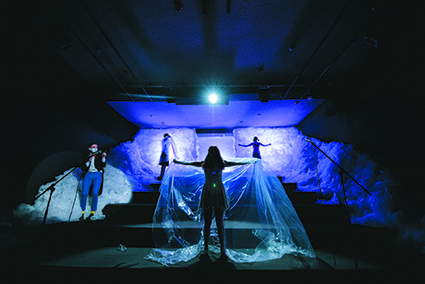
Dust Covered Butterfly
photo Morgan Roberts
Dust Covered Butterfly
Band? Check. Dynamic and sexy performers? Check. Serial killers? Check. The Sue Benner Theatre configured backwards and the seating bank covered with painters’ plastic made to look like angel clouds? Check. What more could you ask for? Dust Covered Butterfly is a new devised work by Thomas Hutchins and Michael Whittred which Hutchins describes as sitting in the ‘uncomfortable’ but arresting space between a rock concert and a contemporary performance.
It begins with a backlit male figure behind a sheet of plastic. He slowly emerges, clad only in coloured cotton Y-fronts and a full-length woollen coat. He elegantly descends the dozen stairs of the seating bank of a theatre reclaimed as vertical playing space. He is followed by two lissom she-bop girls and they blast out the first number of the night, “No Lies,” into the three awaiting cabaret mikes. The man then hands his electric guitar to our caustically camp Host who is decked out in three-quarter white-face. He asks us to choose: One, Two or Three? We pick number One, the man.
This triggers a sequence that delicately alludes to the first meeting of a serial killer and his female victim. Across the night, our deliciously mischievous Host warns us candidly about each section before it begins as he vividly describes the metamorphosis of a butterfly.
We learn of the vapid preoccupations of our female victim, The Captive, and her online blog, but also how she was tricked into the van of The Captor by the pleas of his female accomplice, the Bait. We learn of the deep obsessive love of the Bait for The Captor and, probably most deeply and disturbingly, in a final scintillating monologue by the Captor we hear his innermost thoughts and yearnings—the psyche of a deranged killer who cannot control his sexual and emotional impulses—and how they drive him remorselessly.
It is difficult subject matter to explore without being salacious. For me, there were some moments where the show verged towards violent chic, mostly because of the charisma of the male lead Michael Whittred. On the night I saw the show he was band-leader and killer, the women were exclusively victims and side-kicks, with no songs of their own to sing. However, I misunderstood the full weight of the choice we made in the first moments of the show. We got to pick which bodies would fulfil the archetypal roles and so audiences on other nights might have witnessed that last glorious monologue from the mouths of the women performers.
Full kudos should go to young Hahnie Goldfinch for a magnificent set design that reimagined the Benner with an eerie delicacy rare in budget-poor theatre-set-land. My only reservation really was about the sometimes awkward nature of the transitions from the rock concert set-up at the bottom of the set to the stand-and-deliver monologues scattered across the stairs—a small price to pay for a punch-in-the-gut night of adventurous independent theatre in Brisbane.
Dust Covered Butterfly, director Thomas Hutchins, producer Jake Shavikin, performers Bella Anderson, Katy Cotter, Chris Farrell, Michael Whittred, design Hahnie Goldfinch, songs Michael Whittred, text Katy Cotter, Sue Benner Theatre, Metro Arts, Brisbane, 2-20 June
RealTime issue #128 Aug-Sept 2015 pg. 38
© Kathryn Kelly; for permission to reproduce apply to realtime@realtimearts.net
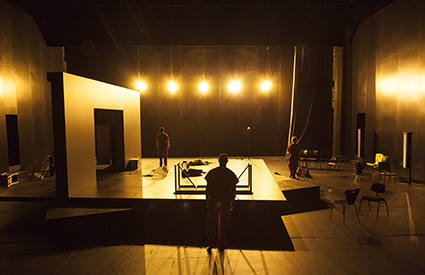
I Am a Miracle
photo Pia Johnson
I Am a Miracle
Is Australian set design having its Brutalist moment? Recent work has embraced a visual ugliness that can be surprisingly confronting—not the comfortingly artful messiness of so many post-dramatic works, or the stark but sensible abstraction of minimalism. It’s a blunt, crude, almost amateurish look that’s all the more brave given the imperative towards ‘excellence’ that emphasises gloss and prettiness and the sense that however dark things may get, at least someone spent a lot of money on it.
MTC NEON: Dee & Cornelius, SHIT
Dee & Cornelius’ SHIT is a case in point. A large grey edifice is punctuated by three square portals. To one side lurks a battered convex mirror, the sort you’d find at the end of a neglected surburban train station. That’s it. The set is less imposing than mutely oppressive, offering so little of visual interest that its effectiveness only emerges slowly, sidewise. It’s not a character, as so many sets today are often described. It’s more like a faceless institution, unquestionable and uncaring, and is the perfect space in which to situate this drama.
SHIT opens with a monologue that elevates profanity to Beckett-like wordplay (I’ve never heard ‘fuck’ used as noun, verb and adjective in the same sentence). It’s an immediate reminder of Patricia Cornelius’ versatility as a writer, able to produce poetry from vulgar argots without sterilising their power along the way. It’s also a potent introduction to the three protagonists, a trio of women who are the subjects and agents of violence, who inhabit a cruel and complex social sphere but who will not be written off as either victim or monster.
The subtle choreography of the work rarely makes explicit their situation, but sequences are redolent of holding cells, line-ups, dingy flats, dark streets. A narrative of sorts emerges elliptically, hinting at their incarceration after a vicious attack on a stranger at night. They speak of their own histories, too, making clear that each has suffered domestic violence and sexual abuse as foster children and adults (although their ages could be anything from late teens to middle age or older).
But this isn’t a work that seeks to pathologise its central figures, to explain how they have become the people they are. Neither is it a mystery, teasing out an act of violence and its causes. These women are victims of their circumstances, but are absolutely in control of how they present themselves to us. They enact for each other the way they fake crying to fend off an attacker, until one’s performance is so unsettling that the others are left open-mouthed. They reveal suicide attempts but in a manner so histrionic it approaches clowning. They put a cap on a heartbreaking recollection with “yeah well boo hoo never mind.”
It may be the unaffected brilliance of so many aspects of this production—the keen writing, coy direction and profoundly arresting performances—that caused the glum set to stand out so oddly. But as it unfolded, it emerged that these figures were performing their lives against these unforgiving surrounds, in defiance of their environment. It all makes most set design look like dollhouse construction.
Malthouse: Declan Greene, I Am a Miracle
Playwright Declan Greene and director Matthew Lutton’s I Am a Miracle presents us with another apparently naive spectacle, here co-designed by Marg Horwell and lighting designer Paul Jackson—a grey square archway on a grey square revolve, strewn with a few items of clothing and some overturned chairs. Three figures in prison jumpsuits squat in isolation from one another. There are no secrets here, nothing of eventual significance we can wonder about as we wait for the action to start. Indeed, almost nothing of what follows can be guessed at, since it again all takes place almost in opposition to its surroundings.
There are two main movements to the work. In the first, an 18th century Dutch soldier is enlisted to fight against rebelling slaves in the colony of Surinam, but quickly finds himself caught among the atrocities doled out by both sides. Melita Jurisic’s performance of the role here is mostly oration, arms held low and movement kept to a sluggish pace; the frenzied horror of her character’s environment is mostly left to the mind of the viewer as a result. The work’s second extended sequence shifts to a contemporary and more naturalistic register, as a man and woman struggle with the unravelling of his mind. She may be his partner, or his carer or something else. The audience is kept as bewildered and unanchored as he is, and this effectively makes his final violent outburst something sympathetic, if not exactly cathartic.
These two movements are situated in a frame that makes reference to the 2012 execution of Marvin Lee Wilson, whose death was Greene’s inspiration. For brief moments the audience is addressed as Wilson himself, the circumstances of his upbringing and turn to crime recounted and the possibility of finding some kind of grace in his existence at least suggested. Finding the threads that connect the various parts of the work isn’t easy—a common theme may be slavery of both material and metaphysical sorts, or the operations of power on both a state and personal level. There is a sense of impotence, too, on the part of artists trying to make something of a terrible injustice, and despite hints of transcendence—a kind of mystical closing sequence, references to performers as angels, and operatic interludes—the work’s inability to enact a transfigurative salvation that will make everything, indeed anything okay, is what makes for a puzzling, dispiriting experience that nevertheless lingers.
Which seems perfectly appropriate. I Am a Miracle struck me as a spartan melodrama, a work of great emotion and song stripped back to cold outlines. The set’s dumb blankness echoes this—it offers no escape, no tools with which to engage the world. It is a prison cell, like the work, which struggles to escape itself, and which confesses the futility of its own project.
MTC NEON: Dee & Cornelius, SHIT, writer Patricia Cornelius, director Susie Dee, set and costume design Marg Horwell, Southbank Theatre, 25 June-5 July; Malthouse Theatre, I Am a Miracle, writer Declan Greene, director Matthew Lutton, set and costume design Marg Horwell, set design and lighting Paul Jackson; Malthouse, Melbourne 22 July-9 Aug
RealTime issue #128 Aug-Sept 2015 pg. 37
© John Bailey; for permission to reproduce apply to realtime@realtimearts.net
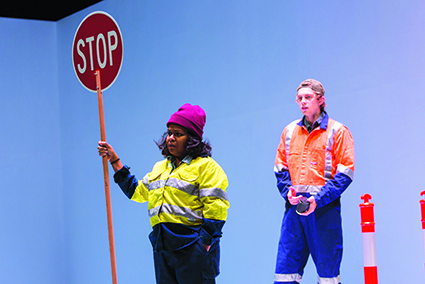
Ursula Yovich, Harry Greenwood, Love and Information, a Sydney Theatre Company and Malthouse production
photo © Pia Johnson
Ursula Yovich, Harry Greenwood, Love and Information, a Sydney Theatre Company and Malthouse production
War in Bertolt Brecht’s Mother Courage and Her Children, obligation in Aboriginal society in Kylie Coolwell’s Battle of Waterloo, the opposition between myth and science in Ryan McGoldrich’s The Great Speckled Bird and fragmented 21st century reality assayed in Caryl Churchill’s Love and Information remind us that we live and breathe culture, that it constrains and only occasionally liberates us.
PACT, The Great Speckled Bird
In The Great Speckled Bird, writer-performer-director-designer Ryan McGoldrich (a University of Wollongong postgrad) dextrously weaves together contemporary mathematics (where an X/Y point can be realised as a “dancing figure,” cosmology (Big Bang, chicken and egg, etc) and his Irish Catholic grandmother’s expansion of the Prometheus myth into parts 2 and 3 featuring birds (because they figure so little in the Bible). With limited means (a microphone and stand which deftly become a bird, automated Weazel Balls minus the weasels, projected charts) and two extrovert musicians (also as birds), McGoldrich quietly engrosses us with an expansive exercise in lateral thought that delightfully and quite personally eases the existential anxieties he initially induces.
STC, Battle of Waterloo
Kylie Coolwell’s The Battle of Waterloo might be conventional, but it is not just another play. The complexity of Aboriginal life in high-rise public housing in Sydney’s Waterloo is vividly and revealingly realised by Coolwell, director Sarah Goodes and a talented cast who perform with verbal and physical verve.
Not only is Coolwell, a Mulinjarlie woman from south-west Queensland and a resident of Waterloo, finely attuned to the communality and ruses of everyday conversation and the wit and economy of Aboriginal English, but she knows how to write dialogue that generates movement. There’s stolid stillness in Shari Sebben’s central performance as Cassie, the older sister sharing responsibility with her aunt (Roxanne McDonald) for her drug-addicted sister Sissy (Shareena Clanton) and young brother Jack (James Slee). But, save for her aunt’s calming presence, the other characters irritate Cassie with a mad dance of comings and goings—the sister demanding money, Jack hiding from his mother, Leon (Leon Simon) on the run and Cassie’s sometime lover Ray (Luke Carroll) back from three years in gaol and brimming over with restless energy, eager for work and a revived relationship. Then there’s the singing along to favourite songs on the radio, a vibrant scene where everyone dances, embracing and cuddling, football play (underscoring the dignity offered men—otherwise deprived of it—by participation in the Indigenous Knockout football round), a police chase and Sissy’s truly frightening drug-induced physical aggression.
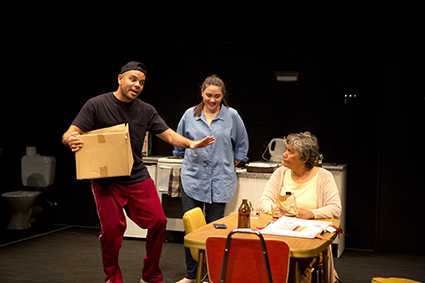
Luke Carroll, Shari Sebbens, Roxanne McDonald, The Battle of Waterloo, Sydney Theatre Company
photo Lisa Tomasetti
Luke Carroll, Shari Sebbens, Roxanne McDonald, The Battle of Waterloo, Sydney Theatre Company
Cassie desires a life of her own, as a fashion designer, and knows that she mustn’t be pulled into Ray’s potentially criminal orbit, let alone the escalating demands of her family. Her sense of obligation and, later, guilt threaten to overwhelm her ambition and, above all, her sense of self. Only when everything comes undone, does Sebbens depart from her stable trajectory, unleashing Cassie’s pain—disbelief, denial, loss and guilt—as raw, frantic energy. It’s deeply disturbing and it’s Cassie’s tragedy, not Ray’s.
As true as it can be, there’s an almost melodramatic inevitability to Ray’s demise—one of many defeated, vulnerable young Indigenous men. He dies before he has to face the challenges Cassie represents. In the end, has she been cruelly liberated by Ray’s death or will an unwarranted sense of guilt and familial responsibilities overtake her? That’s where I would have liked Coolwell to take us.
Like Nakkiah Lui (Kill the Messenger, Belvoir, Feb-March, RT126, p32), Kylie Coolwell writes with impressive ease, wit and insight if with a vision more nuanced and expansive. Sarah Goodes’ taut direction yields a great sense of community as well as anxious momentum. Renee Mulder’s design captures something of the dark density and height of the housing commission tower, if looking generously spacious. Cassie’s fashion design, a critical element, disappointed, let alone needing a few other pieces and signs of her work.
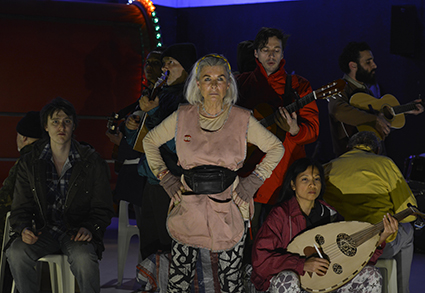
Robyn Nevin and cast, Mother Courage, Belvoir Theatre
photo Heidrun Löhr
Robyn Nevin and cast, Mother Courage, Belvoir Theatre
Belvoir: Mother Courage and Her Children
Eamon Flack’s Mother Courage for Belvoir is Brechtian by the book but lacks the dynamic of tough intellect and emotional passion that might make it work in a culture like ours, often indifferent to the endless wars being enacted around the globe and their refugees. It’s a no-risk production, subtle in actorly detail—excellent for close-ups were it film—light-on musically and determinedly ordinary in appearance with its ‘we’re not having a set’ design and its ragbag of daywear costumes. This postmodern liminal ‘we’re not anywhere in particular’ universalism tells us nothing in a period of horrendous specificities. Nor is anything added by translator Michael Gow’s light dusting of the text with Australian English.
Brecht’s play warrants a production with gravitas, which when savagely undercut will catch us out politically as we swing between empathy and repulsion. From that should come a vision that is not simply a humanistic ‘people are like that’ response. Robyn Nevin’s Mother Courage is finely realised if not allowed great scope while Anthony Phelan as the Chaplain, who learns that he has become a better person the worse the circumstances, and Emele Ugavule as the mute Kattrin provide some of the emotional intensity which is otherwise intermittently felt from an essentially strong ensemble. These are not the times for a low church, user-friendly, Marxist-lite Mother Courage. And, lest we forget, Brecht wrote a tragedy.
STC: Love and Information
Kip Williams’ realisation of Caryl Churchill’s Love and Information is a far more disorienting experience if likewise short on extremes, so that the whole is more dream than the nightmare it could be, a condition exacerbated by having a small cast who quickly grow more familiar than would the at least 16 or many more actors that Churchill prefers. For a play so alert to the byte-size realities of the digital age, Williams’ production is charmingly ‘analogue.’ The design magic required to manage the huge number of brief scenes and segues is realised by the actors, tightly choreographed, sliding large blocks around the white-box stage into ever new permutations—from museum plinths to swimming pool to cemetery—and by the dextrous lighting, with its eerie pastels.
Churchill has provided director and actors with exquisitely crafted short, context free, realistic monologues and dialogues without character designations but with a disruptive, Zen-ish acuity of observation. The playwright has patterned her micro-fictions but allows the makers of her work freedom to cluster and juxtapose many of them. In this production, for example, there’s an unnerving series focused on memory (a key subject overall): someone whose memories are solely of television shows; another whose pop culture recall is astonishingly precise; a post-coital pair of ex-lovers whose recollections of their time together are totally out of synch; a woman who uses a Renaissance technique to organise her memory and suddenly has an unsettling vision of her father in a dressing gown when she was four (and she can see her own feet); a severe dementia patient who can’t speak but plays the piano; and someone who can’t shake a traumatic event. Other scenes focus on delusions: a roadworker who hears God is asked, “Does he speak with an English accent.” A man who receives messages via traffic lights in reminded that he’s ill. Another is castigated by his partner for having virtual sex: “She’s just information.” “But the sex is great,” he retorts. Elsewhere information is enigmatic; a woman going into hiding is told, “You’ll find you can feel when it’s raining.” There are passages about gene science, evolution and metaphysics (to which a worker retorts, “I don’t mind not meaning anything).”
Towards the end of Love and Information, Williams’ ramps up the intensity—an astronaut appears (to prog rock accompaniment), red flowers add alarming colour to a funeral in falling snow (“He must have been everything to you.” “I don’t know. We’ll see”). Barely explicable violence is enacted on a man whose only difference appears to be his affection for a stone. It’s not as if Williams is attempting to make one big conceptual picture (the modular set design offers the requisite cogency); that would, first, deny the audience the opportunity to step back and see more clearly what we are faced with every day in our culture and, second, limit the work we have to do to read the thematic threads of Churchill’s writing inventively realised by director and actors.
This production doesn’t electrify, as one feels it should, but it serves as an admirable introduction to the play, if only more companies would commit to playing more Caryl Churchill in Australia.
Love and Information is an important play that not only reflects the fragmented nature of our culture but also refuses to engage conventionally with the issue. Instead it makes sense of and takes advantage of that fragmentation by offering theatre artists, and thereby the audience, the opportunity of a grand collaboration.
PACT, Afterglow season: The Great Speckled Bird, direction, design, text, performer Ryan McGoldrich, performers, music Claire Stjepanovic, Steve Wilson-Alexander, PACT, Sydney 17-20 June; STC, Battle of Waterloo, writer Kylie Coolwell, director Sarah Goodes, design Renee Mulder, Wharf 1, 5-27 June; Belvoir, Mother Courage and Her Children, writer Bertolt Brecht, director Eamon Flack, designer Robert Cousins, from 10 June-26 July; STC Love and Information, writer Caryl Churchill, director Kip Williams, design David Fleischer, lighting Paul Jackson, Wharf 1, Sydney, 9 July-15 Aug
RealTime issue #128 Aug-Sept 2015 pg. 34-36
© Keith Gallasch; for permission to reproduce apply to realtime@realtimearts.net
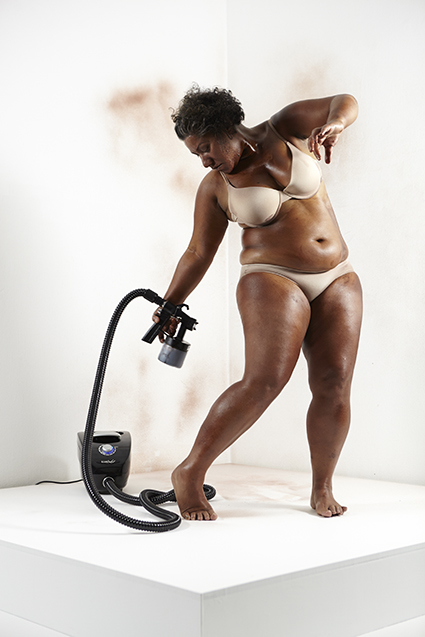
Latai Taumoepeau, Dark Continent (2015), 4A Centre for Contemporary Asian Art, photo Zan Wimberley
If, like me, you are tired of continual references to Euro-America in local performance art discourse, then you would have relished 4A Centre for Contemporary Asian Art’s 48Hr Incident. Perhaps one day the notion of an Asian Australian gallery in Sydney’s Chinatown will be tautologous. More than 20 years after its inception, the gallery remains a vanguard, a much needed touchstone of the land we live on, its regional location and the specifics of art from these places.
From the incidental to the durational, via theatre, ritual and duress, 12 works unfolded over one weekend. The accent was on politics and the social frameworks constraining individuals. A broad theme, loosely applied.
The opening performance, Sydneysider Latai Taumoepeau’s Dark Continent, took place in the corner of the ground floor gallery to an audience that extended through the large vitrines to busy Hay Street. Taumoepeau sprayed herself with fake tan in half hour segments throughout the weekend. When I arrived 20 minutes into the first layer, her Tongan skin was already much darker. Seemingly insouciant, focused on the task, Taumoepeau led this benign procedure into ‘darker’ waters, shining a light on our absurd hypocrisies around skin colour. We want to be suntanned but privilege whiteness, a throwback to Europe where suntans signify wealth and health, not everyday life as they do here, even ill health in extremis. The darker the skin, the greater our discomfort, echoing Taumoepeau’s physical experience with the material, unforeseen.
A consultation with a beautician didn’t give her much idea. (“What do you want to do that for? You’re already black!”) She didn’t wash for 48 hours, the accumulated tan so uncomfortable it was difficult to sleep by the second night. From the pub across the road, we watched her unroll her swag on the little dais, the walls behind stained dark now as well. From one simple gesture, layers kept unpeeling: the variation in black, compelling us into the spectrum, away from spurious binaries; into the pain, the spectacle, the self-conscious crafting of this envelope, skin. The paradoxical desire for blackness in a continent whose greatest tragedy is its expunction. By Sunday, Taumoepeau was mahogany-black. Funnily enough, one person I spoke to, who did not know her, had no idea this was not the artist’s usual skin colour.
Artist Fran Barrett’s wrestle with curator Toby Chapman continued the sense of spectacle. On a blue and red square of padded mats, audience in the round, the wrestle was the culmination of 10 weeks training with an Australian champion. A woman of considerable strength and prowess, Barrett nevertheless was in a lower weight division than Chapman, even if the sport is skills-based. By nominating a doubled artist fee as her prize if she won, was Barrett giving herself an even chance? Or making a wry comment about the intrinsic vulnerability of the artist? Chapman, the curator, could only lose his honour.
Salote Tawale kicked off the Saturday program with an exuberant dance to a soundtrack of Fijian lali (wooden drums). Her troupe in casual black, with masks of cardboard, some with audio tape hair, had the audience whooping and rising to join them. A joyous reminder of the ancient, extant rituals that underpin so much performance here.
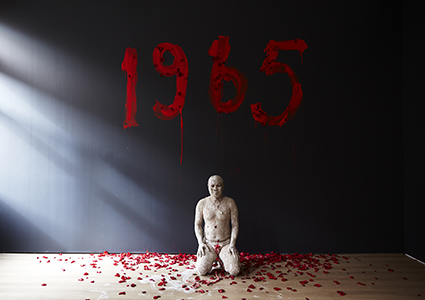
Dadang Christanto, For Those Who Have Been Lost (1993/2015), 4A Centre for Contemporary Asian Art
photo: Zan Wimberley
Dadang Christanto, For Those Who Have Been Lost (1993/2015), 4A Centre for Contemporary Asian Art
Northern Rivers-based Indonesian artist Dadang Christanto reworked prior performances. An interdisciplinary artist, and teacher, his work had a strong theatrical element. Tooth Brushing saw him dressed in white at a white table, cleaning his teeth with vivid red mash resembling gore. For Those Who have Been Lost commemorated victims of the Indonesian anti-communist purge which saw half a million killed. The artist daubed ‘1965’ in huge red letters on the black wall, covered himself in white clay, then strewed red petals onto the wet paint and across the floor.
Traces accumulated in the gallery, the most imposing from US-based Australian artist Tony Schwensen’s long durational performance Scabland. Schwensen’s performances often proceed through tasks enacted in a seemingly casual manner, crystallising in the memory with rare conceptual clarity. Scabland plied his erstwhile themes of labour, leisure and Australian working class masculinity. From sheets of plywood he cut two metre tall letters and screwed them to the wall, then painted around them in white. Over several hours, down the length of the gallery, he stencilled LABOUR IDEOLOGY. Schwensen inhabits his performances as an everyday bloke, open to the vicissitudes of the day, temporal and human. With the sawing over and our earplugs removed, he talked as he worked, about the best jobs often being those where you do nothing, such as one held with telco Optus: “Y’know, I’d work it so it looked like I was really busy, then I did nothing all day. ‘Maaate … flat out.’” “What was your worst job?” “Cleaning for the Navy. They inspected every toilet …”
Scabland unfolded as a paradox of futility, the labour of the artist evident all the same. There was a touch of nostalgia for the days of a working class skilled in fabrication, and a snook cocked at the dilettantish home improvers of real estate-mad Australia. I only wish Schwensen had continued til 1am as promised, but he had worked hard, mate, so an early knock-off was fair enough.
The following day, Pakistani artist Abdullah M I Syed ate money for lunch. His assistant Amanat Grewal served him two Pakistani rupee for entrée, 20 US dollars for main course and one Chinese yuán for dessert. In a sharp suit at a crisp white table, with a slightly overdetermined script, Syed diligently chewed his way through all the currency, the US notes proving especially difficult due to the sheer quantity. The inevitable retching and disgorgement was viscerally powerful and carried surprising pathos. The money was washed and distributed to the audience.
Returning to the gallery for the finale on Sunday night, I found the street echoing with music so loud I thought a band was on at the Capitol Theatre. Upstairs, in the black gallery with its punky stencils and Dadang Christanto daub, a Metallica covers band from the suburbs was going off. Wok the Rock, an artist from Yogyakarta, had commissioned them to play a set list, punctuated by his recounting of a riot at a Metallica concert in Jakarta. In 1993, incensed by exorbitant ticket prices, fans set fire to cars and a shopping mall, then stormed the stadium. Heavy metal concerts were subsequently banned.
Joko Widodo, the new president, is a metalhead—who knew?—and someone in whom both 48HR Incident’s Indonesian artists hold hope, despite the recent execution of drug traffickers (Wok hit a low point when he blamed Widodo’s decision on the president’s mother). The rock scene in Indonesia is massive and has liaised with Australian musicians for years, making Jakarta Whiplash an ideal finale. Part politics, part hedonism, it maintained ambivalence about the riot. The merchandise sold by Wok’s collaborator Lara Thoms, which included some of the rocks thrown, was a witty riposte to the commodification of activism. (Sydneysiders who paid $130 the same night to hear Grace Jones through a bad sound system could have done with those rocks—more to the point, the guts to use them.)
48HR Incident was the third and final—and for me most successful—component of MASS GROUP INCIDENT, a series of exhibitions that investigated the place of the individual in relation to the communal, with emphasis on political action and art with a social conscience. It was vibrant and provocative with an easy reach across region and generation. I can still hear Samson Young’s Nocturne, a soundtrack of war that ended the first day. From a large drum, and sundry materials including dirt, leaves and cornflakes, this Hong Kong artist generated eerie audio for video clips of Gaza and the Gulf War. Transmitted through little radios, unsettlingly beautiful, it stayed with me long into the night.
–
48Hr Incident, 4a Centre for Contemporary Asian Art, Sydney, 29-31 May
RealTime issue #128 Aug-Sept 2015 pg. 33
© Fiona McGregor; for permission to reproduce apply to realtime@realtimearts.net
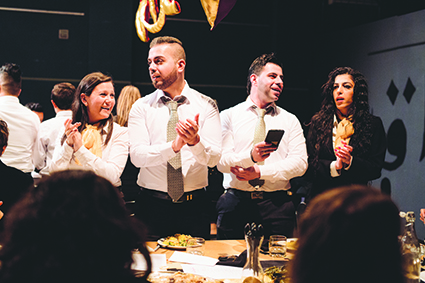
Choir of Love, Little Baghdad
photo courtesy Powerhouse Youth Theatre
Choir of Love, Little Baghdad
The first of three of Powerhouse Youth Theatre’s The Long Table gatherings was a gloriously celebratory cultural event. Titled Resilience and Rituals, it gathered together immigrant groups from across Iraq, each with their own distinctive culture—language, music, dress, cuisine—and exacting stories of loss and survival. This made for a uniquely cross-cultural event framed by the meeting of Iraquis with fellow Australians over a wonderful traditional meal.
The Long Table combined the sharing of food with live music, talks, films, poetry, song and conversation. Discussions bounced around the two tables in the crowded room or took place face to face between new acquaintances. Young poet Reewan Al-Mari, bringing together Arabic and English poetry and rap, declared himself “comfortable in both worlds, East and West.” From time to time, sitting among us, the stylish young Choir of Love (led by Bashar Hanna on keyboards with a very fine oud player) stood to sing with considerable verve traditional and other songs with the audience sometimes joining in.
A sense of generational heritage pervaded the evening. With her daughter translating, Suham Al-Sabti described her teenage desire to be an actress, only to be thwarted by her brother who broke the high heels off all her shoes and made her promise not to act until she’d finished her studies in three years’ time—which she did until becoming one of Iraq’s most famous actresses, frequently playing the ‘mother’ role. Her daughter, Yassmen Yahya, now president of an Iraqi religious minority association in Australia and a worker for STARRTS (NSW Service for the Treatment and Rehabilitation of Torture and Trauma Survivors), spoke with pride of her life in Australia but also of lives ruined by war in the Iraq she left behind as bombs fell every 10 minutes. Her own daughter, Sarah Yahya, spoke in turn of her grandmother’s life in Iraq’s golden age and the loss of careers for a generation of progressive women like her mother. She herself spoke ambitiously of a career in international journalism, observing that people still quiz her freedom to travel as a young woman.
Potent coffee and sweet tea were served by cheery middle-aged men in traditional costumes from a variety of regions. Food was provided by The Parents’ Café, a remarkable, small but highly effective organisation that assists newcomers to adjust to Australia with aged care advice, workshops, excursions and even lawn-mowing for men.
We watched a film by Iraqi-Australian Zahra Alsamawi, shot from within a car in Baghdad at night, passing from checkpoint to checkpoint, the places most vulnerable to bombings. As violence diminishes in the city, forgetfulness can creep in. Nonetheless she feels anxious. Later in the evening she speaks to us via Skype from Iraq (during Ramadan, in 50-degree heat, the streets empty) where she is spending time with other independent filmmakers.
Activist artist Zanny Begg leads us all in a drawing exercise in which, in threes, we create a hybrid beast, folding paper so we can’t see what the others have drawn save for the points at which the body points must join. The creature is meant to be inspired by a mythical legless “bird of compassion,’ the Homa, which, like refugees, is always in flight. Begg disappears with the results, returning later to project them as magical 3-D-ish figures, witty and weird. The format relates to drawing program, Undrawing Borders, the artist and collaborators have conducted in the area including in detention centres.
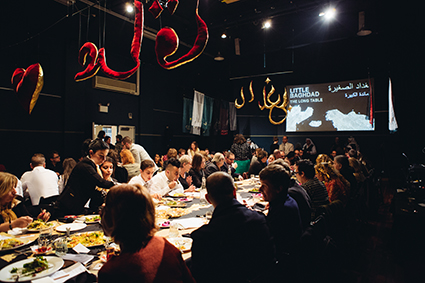
Little Baghdad
photo courtesy Powerhouse Youth Theatre
Little Baghdad
Hanging above the elegantly laid tables were beautiful letters made of organza and gold applique spelling out “Baghdad” in Arabic. These were made by a local sewing group, dressed in accompanying joyously bright colours, from The Parents’ Café. Each woman was responsible for the making of a letter true to her own handwriting, as we saw demonstrated on projections. In their midst sat a sombre woman in black, their leader, whose tale we now heard. In 2012, a terror bombing in a church killed her husband, son and relatives. With her three daughters she came to Australia, to a new life: “We have hope.”
Many stories are told on this night. I ask a man next to me the meaning of a song. He explains that he’s an Assyrian speaker with no Arabic. He tells me of his four-year journey as a boy to become an Iraqi-Australian.
It would be wonderful if more Australians could enjoy this kind of informally hosted, adroitly programmed coming together, this sharing of stories both sad and positive that raise cultural awareness and build empathy. Thank you, Powerhouse Youth Theatre.
Powerhouse Youth Theatre, The Long Table, Little Baghdad, The Choir of Love, Fairfield Arts Centre, 25 June
RealTime issue #128 Aug-Sept 2015 pg. 31
© Keith Gallasch; for permission to reproduce apply to realtime@realtimearts.net
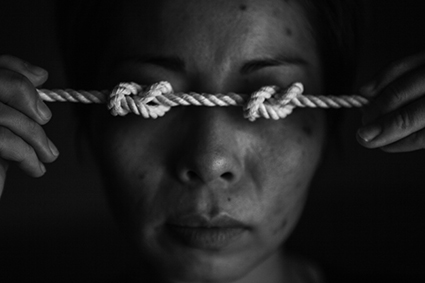
Spectra, Dancenorth and Batik, OzAsia Festival 2015
photo Amber Haines
Spectra, Dancenorth and Batik, OzAsia Festival 2015
Alongside immersive works like The Streets and Japan’s Miss Revolutionary Idol Berserker —“a frenetic spectacle of hyper-real pop music and dance” [program] that will require audience members to don protective raincoats—another key feature of this year’s OzAsia program is an emphasis on cross-cultural collaboration.
One such work is Spectra, by Townsville-based contemporary dance company Dancenorth and Japanese Butoh collective Batik. Spectra is choreographed by Kyle Page, who became Dancenorth’s first Artistic Executive in January this year following a long relationship with the company. During the work’s first stage development in 2014 it was called Engi, a portmanteau combing two Japanese words suggestive of, according to Page, “this idea of causality, one thing leading to another.” It is this idea—the Buddhist precept of interdependent co-arising (Pratityasamutpada in sanskrit)—that is at the core of Spectra.
“I’m not a Buddhist in any sense,” Page explained to me, “but the philosophy really struck a chord. In very basic terms, dependent causality is about how one thing leads to another. The thing I find really beautiful is when you strip that notion back, or look through the history of your own experience of life, there are various points that I can clearly define—and I think everyone can—that have catapulted you or directed you towards where you are now, in this moment. From that, you can possibly imagine alternate options or decisions or collisions, relationships or experiences you may have had that you learned various things from that could have sent you on a different trajectory.”
I asked Page how this idea is reflected in Spectra’s form. “There’s kind of a full gamut,” he shot back in his curious way—somehow rapid and luxuriously considered at the same time. “The Japanese dancers have a really amazing creative capacity in a different way from Australians, so I think we explore pretty broad choreographic devices in the work—the Japanese dancers have classical and contemporary but also Butoh training, so we mesh those worlds and those physicalities. The thing I love about Butoh,” he continued, “is that we’re bringing into the work the idea of sourcing the material as well as the delivery from a place of intention as opposed to narration. So instead of saying ‘this is what you’ll do and you’ll do it like this,’ you say ‘this is what that feels like and that becomes this.’ That’s an interesting mechanism for delivering something that’s very true or real or raw.” After a brief pause, he added: “You can see a very clear thread through cause and effect which is a very basic choreographic principle, but it works well. There are also set design elements, we work with rope a lot and its rippling, coiling effect on stage is just amazing and really beautiful, a really simple and elegant display of the concept.”
The design is by the revered Japanese digital artist Tatsuo Miyajima, who, Page effuses, “is insanely famous. He’s got work in the Tate and the Guggenheim and all around the world.” Page first encountered Miyajima’s work at an exhibition at SCAI The Bathhouse in Tokyo where, having gained permission from the gallery director, he and his partner Amber Haines, who is also a dancer, improvised and took photographs in front of some of the artist’s installations. Impressed by the results, Page then spent three months persuading the problematically busy Miyajima to contribute to Spectra. Unexpectedly, and in an oblique reflection of the work’s theme, it transpired that Miyajima shared Page’s interest in the key Eastern philosophical idea of interconnectedness. “It’s kind of amazing,” Page commented, once again deploying his favoured adjective, “because that in itself is kind of the whole point of the work—that various collisions or chance meetings or relationships lead to your future experience of the world. There’ve been a lot of moments throughout the creative development that have highlighted what we’re trying to explore in the piece.”
Miyajima’s set—conceived, Page told me, during a “weird meltdown that lasted for about two minutes”—is called Forest of Time, and consists of fifty LED counters suspended from a single wire at various points and heights around the stage. These counters flick between the numbers one and nine (there are, in keeping with the belief that the idea of zero is a solely Western concept, no zeroes in Miyajima’s work) at a range of speeds, some so rapid they will be all but unperceivable to the audience, others sufficiently slow to convey the incremental passing of time.
Live music will be provided by another Japanese artist, Jiro Matsumoto, about whom Page was equally enthusiastic: “He’s a wonderful composer, classical guitar-trained but he’s also played in punk bands around the Japanese underground. He’s really virtuosic and very versatile in his range. He plays live with about six loop pedals and he’s got various things recorded that he interjects and plays with and manipulates live on stage. He creates a really cinematic experience, both for performers and audience. It’s always great dancing to live music and I think the audience will get to feel that direct interplay and exchange between the dancers and the musicians. While it’s fairly set, there is movement within the framework to extend or shorten things or change the dynamics in any particular scene.”
Spectra will play in the Adelaide Festival Centre’s Space, a small, flexible studio theatre that, nevertheless, seems far removed from Butoh’s more customary settings—unconventional spaces like skid rows, cemeteries and harsh natural environments in keeping with its essential subversiveness. “I think that’s exciting,” Page responded, “because we’re not delivering a Butoh performance but we’re using the intention or integrity of that practice to convey something powerful to the audience. I think the intimate setting of the Space Theatre is perfect for us to deliver that very tangible, very real sensation of exchange between the performers and the audience. Intimacy will heighten that exchange, as opposed to being in a massive proscenium arch where you’re projecting 80 rows to the back.”
OzAsia Festival, 2015, Spectra, Dancenorth & Batik, Space Theatre, Adelaide Festival Centre, 29 Sep-1 Oct
RealTime issue #128 Aug-Sept 2015 pg. 22
© Ben Brooker; for permission to reproduce apply to realtime@realtimearts.net

Igneous performance: James Cunningham and Suzon Fuks
photo Alan Warren
Igneous performance: James Cunningham and Suzon Fuks
Fluidata is the latest project by Brisbane intermedia artists Suzon Fuks and James Cunningham whose long-standing partnership Igneous produced this installation at The Block in the QUT Creative Industries Precinct. It’s the installation component of Igneous’ long-standing exploration of water as a topic and a metaphor through their Waterwheel project.
This is very considered and deliberate art-making and you feel that sense of solemnity and purpose in the installation. Walking into the black vaulted expanse of The Block you are first struck by a projection which cuts through the space at a 180-degree angle from ceiling to floor and then up the entire length of the opposite wall. It is an impossible river of scrolling encryptions, data recorded by Fuks and Cunningham as they traversed the 663 waterways, drove the 7,500km and walked the two dozen creeks that make up the entire footprint of this enormous project in Central Western Queensland.
You turn a corner and meet curving black flats and a small nook, which invites you to listen to a guided meditation. This entreaty to “slow down, to meander” is an essential part of the installation. Fuks and Cunningham clearly feel such a strong custodianship of the rivers they walked through so slowly and so carefully that they cannot bear the thought that you do not get to experience the sense of durational spirituality that they did.
This is reinforced by curator Rachel Parson, whose thoughtful and considered curatorial essay frames the journey of Fuks and Cunningham in the tradition of “the groundbreaking experimental soundwork of John Cage in the 1950s and 1960s.” She suggests that the artists’ slow and intricate walking “becomes a symbolic gesture, a way to absorb the memories, movements and scars of the landscape…that leaves no lasting trace, becoming another memory within the historical and ongoing shaping of the land by environmental and historical forces.”
There is a sound installation based on the nature of walking and balance in the larger dramatic space of the main exhibition which is dominated by the projected map of Fuks and Cunningham’s travels, a kind of twiggy, arching artery across the back wall. Beneath it, Cunningham performs live an ultra slow and stately walk. In the immediate foreground a wall of video monitors lights up on touch, offering elongated vistas of creeks. On the other side of the installation is a collection of tiny bottles with water from each of the creeks walked: Ross River, Coppermine, Cloncurry, Condomine, Emerald, Miles, Blackwater and Nettle Creeks. And there’s a small bed of sand with discarded objects collected along the way.
Parsons ends her essay by urging patrons to accept the strong invitation of the work to “take time…find a resonance between the body and the various technologies…to experience depth and details…to commit to the meander.”
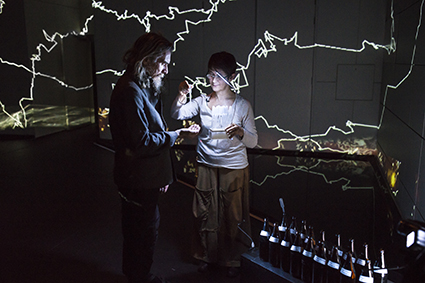
Igneous performance
photo Alan Warren
Igneous performance
Indeed, while the large-scale installations that demonstrate the statistics and demographics of the project, like the map and the river of data, were genuinely impressive, the parts of the installation that truly resonated for me were not grand or cartographical. I fell in love with the tiny, intimate pieces of documentation that felt almost like secret insights or rewards for the patient endeavours of these two artists on their long and contemplative journey.
In the large square room, with its stations reminiscent of a regional museum display, a series of low-set black boxes curved a gentle path through the centre of the installation. Although square, these boxes felt like bird baths, or scrying bowls that glowed with light and sound. Some contained recordings of interviews with local farmers, councillors and other folks met along the way. I had no urge to actually listen to the stories, but I so enjoyed hearing snatches of their voices as I walked past.
Other bowls had iPads nestled inside, flashing close-up images of more tiny details of landscape like knots of wood that looked like horses’ heads. These smaller installations invited an embodied participation, a leaning in and sitting patiently; watching the tiny beauty of an unfamiliar landscape and engaging with it tipped me into a kind of reverie. I left the installation feeling as though I had received a massage. I suppose, to quote Suzon Fuks and James Cunningham, I had experienced what they wanted me to: deep time.
Read the interview with the FLUIDATA artists in RealTime Profiler 10.
FLUIDATA: an explorable installation by Igneous, QUT Digital Associates Program, The Block, QUT, Brisbane, 13-20 June
RealTime issue #128 Aug-Sept 2015 pg. 23
© Kathryn Kelly; for permission to reproduce apply to realtime@realtimearts.net
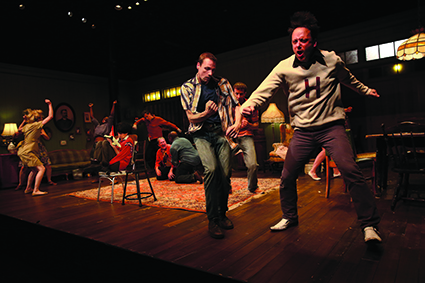
The Sound and the Fury, Elevator Repair Service, Public Theater, New York
photo Paula Court
The Sound and the Fury, Elevator Repair Service, Public Theater, New York
It’s summer in New York and all the locals are elsewhere, leaving the tourists to ask each other for directions. Pickings are also slimmer than you might expect when it comes to performance. Nevertheless, I manage to catch three shows that encapsulate trends within contemporary performance: immersion, interaction, adaptation and verbatim.
Punchdrunk, Sleep No More
Sleep No More opened in London in 2003, Boston in 2009, and then New York in 2011. It’s UK company Punchdrunk’s signature production and has become a touchstone within contemporary debates about immersive, participatory and promenade performance. It takes place in three converted warehouses that have been renovated and renamed the McKittrick Hotel, a fictional venue that was—so the story goes—completed in 1939 just before the war broke out and had to be closed.
Whatever else you may think of Punchdrunk, they have mastered the art of anticipation. Like a secret club, there is a long line, a surly security guard, a stamp on the wrist and a cloakroom. You are invited to leave everything behind except, of course, your cash or credit card, which you’ll need to purchase drinks at the bar. We are slowly ushered into said bar, where a band plays, another line forms and preposterous gentlemen introduce themselves as Balthazar and call you darling. It’s all very mannered so far. A small group is called forward into an antechamber, given white masks and escorted into the elevator. The operator goes through the rules of the game before stopping at one floor and shoving a female patron out the door, leaving her startled friend to ride on alone. Eventually we disembark into a dark, wordless world, loosely based on that of Macbeth.
It helps to be familiar with the play, but even without it the performance would register at the level of atmosphere and affect. The set is both impossibly large (multiple floors, over 100 rooms in total) and incredibly detailed (drawers full of detritus and letters on desks, all of which you can rifle through). I think I am on the fifth floor but, disoriented, not entirely sure. There’s a room of empty hospital beds, another with empty baths: both are staffed by attendants in black masks. In a tiny office, a nurse in a starched cap carefully scissors words from a medical dictionary. The white masks create a mobile fourth-wall: no matter how close spectators stand, she does not acknowledge or interact with us; when she moves, we are expected to get out of her way, a domineering dynamic that recurs throughout the performance. I leave to get lost in a forest.
On other floors (I lose track of which), there are bars, taxidermists and detectives. I miss some of the “moneyshot” scenes that the publicity advertises but I do catch a large and spectacular waltz. Elsewhere the choreography is muscular and athletic, reminiscent of contact improvisation: the dancers throw themselves at each other as well as against the furniture and the wall. It’s a bit repetitive and two spectators start mocking it in a corner, imitating some of the moves. Not for long though, as they are set upon by the black masks almost immediately.
Despite its dramaturgy of anticipation, seduction and immersion, I am not fully won over by Sleep No More. It seems to produce in its spectators a sort of performance of mindless pursuit, following where everyone is going. Several times I am engulfed in, trampled by or witness to a mob of spectators sprinting through the corridors. Despite advertising itself as a choose-your-own adventure affair, Sleep No More is immersive but not interactive. Finally, I found the production too similar to the company’s recent take on Woyzeck, The Drowned Man (2014). The plays share some similarities, but the Punchdrunk retro 1930s aesthetic renders them more alike than they actually are.
Elevator Repair Service, The Sound and the Fury
The Scottish play provides an unexpected link between Sleep No More and The Sound and the Fury via the line “a tale told by an idiot.” First performed in 2008 (also Adelaide Festival, 2010), this is the second in a trilogy of literary adaptations from Elevator Repair Service, the first being Gatz (2004) and the third The Select (The Sun Also Rises) (2010). Whereas Gatz performs The Great Gatsby in its entirety, The Sound and the Fury focuses on the first section, April Seventh, 1928, also known as “Benjy’s Chapter.” Benjy would be probably categorised as differently abled these days, but in Faulkner’s novel, published in 1930, he is described as a man who’s been “three for 30 years.”
The wide stage is almost cinematic in ratio and the set almost symmetrical, recalling Wes Anderson’s planimetric shots [as in non-topographic maps. Eds]. The action is framed by two wide architraves: on the left are a drinks cabinet and faded settee, scene of the occasional snuggle and nap; on the right, there’s a kitchen table, scene of many a messy meal, a birthday and a few showdowns between Dilsey the maid/matriarch and the Compson children. The middle of the stage is left empty but for a faded rug; further upstage are two armchairs, an assortment of floor lamps and picture frames hanging on a green wall.
The performance proceeds as the chapter does, out of chronological order. In addition, the actors rotate through various characters, with the exception of Benjy who is mostly played by Susy Sokol. It’s not hard to follow who’s who, firstly because they almost always follow their dialogue with “Caddy said” or “Lester said,” as in the book and secondly, because they are always wearing a signature garment, eg whoever is playing Mother wears a voluminous white nightgown and sunglasses. These are not the only gestures towards theatricality: the naturalistic action is also interspersed with stylised movement, including choreography that looks like a line dance gone wrong. When the frantic activity subsides there are also moments of still grace, such as when the family gathers around Benjy to calm him. For the most part, he stays silent, watching the family or the fire, which is in fact an image of a fire on a glowing LCD.
The Sound and the Fury is beautiful, mind- and time-bending: parts of it seem to stretch for hours, while other moments fly by. For me it doesn’t reach the heights of Gatz, but this might have more to do with the timing of the productions more than anything else. I saw Gatz in the Sydney Opera House in 2009, just as our own jazz age had come crashing down in the financial crisis. While Australia suffered moderately compared to the rest of the world, there was still a sense that the party was over and the reckoning was to come. Faulkner is probably telling older truths, or more timeless ones about family, memory, inheritance and history, but on this particular evening they seem less urgent. Perhaps if I had seen it in 2008, I might feel differently.
Ilana Becker, Argument Sessions
From a verbatim reading of Faulkner’s prose to a verbatim reading of SCOTUS (the Supreme Court of the United States) transcripts. Created and directed by Ilana Becker, Argument Sessions is part immersive and part tribunal theatre. It’s immersive in the sense that both the audience and the actors are in a cabaret setting, with the actors revealing themselves one by one throughout the performance, usually when they interject to counter another character’s argument. It’s tribunal in the sense that it takes the transcripts of the Obergefell vs Hodges (2015) case and delivers all of the arguments for and against same-sex marriage in all of their complexity.
There are both theatrical and structural difficulties to this task, which Becker navigates with finesse. The theatrical problem lies in how to present the arguments of the court without lapsing into documentary theatre’s more predictable and naturalistic tendencies. The production resolves this problem not only via the cabaret setting but also through the unexpected use of song and the occasional moment of spectacle. The political problem lies in that familiar accusation of “preaching to the converted.” I doubt that many, if any, audience members need convincing, so why are we listening to this argument? Perhaps, like preaching, the performance is rehearsing the arguments of the non-believers, partly to understand them and partly to refute them; these refutations, in turn, reaffirm a faith that might be waning in the face of frustrating opposition.
That faith is rewarded just two weeks later on June 26: Argument Sessions was performed on 15 June, two months after the case had been heard by the court on 27 and 28 April but two weeks before it had delivered its judgement that, yes, the US Constitution does guarantee the fundamental right to marriage to same sex couples. Staged in the liminal moment between hearing and finding, Argument Sessions takes its place as the latest in a long line of artworks that prepared the ground for this huge legal and cultural decision.
Performances: Punchdrunk Productions, Sleep No More, The McKittrick Hotel, from 13 April; Elevator Repair Service, The Sound and the Fury, The Public Theater, 14 May-12 July; Ilana Becker, Argument Sessions, Ars Nova, New York, 15 June
RealTime issue #128 Aug-Sept 2015 pg. 24
© Caroline Wake; for permission to reproduce apply to realtime@realtimearts.net
Making documentaries in Australia has never been easy, but the recent cuts to Screen Australia’s allocation for documentary funding must make it even more difficult. Earlier this year Screen Australia also changed the guidelines for its new suite of documentary programs, further disappointing the documentary community. The overall allocation for documentary has dropped by $1.1 million, but changes to programs mean that there is more competition for the reduced funding, with innovative documentaries with a strong creative vision having to compete with more mainstream feature documentaries and projects that have international finance. There is however more access for low-budget projects from early career filmmakers and works with low pre-sales from broadcasters.
Documentary makers are tough, enterprising and productive; the number of Australian documentaries screened at this year’s Sydney and Melbourne film festivals was impressive, as was the range of subjects and the way in which those subjects were approached. So it’s not really surprising that documentary is still a thriving part of film education, although just how documentary is defined seems to be constantly changing; as Dr Karen Pearlman, Lecturer in Screen Production, Department of Media, Music, Communications and Cultural Studies at Macquarie University says, “If you look at the history of what we know as documentary, you see that changes are constant; it both responds and creates in an ongoing process.”
At AFTRS, as part of the new, three-year Bachelor of Arts (Screen), now in its first year, the documentary strand has been re-named Factual, although Rachel Landers, Section Leader of Factual, has already discussed a further re-name, to Non-Fiction. As she says, “The term Factual is a bit problematic; it seems to define particular types of industry practice (including things like quiz shows) and it excludes as much as it includes. Non-Fiction is wider, more inclusive.” But, as Dr Peter Hegedus, Course Convenor of Master of Screen Production and Documentary Production, Griffith Film School, Queensland College of Art, points out, as many of the employment opportunities for students will be in the area of Factual TV, “it’s important for students to understand that to find a job, it’s better to look in that direction.”
While undergraduates tend not to come with pre-conceived notions about documentary, Karen Pearlman says that “a significant number not only discover documentary, but choose to embrace it.” And Dr Andrew Taylor, Discipline Co-coordinator & Senior Lecturer, Media Arts & Production, Faculty of Arts & Social Sciences at University of Technology Sydney, says that “one of the main things is to combine theory and practice—let them learn something about documentary by both seeing films and making things. We open their eyes to documentary; let them see what makes a documentary, that it’s not just television reportage.” Peter Hegedus says that many of his students initially see documentary as the poor cousin, “It’s our responsibility to outline the qualities and attributes of documentary, how it’s all about story, the creative treatment of actuality and to explore the possibilities of that.”
At AFTRS, Landers says that the BA is “about big ideas, big notions about storytelling modes—all kinds of storytelling.” And for documentary, which will be one element in the course that all students will take in their first year, “they will look at the big picture, about telling the non-fiction story, and why it’s important.” Where students who choose documentary (or Factual or Non-Fiction) as an elective in their second year, then go is still being discussed. “We’re developing courses as we go, but it will be much more practically oriented,” says Landers. She explains that all the different disciplines of the school are engaged in a debate—“we’re still thinking deeply about where our graduates will be going, where these still quite young students will fit in the industry. Are they going to be platform agnostic? Will they have multiple skills? The BA is about people wanting a rich, fulfilling degree. What’s exciting is that this is an opportunity to take stock and think about the future, about where the industry will be in 10 or 20 years.”
Andrew Taylor explains that this year UTS “has let in more students, so you have 120 students; how do you teach them? Open them up to new ideas, to the skills, the thinking, the theory. The knowledge that they learn through documentary will be useful in other areas. There aren’t going to be 120 jobs making documentaries, but those skills are going to be useful in all sorts of other areas, such as TV commercials, corporate work, animation, gaming, online and interactive material, music videos. There are all sorts of possibilities.”
He tells me how students—young, just finished school and entering university—start “by making a series of very low-tech, three-minute biographical documentaries, which could be very personal and poetic, and which are only shown in the safety of the classroom. They are about ideas, there’s no shooting, they just use archival material, but it gives them confidence, and we build towards group work, where they do more short docs, which could be online, or sound only, or even a photo essay—it’s about teaching ideas about working together, about collaboration.”
At Griffith, in documentary production, which has a research component but is very much practice-based, students also start making very short docs of 180 seconds, on the way to making six to ten minute docs which are an exploration of an individual’s life, working with very clear criteria. “They always work in groups that may differ in size but are usually of four or five, and the work is very much about interpretation,” Peter Hegedus explains.
Pearlman says that at Macquarie, “we teach core skills like observation, research, juxtaposition, articulating a perspective, finding a theme, and of course, storytelling.” Students can engage in internships outside the university; one recent project saw a group of students work with a local council having problems with racism, to produce a number of short documentaries on the subject that could be used by the council in a variety of ways. “The students got to deal with the logistics of articulating ideas, of working with stakeholders and of appealing to an audience, or audiences, as well as making contacts in the outside world. In such a project, they might find themselves working with archival material, and interviewing people with stories to tell.”
At Griffith, students are also encouraged to go out and make connections, to interact with the filmmaking community. Hegedus tells of a recent two-week intensive workshop given by Philippe Decaux, a French-Canadian filmmaker based in Queensland who makes newsreel-style news reports for French and German TV from the Asia-Pacific region, in which he encouraged the students to find stories that would work as short, punchy newsreels. “This interaction and connection with the industry is really important, and it’s our responsibility to make sure students understand this.”
At Macquarie, at the Masters level, as Pearlman explains, “we infuse the place with a lot of openness about the possibilities. Students don’t feel limited by ideas of what documentary ought to be. We’re quite focused on hybrids, cross platforms, creating and finding audiences in different ways than broadcast. Hybrids might approach telling a true story with a variety of approaches. Designed documentaries, reconstructions, setting up scenarios and observing the way they play out and montage films are just some of the possibilities. But ethics are also important; students are taught that it’s vital not to say something is real when it isn’t.”
Andrew Taylor sees “the area of postgraduate, research-based projects as somewhere where documentary is really thriving and changing,” explaining that “postgraduate documentary makers are developing ways to make films that are quite different from the increasingly strait-jacketed industrial model, and free from the requirements of broadcasters. It also provides the ability to research with much more depth and a chance to be more formally expressive and innovative.”
While Karen Pearlman refers to the current discussions about robots taking over jobs, and to the argument that the job that is safe is that of the artist, or the creative, she concedes that what we think of as a job is going to shift. “Our students could do lots of things; the skills they learn in documentary production could be important in education, in government, in all sorts of ways,” she says. Peter Hegedus is blunter: “making documentaries is not for the faint-hearted,” he says, “the rewards are usually small, but they can be great!”
RealTime issue #128 Aug-Sept 2015 pg. 26
© Tina Kaufman; for permission to reproduce apply to realtime@realtimearts.net
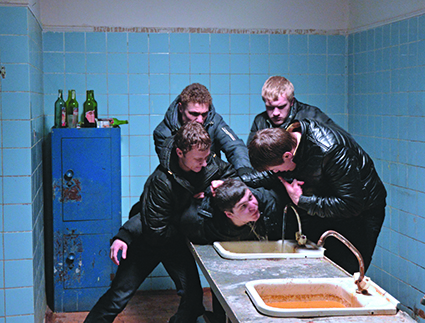
The Tribe
For most people, silence happens when they become conscious of an absence of sound. This doesn’t mean that they have experienced ‘something’ (the presence of silence), but that they have experienced a ‘nothing’ (the absence of sound). Since John Cage’s famous anechoic chamber experiment in the late 1940s, the idea of magically having been born into aural consciousness through a moment of silencing, being silenced or confronted by silence has become a trope of expanded awareness.
A bevy of artistic projects extolling the revelatory powers of silence carry this legacy like sodden baggage, all joined in celebrating the marvellous things that can happen through being aware of the interrelationships between the sonic and the silent. Does Myroslav Slaboshpytsky’s unsubtitled film The Tribe (2014) featuring a group of deaf non-actors perform similarly? Yes—but let’s unpack its aural baggage regardless.
In many respects, The Tribe deserves its accolades. Like so many millennial-crossover neo-globalist critical movies, it is aimed squarely at a film festival context both to impart its message and lever a globalist power position. This is the realm where films defiantly retain regional dress (The Tribe is set in contemporary Ukraine, sited in a dilapidated boarding school for the deaf and the corruptive goings-on in its dormitories after hours) while imparting universalising positivist ideologies (its bleak portrayal of abuse embedded in the school’s educational and social regime is positioned to ‘ring bells’ in nations globally).
Millennial-crossover internationalist film festival cinema revels in the theatrics and hysterics of Dogme-style films bent on brutalising audiences to achieve prescriptive reality effects. The Tribe might have no subtitles and no voicing, but its artistic voice is vociferous in its channelling of ‘brutal’ auteurs like Lukas Moodysson, Vitaly Kanevski, Gasper Noe, Philippe Grandrieux, Michael Haneke, Jean-Pierre and Luc Dardenne et al. Accordingly, it plays out like a pantomime not of the deaf and their tragic circumstances, but of a director and his heroic logistics in staging long Steadicam-shots with a surfeit of choreographed action mostly using available light to label its cinematised results as Art Cinema.
While I could discuss how Miklos Jancso more elegantly deployed choreographed performers and camera tracks to construct metaphoric circles around his silenced/unspeaking actors and performers, I wonder how seriously The Tribe invests in the values and effects of silence. Though the film fascinates with the documentarian-dance of its non-actors whose physical tussling sometimes produces dramatic sparks, its base impulse in storytelling is anthropological. Even though its English title bears this out in contradistinction to the Ukraine title Plemya (meaning breed, race, stock—all with derivations from fire, source, origin), the film eventually resembles a rage therapy workshop conducted for disaffected teens. In this sense, vetoing the audience’s access to dialogue appears designed to symbolise both youth’s deliberation to not speak when spoken to and respectable society’s inability to listen to youth’s symbolic cries for help through destructive and self-destructive acts (numerous of which are catalogued throughout The Tribe).
But what precisely are the material effects of discounting an audience’s comprehension of dialogue in a narrative film? While The Tribe has been championed for its boldly supportive conceit in refusing to subtitle the characters’ sign language, I remain surprised as to how much was conveyed nonetheless by the performers and their direction. For while the cast comprises mostly non-actors, any serious actor would thrill at being handed the task of communicating without language (a thrill especially evident in the Dardennes’ Rosetta, 1999, Haneke’s Time Of The Wolf, 2003, and Grandrieux’s The Lake, 2008). Furthermore, bad acting is mostly signalled by poor, inept or ineffectual vocal delivery. The voice is an actor’s instrument: powerful when performed with masterly control, insipid when its power is ungrasped or unperceived by the performer. ‘Silencing’ an actor often uncannily imparts performative power.
Interestingly, The Tribe’s soundtrack allows us to hear the voices of the deaf. Their soft growling, hoarse rasping, breathy expulsions score their dramatic exchanges. It’s like porn, but (mostly) without the sex and the dialogue. Mixed with this is their bodily slapping, rubbing, grabbing, pushing. Normally, film dialogue recording attempts to minimise this noisy presence as it interferes with dialogue comprehension, but deaf people—not having recourse to audible directives—must tap, hit or thump someone in order to grab their attention. When an argument ensues—arguments being the primary mode of exchange between the school’s enrolees—there’s a lot of fabric-rustling and limb-slapping. A deeper aural symbolic becomes apparent as the film progresses: the deaf sound their world through percussive means, not through harmonic or tonal means. From their continual arguments, stair-trudging, van door-slamming, physical beating, wood shop working and apartment ransacking, they produce sound through violent sonic means. This has deadly repercussions, literally for newcomer Serge, who eventually murders using the blunt percussive instruments of a wooden hammer he made in the workshop and the wooden furniture of the unwelcoming dorm rooms.
But maybe The Tribe is evidencing the paucity of interpersonal communication and the debilitation wrought by social determinism irrespective of whether one is afflicted with deafness or simply unable to read the signs of the new world. The only time we see signs of education is in Serge’s first class early in the film. Tellingly, the teacher discusses the formation of the European Economic Community (the blue square with its twelve stars silently sits at the top right of the frame). For Russia and Ukraine, the EEC—especially since its absorption of the European Community in 2009—constructs a kind of ‘freeze war’ blanketing Eastern Europe, the Baltic States and the former Soviet Union. This is never mentioned again; the only sign of economic enterprise outside of the deaf school is the phalanx of semi-trailer trucks serviced by the deaf girl prostitutes late at night. Symbolically, the trucks transport goods and values neither glimpsed nor enjoyed by the students at the school. The deaf are thus symbols of isolationism and exclusionism as well as ostracism.
But deafness can profoundly exist beyond the determining symbolism of films like The Tribe. In November 2013, The Junior Eurovision Song Contest took place in Kiev, Ukraine. Ukraine’s own entry was “We Are One,” performed by Sofia Tarasova. The travelogue images projected onto HD multi-screen panoramas on the event’s stage showed a Ukraine quite unlike that depicted in The Tribe. As the youth of Europe sang on stage, outside the Euromaiden protests accumulated into divisive and violent foment, as Ukraine became divided on its future alignment with either the EC or the Russian Federation. Watching The 2013 Junior Eurovision Song Contest on SBS-TV in late 2014, I truly felt deaf.
–
The Tribe, director Myroslav Slaboshpytskiy, 132 mins, Ukraine, 2014
RealTime issue #128 Aug-Sept 2015 pg. 27
© Philip Brophy; for permission to reproduce apply to realtime@realtimearts.net
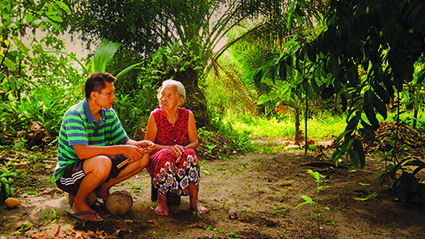
The Look of Silence
Documentaries often tell us something new—revealing this or that fact—but it is much rarer to find a film that makes us question, in provocative and productive ways, human nature itself. Joshua Oppenheimer has managed to do this twice over with a pair of films about the 1965 massacre of communists in Indonesia—The Act of Killing (2012) and his new work The Look of Silence (2015). And the questions he raises are intensely disquieting.
The Act of Killing (RT117, p 12) traced Oppenheimer’s interactions with various aging Indonesian gangsters who participated in the murder of around a million “communists”—a category that included intellectuals, unionists and ethnic Chinese, as well as actual party members—in a paroxysm of violence that ushered in General Suharto’s “New Order” in the mid-1960s. The gangsters proudly re-enacted their part in the slaughter for Oppenheimer in a bizarre series of scenes comprising Hollywood gangster flick clichés and kitsch musical interludes. The Look of Silence is stylistically restrained in comparison, but is perhaps even more unsettling in what it reveals about our relationship to the past.
The new film centres on Adi, an optometrist born several years after the upheavals of the mid-1960s, but bound to those events by a brother who was murdered by local militia. We see him early in the film watching a 1967 NBC news report about the massacre, in which an official explains that the communists in his village, realising “they were wrong,” had actually asked the village council to kill them. Even as the carnage was still sporadically playing across the archipelago, it seems, a self-justifying narrative was being forged by the killers.
Similarly, we see Adi throughout the film watching Oppenheimer’s contemporary footage of perpetrators proudly declaring their murderous actions half a century earlier. These images feed back into The Look of Silence, as Adi visits the killers from his local area to test their eyes, opening up chats about 1965 as he fits them with new glasses. It is an unsubtle metaphor that feels a little too perfect, even if contemporary Indonesia no doubt looks very different through the lens of those on the receiving end of the mid-60s violence.
As in The Act of Killing, most of the perpetrators initially brag about their deeds when Adi asks what they were doing in 1965, explaining that the nation—and, some add, the Americans—approved of their actions. One readily admits his obvious wealth was a direct reward for his butchery. As with the earlier film, we are left pondering what psychological scars lurk behind these enthusiastic declarations. One village head, for example, is a mess of facial tics as he tells Adi that he was only able to forestall a descent into insanity during the killing by drinking human blood. His disturbed demeanour and ongoing position of power reminds us of the extent to which ‘sanity’ is determined by social and political context.
In each of Adi’s encounters with the killers, he elicits boasts and blithe “explanations,” before calmly revealing that one of the local victims was his brother. It is in the responses to this admission that the film delves into some truly dark places. Several interviewees simply reply with threats. “Do the victims’ families want the killings to happen again?” asks one, now the speaker of the local legislature. “No? Then change! If you keep making an issue of the past it will definitely happen again.”
Much more disturbing, however, is the way most perpetrators shift in a heartbeat from celebratory descriptions of their leading roles in the massacre to denials of any involvement. The daughter of one killer even ends up hugging Adi and telling him, “Think of us as family,” after he reveals his brother’s fate. “None of his children knew,” she says of her father’s actions. “We were very young…He’s old and senile. He doesn’t remember much.” Moments earlier her father had lucidly described dumping a woman’s severed head in a rubbish bin and drinking human blood, while his daughter had commented, “I was proud my dad exterminated communists.”
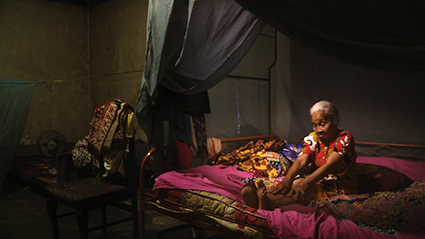
The Look of Silence
Marxist philosopher Slavoj Žižek wrote that The Act of Killing was about “the ethical deadlock of global capitalism” (New Statesman, 12 July 2013), and it is true that the key ideological aim of Suharto’s New Order was Indonesia’s integration into the global capitalist economy, a move that had long been resisted by the two biggest losers in Suharto’s takeover—Indonesia’s first president Sukarno and the Indonesian Communist Party. But Žižek’s reading lazily assumes that the economic system is primarily to blame, and as such misses the more provocative implications of Oppenheimer’s work.
The events Oppenheimer delves into—like the Khmer Rouge’s genocide in Cambodia, Mao’s Cultural Revolution, Stalin’s Great Purge and the Nazis’ Holocaust—incontrovertibly demonstrate that humankind’s capacity for cruelty is limitless, whatever our political proclivities. The fewer restraints there are on power, the more power will flirt with mass annihilation. More shockingly, Oppenheimer shows us that human subjectivity is endlessly malleable, and that with very few exceptions, people adapt to the conditions in which they live. Many can and will participate in mass murder if society tells them that slaughter is necessary. And they can and will deny all responsibility—or even involvement—when circumstances change. The Look of Silence demonstrates this many times over.
So what does this mean for possible ways of moving forward in Indonesia, and for the process of “truth and reconciliation,” such as played out in South Africa in the post-Apartheid era? Confessions of atrocity and expressions of remorse perhaps provide a degree of closure for victims and their families. But when we are so easily able to slide between torturing, raping and killing and expressing regret when circumstances demand, do public displays of contrition mean anything? Would those who enforced Apartheid have been so publicly regretful if the political winds had not shifted? Or would they have been glibly celebrating their violence in the manner of Oppenheimer’s onscreen subjects? There is certainly scant historical evidence to suggest displays of remorse forestall further abuses, as South Africa’s example attests. The Look of Silence is so unsettling precisely because it makes us face these questions and destabilises easy assumptions about the positive effects of airing repressed historical trauma.
The one certain lesson contained in both The Act of Killing and The Look of Silence is that without the restraint of law, power of any political stripe inevitably drifts towards slaughter. Power will always be able to justify itself, but once the line of arbitrary violence is crossed and endorsed, no amount of contrition will bring back the dead. Just ask Reza Berati.
–
The Look of Silence; director Joshua Oppenheimer, producer Signe Byrge Sørensen; Denmark, Indonesia, Norway, Finland, UK, 2015; Melbourne International Film Festival, 30 July–16 Aug
RealTime issue #128 Aug-Sept 2015 pg. 28
© Dan Edwards; for permission to reproduce apply to realtime@realtimearts.net
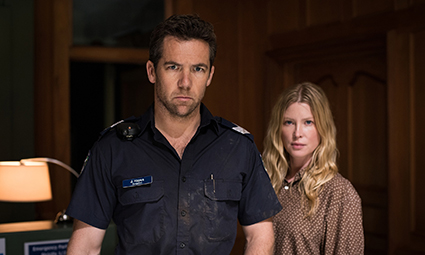
Glitch
It’s natural to wonder what a loved one who has died would make of trivial or significant changes that occur as life goes on without them. The ABC TV series Glitch makes these wonderings actual in a scenario that sees a small number of dead people returning to the Victorian country town in which they were laid to rest.
With a concept developed by executive producer Tony Ayres (Walking on Water, 2002, The Home Song Stories, 2007, The Slap, 2011) and writer-producer Louise Fox, whose resume includes popular TV series Love My Way and Round the Twist as well as the film adaptation of Christos Tsiolkas’ Dead Europe, Glitch is neither a remake of nor inspired by French series Les Revenants (2012), but external similarities between the two make comparisons unavoidable. Most obviously, there is the theme of the formerly dead returning to a small country town with every appearance of life, to the shock of those townsfolk forced to accept their miraculous restoration. The ‘returned’ in both series are unable to leave the town limits, in Glitch becoming obviously unwell if they try and ultimately disintegrating like vampires in sunlight if they do. Electric lights tend to flicker in their presence, though Glitch doesn’t use this trope as consistently as does Les Revenants. Both series contain a love triangle and a violent psychopath.
However, where Les Revenants was mysterious and surreal, Glitch is jokey and, aside from director Emma Freeman’s poetic opening titles sequence, prosaic. It’s earthier—in a very literal sense in the beginning as we observe the dead emerging from their graves, naked and grimy, in morbid mimicry of birth. From this opening, both spooky and intentionally humorous, Glitch is immediately engaging, its early scenes of the fictional town of Yoorana as atmospheric as a nightscape by Australian painter Louise Hearman.
The character who must deal with the bulk of the strange events, Sergeant James Hayes, sympathetically played by Patrick Brammall, is soon to be reunited with his recently deceased wife, Kate (Emma Booth). It is the challenge to Hayes’ integrity as decent husband and policeman, as well as the rapport between him and Kate, that anchors Glitch’s narrative. Genevieve O’Reilly lends a contrastingly cool authority to the doctor who assists James in the covert reception and care of the undead.
Elsewhere, characterisation is handled with a broader brush, despite committed performances. This is due largely to an ambitious attempt to corral multiple socio-historical aspects of Australian life into a mere six episodes, which inevitably leads to some stories feeling more trivial than others. Included are themes of Indigenous disenfranchisement, homosexual love, local prisoner-of-war camps, ANZACs, the immigrant experience, bushrangers and more. The diversity is interesting but stops short of being radical, given the central characters still reflect the straight Anglo-Australian mainstream (as a counterpoint, see the UK series In the Flesh, another drama where the lucid dead return, whose hero is presented as unremarkably gay).
Every character has a high-stakes drama attached (beyond the massive upheaval, in the case of some, of returning from the dead), but there’s not enough time to develop each of these fully. Those with more impact include the story involving Maria—a devout Italian immigrant whose miraculous return means a confrontation with grief—and the love triangle drama kicked into being by the return of James’ beloved first wife, though the confrontations caused by the latter devolve into protracted scenes bordering on triteness.
A major story thread involving a friendship struck up between the returning first mayor of Yoorana, Paddy Fitzgerald (Ned Dennehy) and local Indigenous teen Beau Cooper (Aaron McGrath) has serious underpinnings but is deliberately played for laughs. With McGrath playing a good-natured straight guy to Dennehy’s buffoon, their scenes suggest a strange blend of Banjo Patterson and the 1970s time-travelling childrens’ TV series Catweazle, in pronounced tonal contrast to all other narratives in Glitch. Stopping just short of being dissonant, this eccentricity leavens a certain soap opera-style earnestness that might otherwise threaten to dominate the show.
With the approach of the final episode, some intriguingly sinister plot ideas emerge to cast a shadow over the many relationship dramas. On a few occasions the pathos dips into genuine horror and the territory of the uncanny, particularly in relation to one character’s personality change, though unfortunately this is undermined by increasingly menacing delivery reminiscent of a pantomime villain.
But Glitch is, after all, more ripping yarn than dark psychological drama. It’s refreshing to see an Australian series for adults apply such enthusiasm to the supernatural—a genre prevalent in overseas television yet almost unheard of in our own TV productions. (Another exception, premiered at Dark MOFO and launching on Foxtel this year, will be The Kettering Incident (2015), on which Louise Fox also worked as a writer.) With its final episode closing on several cliff-hangers, Glitch should be granted the second series it requires to further explore its many narrative threads.
ABC, Matchbox Pictures, Screen Australia: Glitch, director Emma Freeman, writers Louise Fox, Kris Mrksa, Giula Sandler, cinematography Simon Chapman, ABC1 from 9 July and iview (complete series: 6 episodes)
RealTime issue #128 Aug-Sept 2015 pg. 29
© Katerina Sakkas; for permission to reproduce apply to realtime@realtimearts.net
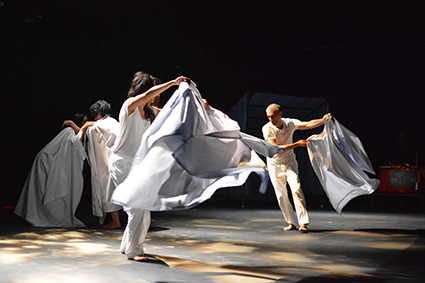
from Unappeased, Penang showing
photo Phin Oswald
from Unappeased, Penang showing
An imposing shed-like structure cleaves down its middle into two cyclonic market stalls that spin on tiny roller-wheels. These steel-framed marquees skim through space, teasing and nearly engulfing us. The crackle of their gaudy plastic tarps evokes explosive elemental forces, transporting us to a netherworld. As these wind-devils come to rest in their respective corners, there is a brief lull before the ensuing storm of images to come.
This sense of chaotic, cracking-open expansiveness belied the small space of the studio-shed we had entered. We were seated close to red cloth-covered altars at either end of the room; one functioning as the sound artist’s table, the other laid with electric tea-lights and percussive bowls. This proximity, along with the authentic marquee, evoked the sense of being in the street. A rack of hefty martial arts robes hung on the back wall. Alan Schacher welcomed us briefly, and the work-in-progress showing began with a clap of hands.
WeiZen Ho and Aida Redza donned heavy white kimono robes and dropped into a low aikido-like stance, turning into curious, comic insects. Using small brass bells to cover their eyes, the wobbly red handles serving as quivering antennae, they peered inquisitively at us. Composer Robbie Avenaim launched into an accompanying loud percussive soundscape of temple bells and found saucepans.
The next instant we were in darkness with only handheld circular cellular projections for lighting, projecting obscure images onto headless, handless white robes animated by the wandering artists. Ethereal two-headed, multi-limbed creatures seemed to emerge and disappear. Projections of tree fronds, thick beds of blood-red sea kelp and rows of scientifically identified dead birds informed and contrasted the manipulation of robes and props by the artists, enhancing Unappeased’s clear sense of the spiritual, mythical and physical.
As with Mike Leggett’s projections, the soundscape delved deeply into the mythical recesses of nature. A small automated baton tapped away, like the wind playing with a loose twig or an open door. High-pitched bells and a droning rumble built in intensity as animated robes seemed to chase their hosts. As silence descended, the performers shed their skins, leaving the robes to stand alone in sculpted clumps.
The sense of Buddhist ritual, Asian street life, ghostly spirit imagery, mythological underworld antics and wild elemental forces conveyed in the showing were fleshed out in a fascinating video-showing and a Q&A with the artists.
In 2013, Blue Mountains-based collaborators WieZen Ho and Alan Schacher performed at the Melaka Arts and Performance Festival in Malaysia, a three-day contemporary arts festival initiated by Melbourne-based dancer Tony Yap in 2009. They brought with them scored improvisations which they performed in the evenings in evocative outdoor locations such as the stone ruins of Dutch colonial buildings. In the daytime, they scouted locations and improvised in a range of public spaces.
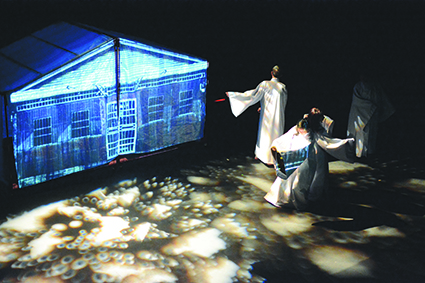
from Unappeased, Penang showing
photo Phin Oswald
from Unappeased, Penang showing
In Penang, on the same cultural exchange visit, Schacher and Ho attended the Hungry Ghost Festival, in which marquees pop up en masse to accommodate some 350 events over the month-long festival. The marquees contained a temple space on one side and space for performances of Chinese opera and pop music on the other. According to Chinese Buddhist and Taoist beliefs, the gates of Hell are thrown open and for one month the unappeased spirits of the departed wander among the community. The festival’s raison d’être is appeasement of these hungry ghosts.
The pair encountered trance mediums who enacted rituals to appease the spirits. They witnessed animistic rituals such as the drinking of blood from the necks of freshly beheaded chickens. They met genuine shamans who performed to small crowds that would assemble as ceremonies took place. It was here that the pair witnessed what felt like the ‘spirit dropping in.’
Interested in cross-cultural performance dialogues and in examining their own cultural origins (Ho’s Chinese and Schacher’s Jewish roots), a number of questions emerged which they are exploring in Unappeased, the central question to do with what it means to be unappeased in this lifetime. They are interested in the Hungry Ghost story not only as a representation of Taoist spiritual beliefs, but of the age-old human condition of insatiability that drives present day consumer culture.
Ho and Schacher are especially interested in the blurred boundaries between performance, ritual and healing arts, which are not discrete in Asia as they are in contemporary Western societies. Their Malaysian collaborator Redza brings her knowledge of pre-Islamic rituals (like the Malay horse trance dance) suppressed during the Chinese Cultural Revolution, but which survive and thrive in Penang. The artists’ dialogues with Chinese-Malay Taoists have been positive and fruitful for translating ritual material into contemporary performance. Even so, Ho reveals her cautious, respectful awe of these cultural practices when she wonders about the deeper powers of the material they are dealing with.
Certainly the pair are curious about what it is that ‘makes the spirit drop,’ and they question how that feeling can be achieved within the context and pretense of contemporary performance. Schacher is clear that they are not interested in going into trance. Ho stays open to the idea, noting that while it’s not something one can control, all performers tap into that possibility.
In more mundane terms, Ho says the idea of trance phases allows a consideration of how others in our cultural landscape can ‘take us over,’ and of how we are transformed by such interactions. Similarly, the pair see animistic practices as opening up ways of looking at how ‘the other’ is taken into oneself and what is ‘alive’ within oneself.
Each element of Unappeased—movement, lighting, sound, set, architecture, props and costume—interacts with the others to make the intangible tangible yet slips the seemingly known physical world into uncertainty. As Schacher and Ho bring their individual beliefs, cultural heritage and creative practice to bear on a work dealing with specific beliefs and practices, suspension of disbelief becomes a crucial element.
Theatre, like any ritual, relies on our willingness to make-believe, to dive in. What audiences might glean from experiencing their work is ultimately not the concern of these artists. As Schacher notes, their role is to create the conditions that will allow the audience to enter the work. At this stage of development, Unappeased certainly looks set to deliver an engaging and immersive meditation on the continuum and polarity between spiritual and material realms.
Gravity Research Institute, Unappeased, devisors, performers, collaborators WeiZen Ho, Alan Schacher, dancer, choreographer Aida Redza, percussionist, composer Robbie Avenaim, media artist Mike Leggett; Performance 4a, Albury City Council, HotHouse Theatre Month in the Country residence, Splitters Creek, Albury, NSW, 10 July
RealTime issue #128 Aug-Sept 2015 pg. 30
© Ruby Rowat & Anne-Maree Ellis; for permission to reproduce apply to realtime@realtimearts.net

Jade Suine, (detail) Random Generator Experiment 3: who changes more rapidly, me or the packaged meat?
Arts education is a vital part of the cultural and creative industries ecosystem. In this edition we celebrate diverse innovative approaches to the making of artists in secondary and tertiary education. The sequence of images above by UNSW Art & Design student Jade Suine represent a small section of her Wiki record of the experimental thinking she pursued in a one-week intensive Experimental Arts course.
Here, we reproduce the complete version of the artwork on our cover by another UNSW Art & Design student, Broc Webster whose work was Highly Commended in the 2015 HATCHED National Graduate Show at PICA.
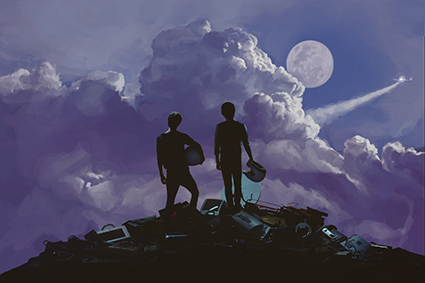
Athanasia, 2014 (detail), Broc Webster, University of NSW Art & Design, Bachelor of Fine Arts, Honours
Artists of the small to medium sector are praying that the current Senate Inquiry into the impact of the 2014 and 2015 Commonwealth Budget decisions on the Arts will deliver salvation, ie enough pressure, alongside further protest, to compel Arts Minister Senator George Brandis to reverse his decision to take $105m from the Australia Council for his own department’s National Program for Excellence in the Arts. The very title of his program is an insult to the Australia Council and all the artists it funds. Brandis has effectively reduced by an enormous 28% the funds available to the small to medium sector, putting it at risk across Australia, from cities to the suburbs, rural and remote regions where art has been burgeoning in recent years. Doubtless it will take this inquiry and more to move Brandis, but it must be done.
RealTime issue #128 Aug-Sept 2015 pg. 3
© Virginia Baxter & Keith Gallasch; for permission to reproduce apply to realtime@realtimearts.net
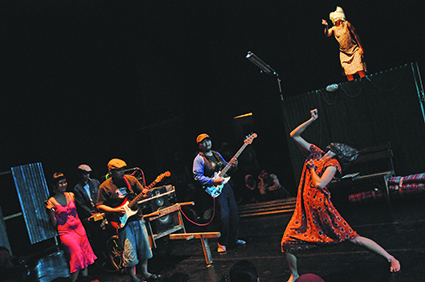
The Streets, Teater Garasi, OzAsia
photo courtesy OzAsia 2015
The Streets, Teater Garasi, OzAsia
The first thing I noticed at the launch of this year’s OzAsia Festival–the ninth since its inception by Adelaide Festival Centre CEO Douglas Gauthier in 2006–was the branding. Absent were the Chinese dragons and awkward ‘east meets west’ juxtapositions of previous festivals. In their place is a neon-style logo of lurid, downtown pink set against an imageless black void. In its lean, steely contemporariness, it’s the kind of branding that wouldn’t look out of place on a poster or press release for any major international arts festival.
This is no accident. The word “contemporary” recurs frequently throughout this year’s program, just as it peppered the speeches given at the launch by Gauthier and OzAsia Artistic Director Joseph Mitchell. Last year it was announced Mitchell would replace Jacinta Thompson as director, a role Thompson had filled for seven years, and it’s evident that Mitchell’s leadership will entail a renewed focus on work by a younger generation of Asian artists with hybrid and formally inventive practices. It’s a reinvigoration that will see a shorter but fuller festival—41 events over 11 days, as opposed to last year’s 18—and one that will extend its footprint from the Adelaide Festival Centre to the surrounding Riverbank precinct.
The Streets
Emblematic of Mitchell’s fresh approach is the program’s inclusion of The Streets, an immersive dance-theatre work by Indonesia’s highly regarded Teater Garasi and directed by founding member Yudi Ahmad Tajudin. Begun in 2007, The Streets (in Indonesian it literally means ‘crammed’ and ‘the street’) was informed by six months’ worth of interviews and field research undertaken by the company’s multidisciplinary collective of artists—actors, writers, musicians, visual artists—amid the hustle and bustle of urban hubs such as Jakarta and Yogyakarta, the culturally rich ‘Special Region’ in Java where Teater Garasi formed at Gadjah Mada University in 1993.
When I spoke with Tajudin, he told me that some of the performers lived on the street during this period of the work’s development while others recorded conversations with hawkers or established contact with homeless children. Each engaged in what Tajudin calls the ‘embodying process,’ an intense submersion in the vibrant and sometimes harsh realities of urban nightlife in Indonesia, observing the complex negotiations of class, faith and ethnicity brought to the surface by the dissolution of Suharto’s repressive New Order in 1998. “Indonesia as a society,” Tajudin says, “still has to learn how to deal with our own diversity. For 32 years we were kind of situated in this fake stability, which suppressed our diversity. Once it’s open, all these voices, all these narratives, all this ideology comes out. So now we have to deal with it, learn about it. That’s still the main issue for me in Indonesia. That’s why, with The Streets, we wanted to make such investigations.”
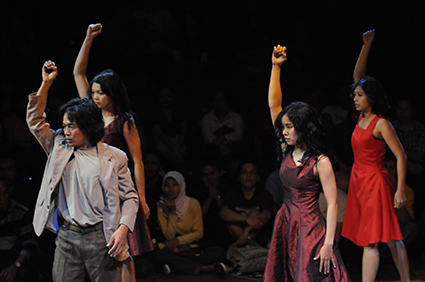
The Streets, Teater Garasi, OzAsia
photo courtesy OzAsia 2015
The Streets, Teater Garasi, OzAsia
These tensions are assayed in the work by jostling, overlapping encounters with sex workers and street sellers, Muslims and Islamists, leisured tourists and hectoring officials. Audience members, Tajudin explained, are situated experientially, given agency to choose where to sit or stand, and whether or not to move if their view becomes obstructed: “Just like in the street in Indonesia, some people occupy one area and maybe other people force them to move.” What begins as a scene of apparent chaos is woven into a tightly choreographed mosaic, the work also drawing in poetry, academic and essayistic writing and improvisations inspired by found objects such as an umbrella. When The Streets was performed in Jakarta in 2008, Tajudin had one of the performers deliver to a VIP section of the audience a monologue about a tempe (soybean cake) seller who suicides when the global price of soybeans surges. “I don’t know whether it will work here,” Tajudin mused. When he told me, intriguingly, that older, wealthier audiences in Jakarta ultimately “viewed the work as sad, but younger, lower class audiences as a celebration,” I suggested the provocatively placed monologue may have been a factor. He didn’t deny this and I saw, behind the warm, generous demeanor I have heard is not untypical of Yogyakarta artists, a flicker of a younger Tajudi—angry, wary—the political science undergrad for whom theatre provided a natural vocabulary of dissent.
Later, Tajudin will tell me that several Indonesian theatre companies met the Suharto regime’s demise with their own, unable to endure without their raison d’être–a binding antipathy towards the New Order. For Teater Garasi, the end of the Suharto era precipitated a recalibration rather than a fatal loss of purpose, a shift from a vertical perspective—David with his sling staring up at the Goliath of the state—to a horizontal one where democracy has opened up the social sphere to emergent voices, including, as Tajudin pointed out, “those voices who want the space for themselves.” During the colourful disorder with which The Streets begins, a narrator steps forward and poses what, for Tajudin and many of his fellow Indonesians, is the big question the country faces as those voices, often as unequal in their access to power and capital as they were pre-democracy, clamour to be heard: “kita mau kemana?—where are we going?”
“When we started,” Tajudin reflected as our conversation drew to a close, “I had to find a belief, the function, the role of this kind of art. So there’s this old idea that theatre is a ritual, ceremonial, so I think from the very beginning it’s about encounters. It’s about contact. It’s about how to create”—and here he pauses, scrabbling interiorly for the right word in English—“togetherness. When everybody is aware of somebody else’s presence without mediation. Especially, maybe at this time, theatre is becoming more important. That’s why I’m still doing this. We need that.”
OzAsia Festival 2015, Teater Garasi, The Streets, Space Theatre, Adelaide Festival Centre, 24-26 Sept
RealTime issue #128 Aug-Sept 2015 pg. 20
© Ben Brooker; for permission to reproduce apply to realtime@realtimearts.net
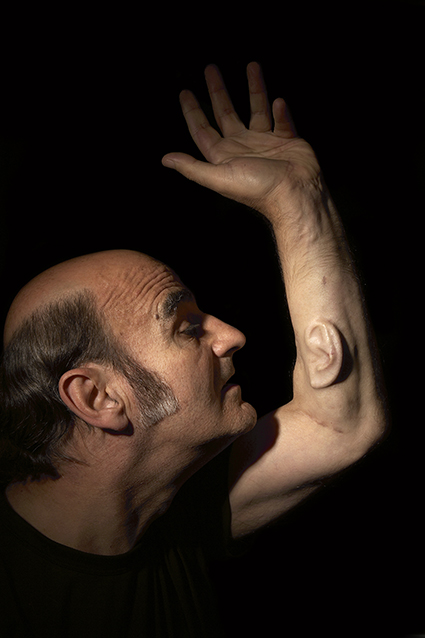
Stelarc Ear on Arm Portrait
photo Nina Sellars, 2008
Stelarc Ear on Arm Portrait
Experimentation is a rather vague notion in the arts, seen as a ‘what if’ play with form, technique, medium or all of these in a work resulting in recognisable innovation—the outcome being something not conventionally recognisable or at least difficult to label or different by degrees, small or large, from its precursors—and yielding new ways of thinking about art and life.
But this version assumes that whatever is being experimented with will always be applied and the result put on show and ‘tested’ on an audience. Instead of a laboratory where artists work away long-term at possibilities, uncertain of precisely where they’re going, this model comprises a production house with experiment-like development possibilities (staggered developmental stages, residencies, fellowships) but always with finite goals in mind. It’s the absence of open-endedness in some self-labelled experimental art that worries Oron Catts, Director of SymbioticA in the Centre of Excellence in Biological Arts, School of Anatomy and Human Biology, University of Western Australia. SymbioticA is host to the forthcoming second National Experimental Arts Forum.
Oron Catts, SymbioticA
Catts is concerned that “when a funding body gives a new title to a program [the Australia Council’s Emerging & Experimental] then everyone re-brands themselves to fit. So I’ll be interested to see who identify themselves as experimental artists so we can scrutinise what their practices are all about.” Of his own practice, based in the Life Sciences, Catts says, “The core is the experiment exploring the unknown, the question of the meaning of life. In my writing I contrast the mindsets of artists with those of engineers who usually set out to solve a specific problem and only address the issues immediately around the solution, which is not a very experimental process. The world is now led by engineering and managerial mindsets with no notion of any open-ended, curiosity-based questioning. You know the outcomes before you’ve started. Art is one of the last bastions which allows those explorations to take place.
“At SymbioticA we are problem-seekers rather than problem-solvers. We identify areas that require cultural scrutiny and which challenge our perceptions. I don’t believe that art should be in the service of anything except exploration.”
Since 2000, SymbioticA has been a leader in experimentation with in vitro meat production using tissue engineering. “As artists it’s about engaging very intimately with the other—food is a really great example because we have to incorporate it in our bodies—perhaps that’s an ‘invasive aesthetics.’ Our interest has been to raise questions about, say, how we treat other living beings. Now Google is investing millions of dollars into this area with a very false discourse about saving the world—it’s a ploy to raise funds from investors. [The project is led by computer scientist and Google co-founder Sergey Brin. Eds] We’re being exploited by becoming part of the in vitro meat narrative which was never our intention. What we do now is intervene by becoming part of the discourse around in vitro meat, being interviewed and posing subversive ideas, instead of using technology to conduct business as usual.”
For SymbioticA, the National Experimental Arts Forum (5-6 Oct) is part of a larger program, HR, which includes NEOLIFE SLSA (Society for Literature, Science and the Arts) 2015 (1-3 Oct), the first time an SLSA conference has been held outside the USA or Europe. It will address “scientists’ attempts to capture the public imagination” in respect of “forms of science on display and as a spectacle” as well as a host of legal, environmental and cultural matters.
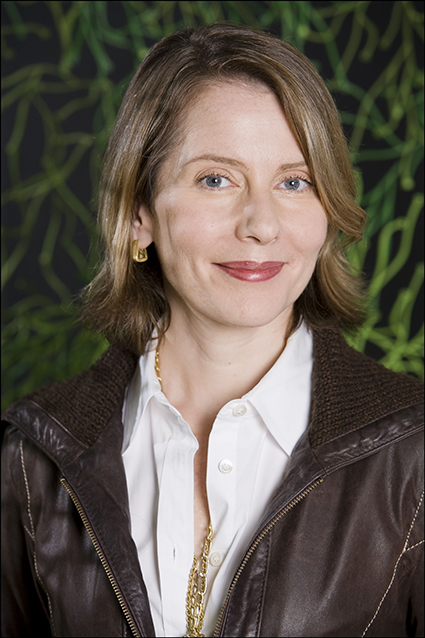
Paola Antonelli, 2008
photo Robin Holland
Paola Antonelli, 2008
HR will open on 30 September with an address by Paola Antonelli, Director of Research and Development and Senior Curator, Department of Architecture and Design, Museum of Modern Art, NY. Catts thinks Antonelli has staged some of the most interesting shows at MoMA in recent years: Design the Elastic Mind and Talk to Me: Design and the Communication between People and Object. “I asked her, in a sense, to shame artists, to show them that the world of design is filling up a vacuum, the space vacated by artists engaged in experimental practices. There is now critical design and speculative design and more and more a move towards designers producing one-off cultural objects for debate rather than any assumption of development of products. Traditionally this was the realm of the arts. I’ve asked Paola to give quite striking examples of design projects which would be more appropriately read in the context of experimental arts.
“Many of the projects she likes and was involved in come from London’s Royal College of the Arts [where she is a Senior Fellow]. It has a program called Design Interruption with designers displaying speculative projects in progress. Catts also cites a speculative art proposal by TUur Van Balen and Revital Cohen: “soap-defecating pigeons, using synthetic biology to engineer the birds’ gut biome so they can produce soap in their faeces and move away from being pests to cleaning the urban environment. Obviously this was a very cheeky proposition, a way of making us address the issue that instead of changing our own behaviour with regard to the environment we come up with absurd interventions.”
Catts thinks that “designers increasingly recognise that they are part of the problem rather than part of the solution and are moving into critical, fictional and speculative design. Those trained in this area are now starting to populate art galleries, starting with Paola at MoMA and then being embraced by more traditional art curators. It’s argued that the work communicates better than conceptual art and also that speculative design deals with very well executed models as opposed to artistic practices which are much more grounded in the reality of the materials used. I’m intimately involved in this debate.”
Catts pulls together the critical, fictional and speculative design labels into one—“contestable design,” which he associates with performance artist Stelarc and “the need to present prototypes of things which are not necessarily desirable,” as well as “a need to identify ontological holes which engineers and designers are digging for us without even recognising they are doing so…” Catts sees contestable design and experimental art doing battle with “one of the most dangerous challenges to engagement with new knowledge—TED talks, warm, fuzzy, easily digestible McKnowlege, always ending up with the positive, turning it into venture capital and unrealistic futures.”
The NEOLIFE conference’s thematic centrepiece will be the mouse with a human ‘ear’ grown without genetic engineering from cow cartilage cells on its side (University of Massachusetts Medical School, 1997). It will feature in DeMonstrable, an exhibition curated by Catts with Elizabeth Stephens and Jennifer Johung at the Lawrence Wilson Art Gallery (3 Oct-11Dec), featuring the science and the art and popular culture responses to the work.
Sunday 4 October, before the NEAF swings in to action, will be dedicated to Creative Research into New Genres—“or ‘CRINGE,’ quips Catts, “or, for George Brandis, New Genres of Excellence.” It will feature a performance by Stelarc, Guy Ben-Ary’s cellF Project, The Bio-Fiction Film Festival, Pony Express’s Eco Sex, Magnolia’s Up Late: Experimental Art Edition, new music from the UWA Faculty of Music and a National Day of Cringe soapbox session, “so that complaints about arts funding don’t invade NEAF forum sessions.” Day 1 of NEAF, says Catts, will feature keynote addresses by Stelarc, Cat Hope and the PVI collective—all Perth-based artists—panels and opportunities to whiteboard topics for Day 2 with its open discussion and breakout sessions. The venue is the Art Gallery of WA, with gallery-goers able to come across the forum. In the final session some of SymbioticA’s international guests will provide their perceptions of Australian experimental art.
David Sudmalis, Australia Council
David Sudmalis is Director of Emerging and Experimental Arts at the Australia Council which initiated and funds the NEAF. He’s also a practising composer. I asked if he sees himself as an experimental artist? “I do,” he replied, “but quite distinctly and separately from my job at the Australia Council, although there’s a body of knowledge that feeds in. Certainly my work in infrasonic sound, the sound below 20 Hz, and the involuntary physiological and psychological response to infrasonic stimuli sits at the core of my practice. I’ve been doing that for about 15 years now. It’s very much an experimental investigation and there is a body of scientific evidence undertaken internationally that can help inform it. There’s work I do in installations for gallery spaces or film soundtracks or video works that are sometimes experimental and sometimes not.”
I ask if Sudmalis thinks that science’s insistence on testing, verification and control groups can be introduced to art. He sees “a danger in being too fixed about a definition of what might constitute experimental art. For a long time, aspects of the arts and artistic practice have been linked with the sciences. If my memory serves me correctly, in the 16th century music was considered a branch of mathematics. What excites me about the breadth of practice in what we might call experimental arts is that it challenges as much the techne [making or doing, from the ancient Greek. Eds] as it does the concept and that for me is where the real challenge and vitality of the practice lies. There’s an unknown quality to the practice that is pure research in the true sense of the word. It is speculative and investigative and I think that doesn’t necessarily mean that there’s a tie to the sciences even though there sometimes and often is. What excites me a great deal is the tie-in with conceptual interrogation, the emergent issues of our time. I think that’s where great experimental practice tends to sit for the moment.”
I wonder how experimentalism fits with with production-oriented grant applications? Sudmalis says that “grant applications, strive for clarity of idea and purpose and a linear progression from concept through practice to resolution but that doesn’t necessarily lend itself particularly well to experimental practice. But what is really gratifying is that at the Australia Council there’s a commitment to peer assessment and peer review. There’s a group of eminently qualified people sitting around the table who understand the nuances and vagaries of experimental practice. So the discussions that are had with those who are professionally engaged in experimental practice tend to remediate that complexity.”
Sudmalis hopes that the National Experimental Arts Forum “will provide a profile—for government, the wider arts sector and the broader community—of the Australian vanguard of artistic practice.”
SymbioticA, National Experimental Arts Forum, Art Gallery of Western Australia, Perth, 5-6 Oct
RealTime issue #128 Aug-Sept 2015 pg. 16
© Keith Gallasch; for permission to reproduce apply to realtime@realtimearts.net
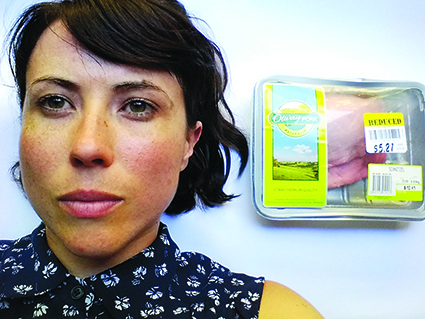
Jade Suine, (detail) Random Generator Experiment 3: who changes more rapidly, me or the packaged meat?
With the second National Experimental Arts Forum coming up, I recalled the first in 2013 at which, in discussion, Paul Thomas (Associate Professor and Program Director Fine Art Honours, UNSW Art & Design) argued for a more rigorous notion of what is meant by ‘experimental’ in the arts. He wasn’t proposing that artists adopt strict scientific methodology and controls but rather that experimental art must have the open-endedness that true experimentalism requires.
Just back from the Sound, Image and Data Conference at New York University and Harvestworks (23-25 July), the jet-lagged Thomas entertains me with a mind-bending account of quantum spin. At the conference he’d shown a multimedia work, Quantum Consciousness (made with Kevin Raxworthy), which “engages the viewer with the novel perception of being immersed within the processing of the quantum spin as analogous to human consciousness.” We’re all spinning macro-cosmically and nano-biologically.
I’m curious about how Thomas teaches students to be experimenters in the week-long, intensive course titled Experimental Arts. He says there has to be trust, respect, acceptance of failure and adaptability—pretty much what many an artist would say about how they approach their work, especially in collaborations. But Thomas qualifies these terms. ‘Respect,’ for example is about having regard for other disciplines: “If you want to explore the possibilities in physics, say, you have to be able to understand that physics has a way of describing things and you have to respect that.” That includes, he says, getting to know its language, which, in turn, becomes part of your metalanguage for experimentation.
I assume ‘trust’ for Thomas involves trusting oneself, above all, to be open to experiment—it’s not a place for preconceptions—and accepting of happenstance. He wants students to be problem finders rather than problem solvers. Problem solvers already have outcomes in mind instead of looking for possibilities. “Problem solving is just a methodological process,” he says.
Thomas sees the treatment, incubation and nurturing of ideas as fundamental. “Experimental art is very much about how to freeze the moment of inception. When an idea is germinating, you can sense that something is going on. The traditional notion of innovation as the light-bulb moment is embarrassing. We have to strip away everything, all the need to make something. Let the idea grow, let it ferment; we’re not going to put any constraints on it to be something. It can stay in idea form; it can materialise if it wants to. This is like slowing down time, freezing the moment. It’s a huge difference.”
“Allow yourself to not bring all your preconceptions with you. Allow the idea to take you on a journey and form will take shape in relationship to the idea and the materiality [materials, media etc], reinform the idea so that the two, idea and form, start working together—and you find yourself on a new trajectory.”
How does this translate into teaching practice? “Through synchronicity and serendipity,” says Thomas emphatically. He describes the approach as simple. “We start with a random generator. It’s a bit of a furphy—what is ‘random’?—but you’ve suddenly got something to think about and it also challenges students to think about what randomness is.” He cites a number of examples: number generators, numbers on successive ATM dockets, the dates of prescribed tablets missed, a selection of objects chosen by a stranger etc. The result—a word, a number, an image or multiples of these—is treated as an incipient idea and a pointer to exploratory tasks. Treat a number, say, as a goal or for determining bus stop locations to arrive at or for finding a product with the number for its price; take action and respond to the results (write, draw, make a video, do research) and see where they in turn take you in successive stages, by chance or by association; and see what happens to the idea as it takes shape.
The course is not skill-oriented: “Rather than ‘I want to learn how do video or sound or whatever, it’s about where the idea is taking me.’ Students are seamlessly working across mediums they’d never really thought of using.” That too is experimental.
Thomas turns to his computer to show me examples of students’ Wiki pages detailing processes, findings, responses, research (from surprising fields) and ideas taking shape conceptually and as draft creations. Progress is intuitive, very lateral, highly inventive and makes fascinating viewing. One student uses an electric fan to turn over the pages of a book, eventually arriving at a video of kaleidoscopic imagery of turning pages and a question to a philosophy student flatmate on video: “If I were to propose that we’d lost the wind that has turned the pages of philosophy ‘til now, what would you propose would be the propeller that would bring back the sound of a new contemplative moment?” The discussion ensues in a car with a focus on hand gestures—the video titled “the Puppetry of Philosophy.” Another student’s random generator—his date of birth and a correlating YouTube boxing video—has him attempting to engage with everyday life in boxing gloves (struggling with keys, for example) and relating it, among other things, to physiological pathologies. Thomas recalls with amusement a student’s creation from experimentation of obligatorily non-practical protective devices: a torch with a cut-out cover that flashes ‘Don’t hurt me’ and a leaf blower that inflates a bag with ‘Leave me alone’ written on it.
Thomas asks the students to pursue three different randomly generated ideas in one week, outside of the school and using whatever tools they like except, significantly, for the principal ones they usually employ. They record the progress of their experiment on their Wiki pages that can be accessed by Thomas and all the participating students. I ask why three ideas. Thomas replies gnomically, “The students realise the three are really one idea.” Inevitable synchronicity by association, I guess. He says, “the randomness starts to fall away, you’ve found something more and then you incubate it.”
![Jade Suine, Random Generator Experiment, drawing [meat package]](https://www.realtime.org.au/wp-content/uploads/art/83/8386_unpack1.jpg)
Jade Suine, Random Generator Experiment, drawing [meat package]
A vegetarian student Jade Suine randomly generated the number 521, that led to finding a $5.21 packet of pork in a supermarket and bravely proceeding to explore “mincing,” documenting on a daily basis the colour tones of the ageing meat (it got pinker) compared with her own skin, ‘desconstructing’ a pink toy by replacing the stuffing with meat and trying to grow plants in mince (with the seriousness of a bio-art experiment) and injecting dye (vein-like ‘life’) into it. “Freedom without restrictions!” says Thomas. “Not a finished product, but you’ve felt, seen, experienced it.” This student’s experiments yielded rich research and threw up fascinating possibilities and problems—artistic, scientific and cultural.
What’s exciting, says Thomas, is that the outcomes are unpredictable. A design student used randomly generated numbers to identify top-rating movies listed on IMDb; another random number took the student to a moment in each movie where he then recorded the first word spoken. This process was repeated and each individual clip was put together to add up to “a very strange narrative,” which became a possible starting point for a project, not the project itself.
Goal-oriented design students, says Thomas, sometimes find the exercise difficult because it’s not immediately perceived as being applicable to a product or their career, but the creativity involved is invaluable. “There are students from different backgrounds, culturally, age and skill-wise. I’m not teaching them skills of video or sound, for example; the students intuitively take up a multitude of mediums, innovating on what’s available for them, nor do they have to physically make anything.”
Thomas admits the course can be challenging and that he tries not to intervene too much. One student had a compass on her bicycle wheel. The spun wheel indicated which direction she should go at each point of her trajectory. Nothing grabbed her at any locations she arrived at, but looking at a photo of one, Thomas noticed the shadow from the resting handlebars pointing like a hand at chewing gum on the pavement near a bin, suggesting possibilities of an analysis of public disposal of gum, throwing trajectories (poor) and DNA sampling to determine the ‘gene pool’ of the site.
The course is intensive over a week of brainstorming and experimenting: “the amount of work sometimes outstrips that in longer courses,” says Thomas, “because that’s solely what the students are focusing on at that time. It’s worth six credits, a quarter of the value of a whole semester and you can do it in any year, as a Master’s student or coming from whatever course across UNSW that has an elective option—visual arts or design,” and there has been a student from engineering. “Students choose it because it’s not prescriptive. It frees them to develop ideas more spontaneously, whereas other courses set projects that can define outcomes.”
Drawing on Deleuze, Thomas sees the experimenter as a transdisciplinary nomad and “the university as a territory in which the student, rather than being inter- or cross-disciplinary, is above, looking down. They’ll have a vocabulary, a metalanguage, with which to engage, to be able to speak with these different disciplines, to draw from them without being obliged to totally engage. I know a bit about quantum physics and I’m not a philosopher but I’m a person inspired by things I might not fully understand. Experimentalism needs transdisciplinary delivery; not that I like the term ‘disciplinary’—I don’t like disciplines per se—but in an academic institution you have to explain what you’re doing in terms of them.” Nor is he fond of binary hybridity either—“it’s too simplistic as in ‘arts and science,’ which is too prescriptive. But make it ‘arts, science and culture or humanities,’ and that starts to bring in a whole lot of other things.”
Paul Thomas sees the Experimental Arts course as, “Fine Art leading students towards independent thinking, self-directed learning, to allow them to engage in materiality and ideas and to gradually let the ideas and material speak to the students as agents—encouraging in turn the agency of the students’ autonomy. The key is to see the world as a set of probabilities that we allow to speak to us. Nothing is neutral, everything has potential.”
I ask Thomas, “When does an experiment become art?” He replies, “A lot of work that starts as experimental becomes art when you want it to manifest as something concrete and it takes on a different form.” He points out that minor changes in an artist’s established medium and mindset might be innovative in their own terms, but they’re not experimental. It’s a big difference.
UNSW Art & Design, Paddington, Sydney
RealTime issue #128 Aug-Sept 2015 pg. 12
© Keith Gallasch; for permission to reproduce apply to realtime@realtimearts.net
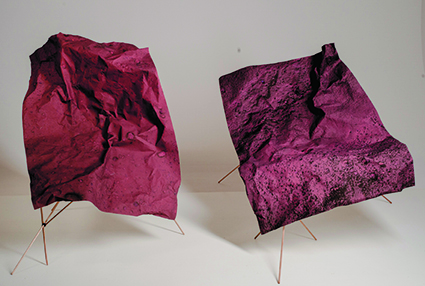
Lajamanu Souvenirs, Emmaline Zanelli, red sand from the Tanami Desert, digital print on Tyvek, mixed media sculptures made from Tyvek prints, found wood boxes, rods of Tasmanian Oak, glue, cotton and tape.
Joe Felber is a practising artist whose work includes painting, photography, video and new media art. He has exhibited internationally since 1985 in New York, Europe and Australia and has been Lecturer in Photography for six years at the Adelaide College of the Arts. When RealTime spoke with him he was about to show an installation at CACSA, titled Call for Action, with 120 posters: “I started out as a political artist 30-40 years ago and it looks like I’ve decided it’s time to embrace political action again.”
In June last year at CACSA, Felber invited a group of African immigrants living in South Australia and local actors to create a script to be performed in his installation about migration, Kontaktraum Auslander (RT122, p52). He says his interdisciplinary practice is reflected in the diversity of resources available at the Adelaide College of the Arts: “There’s a perfect relationship between Visual Arts, Performing Arts and New Media. Each one functions independently but the crossover occurs in terms of encouragement—certainly by me—to address inter-disciplinarity a lot more because, as we all know, artists today can no longer function only in one medium. In Photography, we’re a team—Gregory Ackland (Principal Lecturer, Visual Art; Studio Head, Photography and Digital Media), Will Nolan (Lecturer, Photography) and myself.”
Since 2001 Adelaide College of the Arts, part of TAFE SA, has delivered a Bachelor of Visual Arts and Design, and this year, says Felber, “we introduced a dual-award with Flinders University, the Bachelor of Creative Arts-Visual Arts. This is a fantastic new hybrid of both VET and Higher Education. Students draw on the strengths and reputations of both TAFE SA, the centre of excellence in visual arts training, and Flinders University, the leading provider of creative arts courses in South Australia to combine visual art theory and practice in a course like no other. Our students have access to all of the resources of both institutions, including our galleries and museum collections. We’re preparing them for sustainable careers in the arts by honing that balance between making and thinking.”
Felber teaches Conceptual Photography, which he sees as “relating to minimalism and earlier movements in the visual arts and addressing the conceptual rigour in the execution of the photograph. It’s divided into two parts: Studio Photography, which engages with contemporary portraiture and allows students to get a handle on the camera and the best way of using different ones—there are so many types now. Will Nolan, in his practice, loves to execute certain photographic outcomes in terms of what a particular camera can achieve. We also deal with analogue photography, introducing students to the creative processes of printing, working with collage and found objects, including making a rayogram [an image made without a camera by placing an object directly on a sheet of photosensitised paper and exposing it to light.] The aim is to liberate students from certain aesthetic expectations about what a photograph is or can do.”
So the first six months, says Felber, is about the fundamentals, dealing with documentary as well as studio-based photography where lighting allows students to experiment with the differences between the two. At the same time they are engaging with the fundamentals of drawing, painting and new media. How do they choose which medium to pursue? Felber says, “They often say they go by their personal response to the experience. Printing is very technical and some students love that and working within its limits to explore certain possibilities.”
Teaching Conceptual Photography, Felber introduces students to the evolution of photography from its beginnings to postmodernity and current practices, emphasising that it continues to have a voice. “I reinforce the concept behind the artwork, the extended process of making and thinking that allows students to become more adventurous in their work. In third year some students move away from photography and use photographic images they’ve made of an object and then ‘destroy’ it in some way so that it becomes a sculptural object.” Felber sees this as a transformative spatial relationship so that two-dimensional photography gains new dimensions, which he thinks is now important more generally in the visual and interdisciplinary arts. “Recently we’ve introduced installation into the curriculum. I used to have it in my photography class as an elective which invited painters and sculptors, photographers or printmakers to expand their mediums.” The outcome will be a three-day installation exhibition in the college for assessment and public viewing.
Reflecting on the challenges for students, Felber says, “there’s a struggle involved in learning conceptual thinking and I’m very frank about that. There’s a real art in teaching conceptual photography. I grew up with it in Europe and I struggled with it myself as a young man. So I introduce each concept with an example of practice. For instance, if I’m teaching about postmodernity and appropriation I use Jeff Wall’s idea of borrowing imagery from elsewhere and translating it into a different outcome. Then as the students practice it, it starts to sink in and you see a better understanding emerging.
“Recently with second year students we looked at the history of the Grid and did a phenomenally good exercise—they had to do three different approaches to the concept of the Grid—rational, improvisational and compositional. They came into contact with the whole realm of postmodernity and cross-disciplinary processes from painting to sculpture to… They opened up, coming up with great examples in photography. One student said, ‘I’ve never been so engaged with this subject.’ And it was hard work. I asked them to keep a journal and a practice book where they showed me each week new examples and we discussed the issues. In their second year they also execute some works involving the body—for instance about body and confrontation in postmodernity—and create a work in appropriation or rather interpretation, not directly appropriating a work but adopting approaches like those of, say, Jeff Wall or Andreas Gursky.”
For their third year students propose a body of work and create it working independently, says Felber, addressing “the execution of the process as personal. I say this quite early to the students, to embrace it because anything to do with the world has to be personal. I see some amazing students in the second half of their second year [beginning to] identify themselves more through their work. Then in the third year they have to make that work. The responsibility is big. In this semester just completed, I’ve had some terrific examples where the proposal and the work in progress over the 16 weeks have just been phenomenal, a total eye-opener. It demonstrates the benefits of the first two years.”
Cross-disciplinary projects are an option in third year, says Felber, or open-ended ‘visual explorations’ where, for example, there might be “an emotional attachment to do with gender politics, feminism or whatever and students explore that territory with sculptural elements—they make objects they then photograph in the studio. The result is often very challenging. So in terms of choosing a medium, we don’t say you can’t do that. I have some third years now whom I’ve encouraged to experiment with video because the still photograph has its limits for their ideas.”
Asked about the careers of ACA graduates, Felber points to fashion and industry photography and design companies and to opportunities to move on to Honours and postgraduate studies. For example, Felber thinks that Emmaline Zanelli (see image above), “who is 21 and majoring in photography, has a very interdisciplinary approach, is full of energy and very much ready to go to Honours.” Zanelli describes her work as “exploring the conceptual boundaries of the medium by combining photography with sculpture to provoke the viewer to question the material and symbolic qualities of the image.” She is a 2015 SALA [South Australian Living Artists Festival] Award winner, receiving The Centre for Creative Photography Latent Image Award for an Emerging Artist using Photography.
Recent ACA photography graduates—Lana Adams, Lauren Playfair and Barbara Green—have gone on to complete Honours at the University of SA. Another, Ben Mclaren was selected by curator Sam Stourdzé, Director of the prestigious Musée de l’elysée in Switzerland, to exhibit at the Pingyao International Photography Festival in China in 2012. Now, says Felber, “with our partnership with Flinders University we will be able to offer further postgraduate study options for students here in South Australia.” RT
Adelaide College of the Arts Graduates Exhibition, Hill Smith Gallery, Adelaide, 13-29 Aug
RealTime issue #128 Aug-Sept 2015 pg. 12,18
© RT ; for permission to reproduce apply to realtime@realtimearts.net
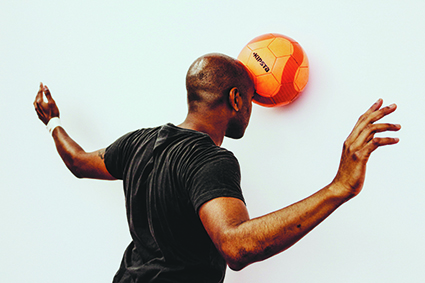
Ahilan Ratnamohan
photo Olympe Tits
Ahilan Ratnamohan
The number of performing arts-associated workshops is burgeoning, especially when associated with touring productions (see for example Nick Power’s hip hop Cypher tour). Partly it’s to do with the desire by artists to connect more expressly with audiences, partly a strategy to develop those audiences and partly the result of pressure from arts funding bodies for artists to stretch sometimes limited resources to service communities. Some artists and organisations simply love doing it: it brings them into contact with Indigenous people, refugees, prisoners and school students. Some workshops are extensive, some just a few hours, but either way artists meet new audiences, influence the ways people think about art and possibly change lives.
Ahilan Ratnamohan, maker and performer of what he titles “football dance theatre” sees his career as having two dimensions, if overlapping: his own performances and those which he calls socio-political.
After starting out with Sydney’s Urban Theatre Projects (The Football Diaries, 2009; toured to South Africa) and Branch Nebula (Sweat 2010), Ratnamohan has built a successful career in Europe. Returning to Australia, he’s currently touring SDS1, a work made in Belgium with dramaturg Kristof Persyn and reworked here with Branch Nebula’s Lee Wilson as dramaturg and Mirabelle Wouters as lighting designer.
A fascinating dimension to SDS1 is the pre-tour program of workshops with a variety of locations and participants. It’s aimed, says Ratnamohan, at “engaging with new audiences. Because it’s a work that relates to football, or soccer, there’s an opportunity to reach an audience that doesn’t usually end up in a contemporary performance venue.” Each workshop is two to three hours, “introducing the participants to some of the stuff that I use in my performance. I’ll teach abstracted football skills—not what you’d use in a match—and then depending on the skill level of the group, I’ll try to get somewhere towards choreography.” He’s conscious of attention spans and the word ‘choreography’ being potentially off-putting. “I sometimes think, I trick them into making choreography.” He recalls visiting a secondary school in Katoomba for a week and half: “by the end, the kids were making their own sequences and really enjoying it,” even though, he adds, they weren’t big soccer fans.
Soccer has its own brand of ‘poetry in motion.’ For his workshops Ratnamohan uses as a foundation “ground moves”, a street-style offshoot of soccer which started in Holland. “Instead of playing a match, guys take the ball and basically show off and almost dance with the ball. Through that, what were for me quite amazing movements with the ball started to evolve. The styles I’ve come up with are quite different from what I’ve seen from guys over there.
For workshop participants it can be quite difficult so it can take a while depending on how naturally it comes to them. A less literal example is something called ‘fast feet ladders,’ pretty much a ladder you put on the ground and you perform a sequence on it. It might be two feet on each rung or one foot in each rung and three steps on the outside—you get all these patterns. In training you do it to improve your agility and the speed of your footwork. When I started working with Branch Nebula on Sweat (2010) we first looked at that exercise to come up with some more interesting movements. They’re all quite rhythmical; they all have a count. If you look at it from another dimension it almost takes you back to the waltz or the foxtrot where the foot patterns are drawn on the floor and you can learn the dance just by following that sequence. I teach this to the kids, then I introduce some new moves where their feet start twisting in different directions. It results in a style of movement that is really quite idiosyncratic and interesting.
What kinds of people are you working with in your workshops?
The interesting thing is that the groups have been quite diverse. I was invited to run a workshop for a summer school for a week and a half and it turned out to be fairly young guys and the other half of the group were middle-aged women, who also took to it really well. With refugee kids the good thing is that there’s not much necessity for language and, as the cliché goes, you know, football is ‘the world game’.
How has your work developed and what role did West African footballers play in it?
It’s developed really well. SDS1 is my third football-dance theatre production. The Football Diaries was quite autobiographical, addressing the audience directly and taking the first steps in trying to get this idea of choreographing football moves into a show. Michael Essien I Want to Play As You (2013), which we made in Belgium, was an attempt at doing a similar thing but with an ensemble—a group of West African footballers who had migrated to Europe but hadn’t made it to stardom in the big leagues. That was a challenge developing this new form and working with a group of non-actors—although I didn’t find that a real problem because they’re professional footballers. It was also the first show I was directing and it turned out really well. I stayed in Belgium because of that show. I felt like if I stayed, there would be a better chance of pushing it. It went to Germany a couple of times; it went to the UK for LIFT in 2014.
Do you perform in it yourself?
Once in an emergency. It wasn’t my preference. The touring was quite difficult. We were dealing with players who sometimes didn’t have their documents in order. That was the subject of the piece—these illegal trips to Europe which African footballers undertake in the hope they’ll get a massive contract, and the reality of that whole thing. We had to deal with that constantly as we were touring, especially when we got to London because suddenly a lot of our main cast couldn’t come and we had to replace them with other guys who had similar stories but who were a bit further down the line and had managed to get documents.
Another issue we had to deal with was the fact that they were still aspiring footballers. I was close to cancelling a show in Belgium because the day before we were supposed to start rehearsals, I found one of the guys was in England because he’d suddenly got a trial with a club; another had gone to Spain for a trial. That was the show when I ended up performing because we were so short.
What’s different about SDS1?
When I set out I wanted something that would go much further into dance and I set myself the rule that I didn’t want to use any text in the show, for it to be pure movement. I broke the rule, not with monologues but little exchanges with the audience. I think of SDS1 as a bit of an experiment. I decided not to apply for funding. I felt more comfortable just developing it in my spare time. I was keen to involve the football dance vocabulary both with and without the ball. I really pushed myself to find new ways of moving but still derived from football.
How are you going as an artist in terms of survival in Europe?
It’s going really well for me I’m surprised to be able to say. I’ve had a few years where I’ve had to work very hard to establish myself, especially when we decided to stay in Belgium to keep working on Michael Essien… I’ve benefited from being in Europe in a number of ways. First, there’s just a multitude of opportunities there. Part of that is geographical and part of it is appreciation of culture. I’ve had the luck of finding a production house in Belgium that’s given me very strong support—the Monty Kultur Factory in Antwerp—but my choreographic work doesn’t interest them so much as my socio-political projects. I know that I have a home there if I need to get a project off the ground. And the Flemish government has also been quite good to me. It’s a bit strange actually being there and hearing all the negative stuff that’s happening in Australia. I feel in some ways a bit guilty.
You shouldn’t.
People say that but I can’t help it. For a long time now my partner and I have talked about coming back to Australia but all the signs point to staying in Europe. It just seems like it’s easier. It was always the goal to set myself up so that I could have a practice on both continents. But we’ve got two kids now so the travelling is becoming more difficult. I still haven’t worked out what the best model is.
*********************
Jiva Parthipan, the Community Cultural Officer for STARTTS—the NSW Service for the Treatment and Rehabilitation of Torture and Trauma Survivors—told RealTime that the participants in the 27-28 July Blacktown workshop with Ahilan Ratnamohan came from STARTTS’ youth sports program. Other participants came from an African youth arts group who perform a mixture of traditional and contemporary African dance at Blacktown Arts Centre. We’ll have more about STARTTS cultural program, as well as Blacktown Arts Centre, in a coming edition. RT
Mobile States, Ahilan Ratnamohan, SDS1, Arts House, Melbourne, 10-22 Aug; Vitalstatistix, Adelaide, 26-29 Aug; Blacktown Arts Centre, NSW, 2-6 Sept; Salamanca Arts Centre, Hobart, 17-19 Sept; PICA, Perth 23-26 Sept; Mandurah Performing Arts Centre, WA, 20-22 Oct; Bathurst Memorial Entertainment Centre, NSW, 20-22 Oct
RealTime issue #128 Aug-Sept 2015 pg. 10
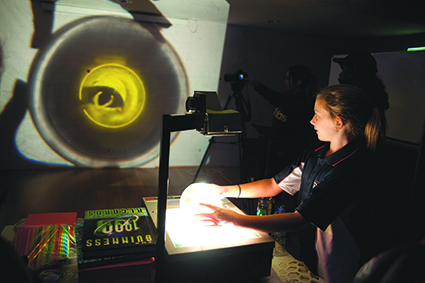
Filmmaking Workshop, Warnbro Community High School
photo Poppy van Oorde-Grainger
Filmmaking Workshop, Warnbro Community High School
In 2011 Perth Institute of Contemorary Arts’ Spark_Lab became part of a three-year research program, Growing Future Innovators, involving five schools in collaboration with Edith Cowan University’s Education School and with the support of the Fogarty Foundation. RealTime spoke with Melissa McGrath, PICA’s Education Officer and Stephen Armitstead, Head of Arts Learning Area at Warnbro Community High School, 50km south of Perth, the first to implement the research outcomes in partnership with PICA in a two-year program across 2015-17.
Involved in Spark_Lab now for just under a year, McGrath tells RealTime that she started at PICA as a gallery attendant, including undertaking education tours while studying Art History at Curtin University. “I studied to be a curator so I’m really interested in the ways you can engage audiences with work, make it relevant and stimulate a sense of agency around viewers participating in gallery spaces.” She says Spark_Lab looks at “alternative ways of teaching for leadership, independence, innovation and creative thought. The three-year trial period connected the lab with five partner schools, public and private, from a variety of districts and socio-economic backgrounds. Projects took place in schools but students also came to PICA to collaborate with artists in the gallery spaces in workshops, displaying their own work or visiting exhibitions and seeing performances. Right from the beginning, Spark_Lab’s purpose has been driven by the needs of the schools that we’re involved with and particularly by the students. The discussion we encourage with students is about the ways they think. Activities are structured for problem solving and facilitating autonomy so a lot of the activities are quite self-directed and flexible in a way that students are inspired to take them on.”
“A great example of this as a short-term project,” says McGrath, “was the three-day workshop we completed earlier this year with our partner, Warnbro Community High School. Three film and sound artists worked with groups of students over three days to write a song, record it and make an accompanying music video. Everything was up to the students: they wrote the words and decided on the images and iconography they wanted. Spark_Lab gave them a methodological structure to work within but they then held the reins. The workshop was structured so that classes ‘cycled’ through, with smaller groups working with the artists for a few hours over each of the three days so that they weren’t overwhelmed and built confidence, becoming more comfortable with creative risk and putting themselves into what they’re making.”
The video was premiered at a community launch in May at the school as well as at PICA, placed online and played on the large video screen in the Perth Cultural Centre. Taking the art made in the school with Spark_Lab to PICA and out into the world is central to the program. The participating artists were filmmaker Poppy Van Oord-Grainger, filmmaker, visual artist and project facilitator Curtis Taylor and musician and sound artist Brian Lloyd. McGrath says, “Curtis and Brian are Indigenous artists who have done projects with Indigenous communities engaging with young people in creating music, video and visual art. Poppy is a community arts worker as well. Another reason we selected Curtis as the lead artist in that particular group is that his work is quite aligned with that of Tracey Moffatt, whose work we had on show at PICA earlier in the year. All of the students who participated in the workshops at Warnbro saw her exhibition, Kaleidoscope. It wasn’t just about what they were creating but that they could align with contemporary art in a wider context. The school’s located in the south of Perth and somewhat disconnected—by pure distance—from the cultural hub of the city centre. Our opportunity is to give the students a context for what they’re creating and provide avenues to take them beyond their art classes and beyond high school.”
Warnbro Community High School’s Arts Head of Learning Area, Stephen Armitstead, teaches electronic art and is himself an occasional practising artist. He’s passionate about the Spark_Lab program. The school’s approach to the arts is an ideal fit with its Creative Arts Specialist Program (CASP) which has been running since 2009 and currently has some 80 students.
“It’s like a mini-arts school within a high school,” says Armitstead. “The current director is Joanna Sweetman who oversees the curriculum for all of the students, years 7-10. Year 7 and 8 students get to know all of the arts we offer—dance, drama, visual arts, multimedia and a little music as studio and performance practices. In years 9 and 10 they specialise, choosing between studio and performance. The program involves students in four hours of practice per week.” Armitstead says there are bonuses for CASP students: when they stage exhibitions it’s very collective. They install the work, “create media around it and really come together and value what they’re doing…and they enjoy working in the art space during lunch times and sometimes after school.”
“Critically,” says Armitstead, “Spark_Lab fills the space in the large leap into the university and the contemporary art scene from year 12. It offers us a direct connection to contemporary art and how it operates. We wanted a program that would create a portal between us and what PICA does. ‘Two places, one space,’ that was the idea behind the collaboration. It was always going to be flexible and organic. We wanted it to mirror what was happening at PICA and that it would, in turn, reflect what was happening at our school in a two-way celebration of learning about the processes of contemporary art. Their staff have been very responsive to our wishlists. It’s a true collaboration.”
Key to the program, says Armitstead, “is a series of short-term workshops and residencies across multiple disciplines and not traditional long-term artist residencies. Ahilan Ratnamohan [see page 10] is about to run a workshop at the school and later students will see him perform at Mandurah Arts Centre. Then he’ll be with us early next year and the work will be devised between his visits.
“We’re keen to work with two or three visual artists to create an interactive work with the students and document the process at the same time.” Armitstead’s keen to pursue this because he’s “noticed that galleries over the years are increasingly not simply exhibiting artists but are working through ideas with them, which is what we’d like here, with artists responding to what we’re doing at the school.”
Workshops take place at the school but also at PICA. It’s envisaged that after Year 11 exams, students will have an art workshop at the gallery one day a week over three weeks. “They’ll study works exhibited there and create their own in response, as well as to other themes. It’s a unique opportunity for students to feel that they themselves are in-residence as artists.” RT
Planners for the Spark_Lab partnership: Melissa McGrath, Laura Evans & Minaxi Ma of PICA and Joanna Sweetman and Stephen Artmitstead from Warnbro Community High School. A PDF of Growing Future Innovators by Dr Julie Robson and Dr Luke Jaaniste can be found at here, and other information at www.ecu.edu.au. For PICA’s Spark_Lab go to pica.org.au/learn/.
RealTime issue #128 Aug-Sept 2015 pg. 8
© RT ; for permission to reproduce apply to realtime@realtimearts.net
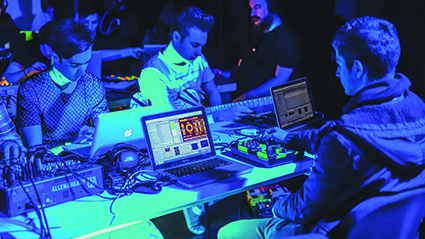
Laptop Orchestra, Electronic Music Unit, Elder Conservatorium of Music, Adelaide
photo Dr Sebastian Tomczak
Laptop Orchestra, Electronic Music Unit, Elder Conservatorium of Music, Adelaide
The 65-member Electronic Noise Orchestra (ENO) is the brainchild of the University of Adelaide’s Electronic Music Unit director, pianist and composer Stephen Whittington together with the students in the Bachelor of Music Sonic Arts program. Their inaugural concert not only paid homage to Brian Eno, it was an exercise that tested whether such a large ensemble of laptop musicians could produce a coherent and persuasive musical performance. They succeeded admirably.
The Sonic Arts students were not entirely new to text-inspired performance, many having participated in the 2014 performance of Stockhausen’s Aus den sieben Tagen (see RT122, p50) and of work by Pauline Oliveros.
In the first half of ENO plays Eno, the musicians drew for their inspiration on Oblique Strategies (1975) by Eno and Peter Schmidt, a series of short texts, printed on cards. The second half comprised an orchestral tribute to Eno designed by Whittington, inspired by a combination of Cornelius Cardew’s Great Learning Pt.2 (structurally) and Eno’s various ambient recordings (for the material). The resulting sound was characterised by dense musical layering that made full use of the eight loudspeakers placed around the perimeter of the auditorium to create a sense of swirling movement. Hearing it was an incredible experience as the complex sound patterns developed and intersected in kaleidoscopically fascinating ways. In an email exchange I asked Whittington about the significance of the concert.
Describe the background to the concert—the establishment of the laptop orchestra, the intended outcomes and the criteria for a successful musical event.
The 2014 performances involved all of the students in the class playing separately in small groups (three to six players). This (past) semester we began working on a project based on Brian Eno and it gradually grew as we developed the idea of an orchestra that involved all of the students in one ensemble. The plan involved dividing the orchestra into groups and sub-groups similar to a classical orchestra with its division into strings, woodwind, brass, percussion etc. Except, clearly, the division would be based on different principles appropriate to the medium, as it wasn’t our intention to imitate the sound of a classical orchestra—which would be pointless. Each section had its own mixer, each mixer sending signals to two master-mixers (L and R) and from there to an eight-channel speaker array. Each section was allocated a specific spatial placement in the sound system. Two students operated the master-mixers and a third person (Dan Pitman) was the conductor, responsible for conveying cues to sections (including cues about volume) as well as monitoring the master-mix and giving instructions to the two master-mixers.
So the minimum criterion for a successful performance was that it should all work and work well. For the students the outcome was an experience of working in a large group—something that classical orchestral musicians take for granted, but is very unusual in electronic music where a lot of musicians spend most of their time alone in front of a computer. The criteria for a successful musical performance are the same for this as for any other musical performance—it should be interesting to listen to, it should stimulate thoughts, ideas, emotions etc. The model for this in a musical sense is in the experimental music tradition, and in particular the Scratch Orchestra.
What instructions were given to the performers about the use of the Oblique Strategy cards? What were the guidelines for the mixers and conductor?
Each group chose two cards and worked on developing their approach to the performance around them. There was a time-bracket score for the conductor, with dynamic indications and cues. The conductor was responsible for determining the overall balance and giving instructions to the master-mixers, and if necessary making adjustments to the mix directly.
How is sonic art taught? What are the skills acquired and what are the intended outcomes? What is the relationship with conventional composition and instrumental training?
To answer a question with a question, what is ‘sonic art,’ or what are the ‘sonic arts’? The name suggests art or arts made using sound—in which case music in the usual sense is a sonic art. In the plural, it suggests that there are other arts in which sound is used which are not music (although they may involve ‘music’). Let me mention, without dwelling on it too much, that ‘using sound’ is not synonymous with making sound, or being audible.
There are works that reference sound, or the idea of sound, which do not ‘use’ sound—they perhaps belong in the realms of ‘conceptual sonic art’ (and I’m not just meaning 4’33” here). I see sonic art as a category that is larger than music—though music is a part of it—a category that embraces every kind of art activity that uses or references sound. To study sonic arts is therefore to learn about these different activities and contexts and how to create within them. Obviously a lot of those contexts today involve digital technology, although my definition of sonic arts does not require them.
Our course used to be called Music Technology but we moved away from that quite deliberately, to state a position that technology is an enabler, but the objective is ‘art’…Students are involved in studying programming in specific contexts—algorithmic computer music composition, sound design/composition for film, video, computer games. Programming is essential as a tool because it breaks dependence on commercial software, which has its uses of course, but is also limiting to the imagination. [They also study] electronics—through the medium of circuit bending and hardware hacking—studio recording and production and interactive design for sound and performance, through projects like the laptop orchestra. Every part of the course also emphasises theoretical, philosophical, aesthetic, cultural and social aspects of sound as being as important as practical skills. I could summarise the ethos of the course as one that places a high value on openness, curiosity, experimentation, inclusion, [and on] education as the development of the individual intellectually, emotionally, imaginatively.
The biggest difference between our program and ‘conventional music training’ is in the kind of student we get. A fair proportion do not have much formal musical education in playing an instrument or theory, but have been making music themselves for a number of years. So what we do has to take that into account. But having said that, we also get a significant number of students with a strong traditional music background who want to explore music in a different way, either as performers or composers or both. In other respects though it is not that different to other kinds of music education; it takes dedication and a lot of hard work to get there, with no guarantee of big rewards at the end.
What are the criteria for good sound art? What are the aesthetics?
Very tough questions. I don’t quite know where to start. For me, at least, it has to start from the raw material and our perception of it. My approach is phenomenological—my students are forced to come to grips with ideas from Husserl and Merleau-Ponty at some time or other (even though they often don’t realise that it’s happening). Webern’s definition of music as “the science of sound as it applies to human hearing” captures it to some degree. I suppose the basic criterion is the level to which these two things (sound and perception) are integrated. But that rather abstract criterion is just the beginning, as so many other factors of culture, ideas, history and emotions then come into play. I’ll have to leave it there!
The sonic arts course appears to be very popular. What is the attraction? Where do the graduates go? What is the future for electronic music and how are students being prepared for it?
We have experienced strong growth in the past three years at undergraduate and postgraduate levels (Sonic Arts can be pursued to PhD level). I’d like to think it’s because it’s such a great course, but more likely it has to do with the increased presence of sonic arts in the music and entertainment industries, the increasingly high profile of DJs and producers and other broader cultural factors. The graduates go in many different directions: as creators of music, sound artists, performers, producers, sound engineers, software and hardware developers, teachers, sound designers in the media. The field is changing very rapidly, so preparation for the future is based on adaptability, which requires understanding of principles that can be applied in changing circumstances rather than, say, learning how to use a specific software package or piece of hardware. Quite a lot of education available in this field is tied to specifics—eg learning to use ‘industry standard’ software…but we believe that approach is inherently limiting, and we want students to be free to explore the limitless realms of their sonic imagination in whatever way they choose.
ENO plays Eno, the Electronic Noise Orchestra, director Stephen Whittington, conductor Daniel Pitman, Scott Theatre, University of Adelaide, 11 June
RealTime issue #128 Aug-Sept 2015 pg. 6
© Chris Reid; for permission to reproduce apply to realtime@realtimearts.net
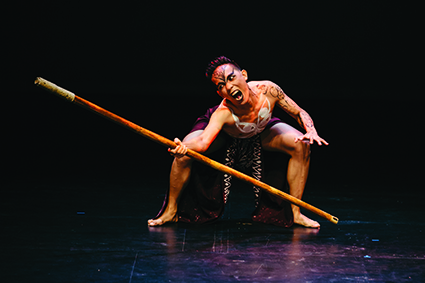
Gaspar Cortes, Site: The Ramayana Revisited
photo Crispian Chan
Gaspar Cortes, Site: The Ramayana Revisited
Today’s environment, distinguished by an active hostility from government to its constituents in the public education and arts sectors, suggests that more than ever graduating students need great resilience to survive as artists, actors and performance makers. Consequently, our concern at the University of Wollongong (UOW) is to ensure that students know not only what it means to be in a show, but what it means to make a show, to produce, promote and resource the work and put it out there in the world. This year six UOW students crowd-funded their own airfares in order to travel their production to the Asia Pacific Bureau Theatre Schools Festival and Directors Conference or APB, accompanied by Lecturer in Theatre and Performance Chris Ryan and myself.
The APB was established in 2008 under UNESCO’s International Theatre Institute with the mission of embracing diversity and sharing theatre. Key to its inception and critical for Australian interest, is the contribution of well-known Australian and Singapore-based theatre director Aubrey Mellor and Vietnamese festival director, playwright and graduate of NIDA Directors Studio Lê Quý Du’o’ng, among other founding members. The APB, whose secretariat is hosted by the Shanghai Theatre Academy, has several key objectives including: opportunities for student and staff mobility, pedagogical exchange and, critically in this instance, an annual festival for theatre schools, and an annual regional conference for the directors of theatre schools in the region.
Hosted by institutions in the region, each iteration is different according to its location. This year’s festival was held at LASALLE College of the Arts, in their fantastic facility in the heart of Singapore. An astonishing 19 performances at various stages of development and 28 workshops took place over six intensive days, representing work and training regimes from schools in Australia, Bangladesh, Brunei, China, Hong Kong, India, Indonesia, Iran, Japan, Korea, Malaysia, Mongolia, New Zealand, Philippines, Taiwan, Thailand and Vietnam. A completely immersive experience, the festival began each day with a 9am warm-up, and ended more than 12 hours later, with the final performance of the day. The hospitality was sensational, but as always, it was the informal socialising between students staying in microscopic but impeccably clean hostels in Little India that was essential to this wonderfully student-centred, participatory event.
Workshop fever
This year’s festival was focused on the body and voice of the performer, providing an opportunity to foreground the multifarious training regimes and approaches. Workshops in Meyerhold’s Biomechanics, Butoh and Suzuki training and mask-work were on offer as were hip-hop and a workshop to unleash your inner pop star, as well as martial art forms including Chinese Wushu, Malaysian Silat and Indian Kalaripayattu. Somatic practices such as Tai Chi, Alexander Technique and Feldenkreiss, acting workshops in Grotowski, Viewpoints and Meisner ran in tandem with introductions to the role of spiritualism and/or traditional vocal and movement techniques from Indonesia and India and hybrid practices from the Philippines. With so much on offer, the students were spinning like tops.
The performances
And the shows—at least three a day, each no longer than 45 minutes—were each followed by a Q&A session thoughtfully facilitated by LASALLE’s Adam Marple, through which it was possible to see many of the workshop strategies in action, coming from an astonishing range of cultural and art-form perspectives. LASALLE’s 1st year Technical Production students, thrown in at the deep end, did a great job with only three hours to bump-in and plot each work under the expert guidance of lecturer Toby Papazoglou. Some of the productions relied on incredible virtuosity and skills-based training. I really didn’t expect to see impeccably performed corporeal mime using Etienne Decroux’s methodology emerging from the Korean National University of Arts (South Korea) although the outrageous double sword fighting by students from the Mongolian State University of Arts and Culture was, weirdly, perhaps more predictable. Sadly, flaming swords were not permitted.
Contributions from Malaysia and Singapore used forum theatre to focus on issues of violence and repression. LASALLE students invested in representing attitudes to violence against women in their work, Project Ram adapted from RAM—the abduction of Sita into Darkness by South African writer/director Yael Fraber, itself a contemporary retelling of the ancient Hindu text The Ramayana. Conversely, The Sound of Silence, presented by students from the Universiti Sains Malaysia in Penang, took a highly critical look at the workings of Malaysia’s security laws and the impact on a family of a death in custody. Interestingly, students from the MSU-Iligan Institute of Technology Integrated Performing Arts Guild in Mindanao, Philippines also undertook a ‘transcreation’ of The Ramayana. Their Sita: the Ramayana revisited, was a visually and theatrically rich reworking of the epic by a wonderful ensemble of young performers distinguished by both vocal and physical dexterity and vivid characterisation. Equally physically dynamic and visually stunning was Pembayun, presented by the Indonesia Institute of the Arts in Yogyakarta, which told a traditional story with a strong focus on female warriors and women of power, unsettling many audience members’ preconceptions about the role of women in Muslim society.
Of course, Shakespeare was in the house, but as is often the case, the play was not the thing. The Shanghai Theatre Academy presented a one-man version of Richard III, while the University of Tehran’s excellent offering explored the personal lives of two performers making a movie about their rehearsal of Hamlet’s Act III, Scene IV.
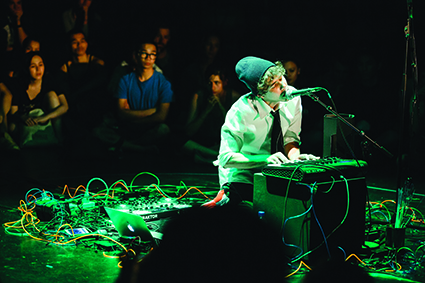
Christopher Aaronsen, Songs of an Electric Soul
photo Crispian Chan, www.crisp.com.sg
Christopher Aaronsen, Songs of an Electric Soul
Two impressive solo works were presented by Te Kura Toi Whakaari O Aotearoa: New Zealand Drama School: Gaggle—a tough, delicate, funny, creepily frightening take on femininity devised and performed by Ella Gilbert; and Perry, about an uproarious old man with no purpose in life except to make fun of himself, devised and performed by Tom Clarke. Impressive too was each performer’s ability to reflect on the importance of ‘purpose’ as understood in Maori culture, and understood as fundamental to the making of their work. Another great solo was Christopher Aronson’s Songs of an Electric Soul. A graduate of the Ateno de Manila University Theatre Arts Fine Arts program and a member of the Filipino ensemble Sipat Lawin, Aronson used electronic music via smart phones, tablets and the net to create an ecstatic shamanic persona, with the late Robin Williams as one of three spirit guides.
Two shows were set—albeit differently—in outer space. Beijing’s National Academy of Chinese Theatre Arts presented Man from the Earth, which saw Henry the astronaut arriving on the moon with “moon-landing dreams of mankind” only to unexpectedly encounter Chang’e, the goddess of the moon in Chinese mythology, and the jade hare Yu Tu. This ‘modernisation of traditional drama’ was beautifully performed and surprisingly moving. On the same day, students from Chulalongkorn University in Thailand presented 0110, the story of a lonesome star inhabiting the outer reaches of the universe, yearning for a moon to respond to her gravitational pull. In one of the few works to use digital projection, the relationship between the physical presence of the lonely star, the disembodied voice of the guardian of the universe and the scale of the projection was highly evocative.
India’s National School of Drama presented Silent Speech by four compelling dancer/actors moving from what my uneducated eye perceived to be traditional Indian movement into more contemporary forms. Melbourne’s VCA contributed a beautifully considered devised work titled Unplugged. Created by nine 2nd year performers, this work, “provoked by Chekhov, and fuelled by body, rhythm and vocal training,” was a tribute to the collaborative and generous working environment created by Rinske Ginsberg and Tony Smith. WAAPA’s intensely athletic contribution was UK playwright Philip Ridley’s Tender Napalm, co-directed by Andrew Lewis and Frances Barbe. The emphasis on Butoh and Suzuki training for the actors was evident in the virtuosic performances, and an indication of the potential of WAAPA’s new degree in performance-making. The Hong Kong Academy of Performing Arts presented an edited version of Kuo Pao-kun’s Descendants of the Eunuch Admiral directed and choreographed by Tony Wong. Using the metaphor of castration, this physically articulate ensemble animated the extraordinary story of the 15th century Muslim, Admiral Zheng He, commander of the Chinese Navy. A parallel is drawn between “the power struggles of court eunuchs and the displacement of modern Chinese who make enormous sacrifices to survive in a highly competitive and industrious society.”
From Wollongong, third year student Mark Churchill directed two short Daniel Keene plays. Both darkly intense, Duet is about two men living in a sewer while Bogeyman is about a farming couple dealing with the aftermath of a stillbirth. Watchtower presented by South Korea’s Hoseo University was a witty, sharply presented movement and sound work that imitated the fantasy logic of the computer game. Smart, cool and with a sound design that moved from darkly atmospheric to K-pop, the tension between the omniscient authority of the game and those determined by its rules played out. Darker still was the startling work from Taipei National University of the Arts. Come to Sleep is a two-hander set in an eponymously titled inn. A man with a broken leg arrives looking for somewhere to sleep. His cute, but increasingly disturbing landlady cohabits a single sleeping room filled with soft toys. They discuss a bombing from 30 years ago. By the end we understand that the soft toys represent the bodies of dead children. This impeccable production of a Japanese play apparently written in the 1960s paid tribute to the 2014 protest by Taiwan’s Sunflower Student Movement.
The liberating power of the level playing field
There’s so much more that could be said about this festival, but beyond the diversity of practice on display, what made it such a blast was the level playing field it established. Whether students came from elite training colleges or were working with the barest of resources, this event was about the calibre of the ideas, the inventiveness of their realisation, the high standard of movement and vocal skills and the intensity of creative and intellectual investment. These students work hard. The imbrication of traditional practices with contemporary concerns was arguably a determining characteristic, but the explosion of forms, concepts, themes, skills and generosity of spirit, made it a liberating, exciting and enriching event. Our students think it’s the best thing that’s ever happened to them!
The 8th Asia Pacific Bureau Theatre Schools Festival & Directors’ Conference, Body and Voice in Contemporary Performance Practices, LaSalle College of the Arts, Singapore, 6-11 June
RealTime issue #128 Aug-Sept 2015 pg. 5
© Sarah Miller; for permission to reproduce apply to realtime@realtimearts.net
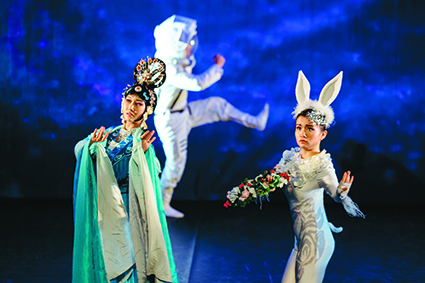
Man from Earth, National Academy of Chinese Theatre Arts (China), 8th Asia Pacific Bureau Theatre Schools Festival and Directors’ Conference, Singapore www.crispi.com.sg
photo Crispian Chan
Man from Earth, National Academy of Chinese Theatre Arts (China), 8th Asia Pacific Bureau Theatre Schools Festival and Directors’ Conference, Singapore www.crispi.com.sg
“We’re hoping that someday Rosalie will be a major player in the creative economy.”
As their young child paints just another picture of a cat, her parents deploy the language of the moment to express their ambition for their budding artist (Koren, New Yorker, 23 Feb, 2015). Arts education is facing, sometimes embracing and increasingly initiating enormous change at a time when the relevance of universities as part of mass education is being debated around the world and as the notion of work (and what will be left of it after intensive roboticisation in nearly every industry and workplace by 2030) needs radical reassessment and planning to do battle with ever increasing social and economic inequality.
Many in the arts feel uncomfortable about being reduced to players in the ‘creative economy,’ instead distinguishing between themselves as free-agent artists and those in the ‘creative industries’ whose interests appear to be strictly market-place driven. The difference is, of course, not absolute. Only a small number of arts graduates will become artists while many will practice their art in a modified fashion in health, education, hospitality and, yes, the creative industries.
In many countries around the world there is increasing investment in the creative economy (both arts and creative industries), especially in Asia. In the UK a significant report has recently been published: “The Creative Economy and the Future of Employment: Why the UK needs 1 million new creative jobs by 2030 and what the Government can do about it,” by Hasan Bakhshi and George Windsor (Nesta, 2015).
Artists in Australia have begrudgingly become used to justifying their worthiness in economic terms, but they might have to accept that the arts and the creative industries are one. As Bakhshi and Windsor write, “The Creative Economy stands out as a shining light. One of the UK’s unsung success stories, making up almost a tenth of value added, it is deeply rooted in national history and accounts for 2.6 million jobs, making it bigger than sectors like Advanced Manufacturing, Financial Services and Construction. 1.8 million of these jobs are in creative occupations from advertising professionals to computer programmers, and from actors to video games developers—who are highly educated, skilled and drivers of innovation.”
The like-minded Warwick Commission report, Enriching Britain (Warwick University), sees the cultural and creative industries sectors as one ecosystem and the UK’s Creative Industries Federation argues for including “cultural education” in that system: “It is time for the UK’s creative community to take control of its own destiny. There is an urgent need for the sector to speak with a strong, independent voice, bringing together the UK’s public arts, creative industries and cultural education”.
Meanwhile, federal Australian Government arts funding changes will diminish the role of innovation and experimentation in the arts, there is no uniform policy for the creative industries and the arts in the tertiary education sector are vulnerable to further government cuts.
For this year’s Arts Education feature we’ve departed from our usual surveys of the workings of tertiary education arts faculties, schools and departments to focus on specific examples of some fascinating developments. An exception is our coverage of the making of filmmakers where we’ve spoken with teachers in three schools, but even there our focus is solely on the education of the documentarian in a rapidly changing digitalised ‘factual’ industry, one with clear connections to the creative industries.
Sarah Miller reports on a recent major tertiary education performing arts festival in Singapore that offered students an opportunity to see themselves in an Asian context rich in training methodologies and performance types. Joe Felber at Adelaide’s College of the Arts describes the education of young photographers as the practice diversifies. PICA Education Officer Melissa McGrath and Head of Arts Learning Area Stephen Armitstead at Warnbro Community High School south of Perth tell us about the development of an innovative school-gallery relationship aimed to develop independence and innovation in students and which came out of a research study at Edith Cowan University. Stephen Whittington at the University of Adelaide directly addresses musical creativity and career prospects in the arts and the creative industries and Paul Thomas at UNSW Art & Design takes us through an intensive course in experimental thinking. It’s the kind of thinking much needed as we face enormous challenges of all kinds in and beyond arts education.
My thanks to Henry Boston for pointing me to the Nesta and Warwick Commission reports. We’ll have more on these soon. See also, Julianne Schultz, Where To From Here (SMH 13th Aug 2013).
RealTime issue #128 Aug-Sept 2015 pg. 4
© Keith Gallasch; for permission to reproduce apply to realtime@realtimearts.net
 5 Copies of Citizen Four, the breathtaking documentary about Edward Snowden (courtesy of Madman Entertainment).
5 Copies of Citizen Four, the breathtaking documentary about Edward Snowden (courtesy of Madman Entertainment). 3 copies of Fairfax film reviewer Jake Wilson’s entertaining reassessment of Philippe Mora’s Mad Dog Morgan (courtesy of Currency Press).
3 copies of Fairfax film reviewer Jake Wilson’s entertaining reassessment of Philippe Mora’s Mad Dog Morgan (courtesy of Currency Press).





















































![Jade Suine, Random Generator Experiment, drawing [meat package]](https://www.realtime.org.au/wp-content/uploads/art/83/8386_unpack1.jpg)








